LG Electronics USA Q172NYA Microwave Oven User Manual EMISSION TEST REPORT
LG Electronics USA Microwave Oven EMISSION TEST REPORT
User manual_BEJQ172NYA

Order Number
: GETEC-C1-16-108
FCC Part 18 (ISM) Certification
Test Report Number
: GETEC-E3-16-009
Page 1 / 1
EUT Type: Microwave Oven
FCC ID: BEJQ172NYA
USER MANUAL
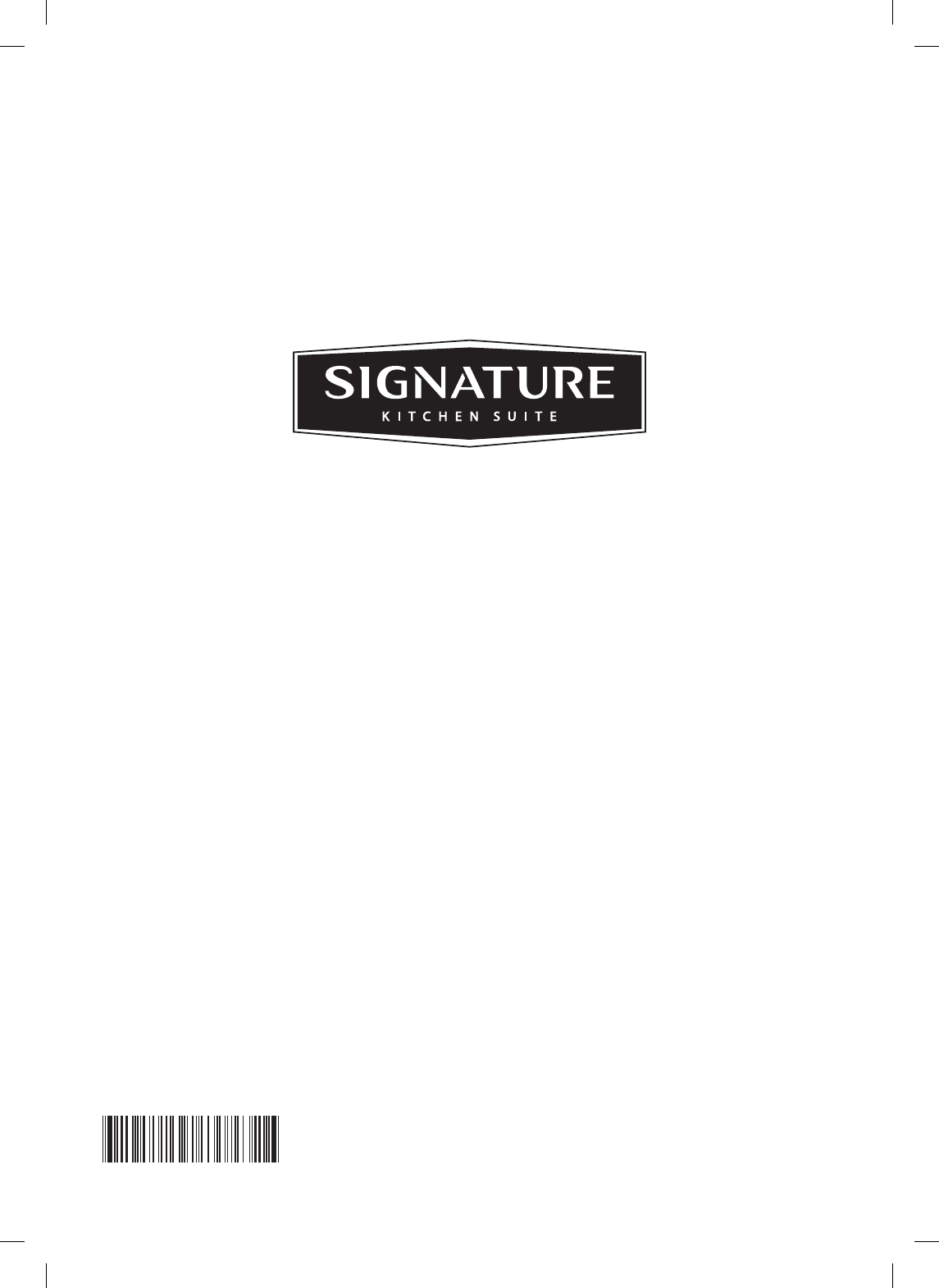
OWNER’S MANUAL
MICROWAVE OVEN
Read this owner’s manual thoroughly before operating the appliance
and keep it handy for reference at all times.
MFL68927904_00 www.thesignaturekitchen.com
UPMC3084ST

- 2 -
Thank you for purchasing an
SIGNATURE KITCHEN SUITE microwave oven.
PRECAUTIONS TO AVOID POSSIBLE
EXPOSURE TO EXCESSIVE
MICROWAVE ENERGY...
(a) Do not attempt to operate this oven
with the door open since open-door
operation can result in harmful exposure
to microwave energy. It is important
not to defeat or tamper with the safety
interlocks.
(b) Do not place any object between the
oven front face and the door or allow
soil or cleaner residue to accumulate on
sealing surfaces.
(c) Do not operate the oven if it is damaged.
It is particularly important that the oven
door closes properly and that there is no
damage to the:
(1) door (bent),
(2) hinges and latches (broken or
loosened),
(3) door seals and sealing surfaces.
(d) The oven should not be adjusted or
repaired by anyone except properly
qualied service personnel.
Please record the model number and serial
number of this unit for future reference. We also
suggest you record the details of your contact
with SIGNATURE KITCHEN SUITE concerning
this unit.
Staple your receipt here to prove your retail
purchase.
Model No:
Serial No:
Dealer:
Dealer Phone No:
Customer Relations
SIGNATURE KITCHEN SUITE U.S.A., Inc.
Service Division Bldg. #3
201 James Record Rd.
Huntsville, AL 35824-0126

- 3 -
PRECAUTIONS TO AVOID POSSIBLE
EXPOSURE TO EXCESSIVE MICROWAVE
ENERGY ...............................................................2
SAFETY INSTRUCTIONS ....................................4
PRODUCT OVERVIEW ........................................6
Location of Model Number .................................6
Oven Specications ...........................................6
Electrical Requirements .....................................6
Grounding Instructions ......................................6
Microwave Oven Features .................................7
Control Panel Features .....................................8
MICROWAVE COOKING TIPS .......................... 10
OPERATION ......................................................15
Learn About Your Microwave Oven .................. 15
Clock ................................................................15
Child Lock ........................................................15
Timer ................................................................ 16
Custom Cook ...................................................16
Vent Fan .......................................................... 16
Vent Fan Auto Time Set ...................................16
Turntable On/Off ..............................................17
Light On/Off ......................................................17
Cooking at High Power Level .......................... 17
Custom Set.......................................................17
Cooking at Lower Power Levels ......................18
Cooking With More Than One Cook Cycle ......18
Cooking Guide for Lower Power Levels ........... 19
Sensor Operating Instructions ..........................20
Sensor Cooking Guide ....................................20
Sensor Reheat ................................................20
Sensor Cook ....................................................20
Sensor Popcorn ...............................................20
Sensor Reheat Table .......................................21
Sensor Cook Table ..........................................21
Tips for Convection Cooking ........................... 22
Convection ......................................................23
Tips for Combination Cooking .......................... 24
Helpful Hints for Combination Cooking ...........24
Combination Roast ...........................................24
Auto Cook ........................................................25
Auto Cook Table ..............................................25
Soften .............................................................. 26
Soften Table .................................................... 26
Melt ..................................................................26
Melt Table ........................................................ 26
Speed Auto Combination .................................27
Speed Auto Combination Chart .......................27
Auto Defrost ....................................................28
Weight Conversion Table ................................28
Operating Tips .................................................28
Auto Defrost Table ...........................................29
Defrosting Tips ................................................31
COOKING GUIDE ............................................... 32
Convection Baking Guidelines ........................32
Meat Roasting Guidelines for Convection
Cooking ...........................................................34
Combination Roast Cooking Guide .................. 35
Combination Bake Cooking Guide ..................36
Heating/Reheating Guide ................................. 37
Fresh Vegetable Guide ....................................38
SMART FEATURES ............................................39
Before Using Smart Features ..........................39
Product Registration ........................................39
Regulation Notice for Transmitter Module
Contained in Microwave Oven ........................40
Open Source Software Notice .........................40
MAINTENANCE .................................................. 41
Caring for Your Microwave Oven .....................41
Cleaning the Grease Filters .............................42
Charcoal Filter Replacement ............................42
Oven Light Replacement ..................................43
Cooktop/Countertop Light Replacement .........43
Microwave Utensil Guide .................................44
TROUBLESHOOTING ........................................ 45
Before Calling for Service ................................45
Frequently Asked Questions ...........................45
SMART DIAGNOSIS ...........................................46
WARRANTY ............................Inside Back Cover
TABLE OF CONTENTS
Using the Application - What's Included ..........39

- 4 -
SAFETY INSTRUCTIONS
WARNING - To reduce the risk of burns,
electric shock, re, injury to persons, or exposure to
excessive microwave energy:
•
Read all the instructions before using your oven.
•
As with any appliance, close supervision is
necessary when used by children.
• Read and follow the specic PRECAUTIONS TO
AVOID POSSIBLE EXPOSURE TO
EXCESSIVE MICROWAVE ENERGY found on
page 2.
• Do not use corrosive chemicals or vapors, such as
sulde and chloride, in this appliance. This type of
oven is specically designed to heat, cook, or dry
food. It is not designed for industrial or laboratory
use.
• Do not store this appliance outdoors. Do not use
this product near water - for example, near a kitchen
sink, in a wet basement, near a swimming pool, or
similar location.
• Do not use the cavity for storage purposes. Do not
leave paper products, cooking utensils, or food in
the cavity when not in use.
• Clean Ventilating Hoods Frequently – Grease
should not be allowed to accumulate on hood
or lter.
• Use care when cleaning the vent hood lters.
Corrosive cleaning agents, such as lye-based oven
cleaners, may damage the lters.
• Do not tamper with the built-in safety switches
on the oven door. The oven has several built-in
safety switches to make sure the power is off when
the door is open.
• When aming foods under the hood, turn the fan on.
• Suitable for use above both gas and electric
cooking equipment 36 inches wide or less.
• Do not use this oven for commercial purposes.
It is made for household use only.
• When cleaning surfaces of door and oven that
come together on closing the door, use only
mild, nonabrasive soaps, or detergents applied
with a sponge or soft cloth.
• If your oven is dropped or damaged, have
it thoroughly checked by a qualied service
technician before using it again.
• To reduce the risk of re in the oven cavity:
- Do not overcook food. Carefully attend to the
microwave oven when paper, plastic or other
combustible materials are placed inside the oven
to facilitate cooking.
- Do not use the cavity for storage purposes.
Do not leave paper products, cooking utensils or
food in the cavity when not in use.
- Remove wire twist-ties from paper or plastic bags
before placing bags in oven.
• If materials inside the oven ignite:
- Keep oven door closed
- Turn the oven off
- Disconnect the power cord or shut off power
at the fuse or circuit breaker panel
• To avoid electric shock:
- This appliance must be grounded. Connect only
to a properly grounded outlet. See the electrical
GROUNDING INSTRUCTIONS on page 6.
- Do not operate this appliance if it has a
damaged cord or plug, if it is not working
properly or if it has been damaged or dropped.
- Do not immerse the electrical cord or plug in
water.
- Keep cord away from heated surfaces.
- Do not let cord hang over edge of table or
counter.
• Take care when the door is opened to avoid
injury.
The safety instructions below will tell you how to use your oven and avoid harm to yourself or
damage to your oven.
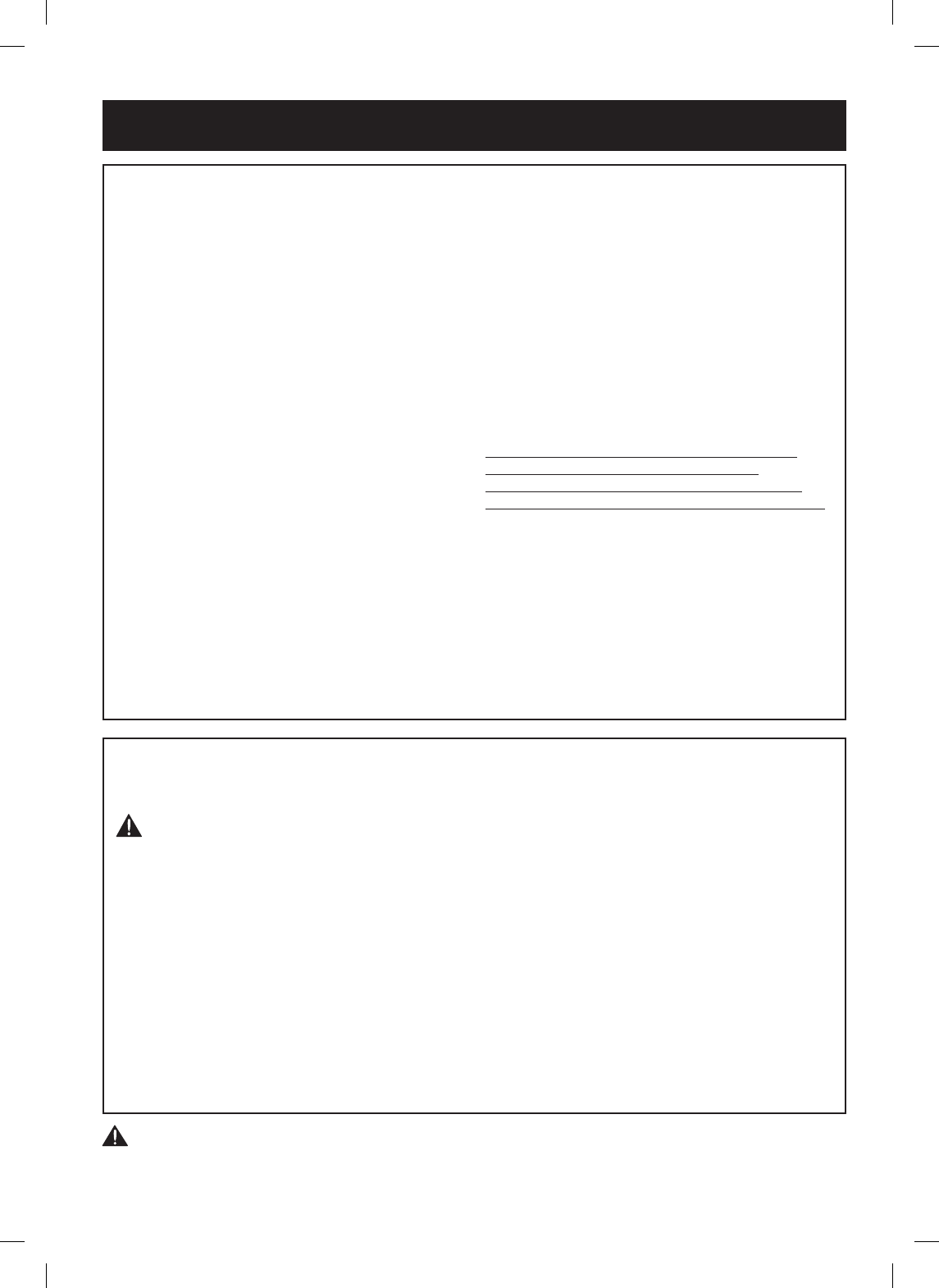
SAFETY INSTRUCTIONS
- 5 -
FEDERAL COMMUNICATIONS COMMISSION RADIO FREQUENCY
INTERFERENCE STATEMENT ( U.S.A. ONLY)
• To avoid improperly cooking some foods.
- Do not heat any types of baby bottles or baby
food. Uneven heating may occur and possibly cause
personal injury.
- Do not heat small-necked containers, such as syrup
bottles.
- Do not deep-fat fry in your microwave oven.
- Do not attempt home canning in your microwave
oven.
- Some products such as whole eggs and sealed
containers – for example, closed glass jars – are
able to explode and should not be heated in this
oven.
• Do not cover or block any openings on the appliance.
• Use this appliance only for its intended use as described
in the manual.
• Do not run the oven empty.
• Secure power cord in the cabinet above the oven.
• Preserve the oven oor:
- Do not heat the oven oor excessively.
- Do not allow the gray lm on special microwave-
cooking packages to touch the oven oor. Put the
package on a microwavable dish.
- Do not cook anything directly on the oven oor or
turntable. Use a microwavable dish.
- Keep a browning dish at least 3/16 inch above oor.
Carefully read and follow the instructions for the
browning dish. If you use a browning dish incorrectly,
you could damage the oven oor.
• Install or locate this appliance only in accordance with the
provided installation instructions.
• This appliance should be serviced only by qualied service
personnel. Contact the nearest authorized service facility
for examination, repair, or adjustment.
• Liquids, such as water, coffee, or tea can be overheated
beyond the boiling point without appearing to be boiling
due to surface tension of the liquid. Visible bubbling or
boiling when the container is removed from the microwave
oven is not always present.
THIS COULD RESULT IN VERY HOT LIQUIDS
SUDDENLY BOILING OVER WHEN THE
CONTAINER IS DISTURBED OR A SPOON OR
OTHER UTENSIL IS INSERTED INTO THE LIQUID.
To reduce the risk of injury to persons;
- Do not overheat the liquid.
- Stir the liquid both before and halfway through heating it.
- Do not use straight-sided containers with narrow necks.
- After heating, allow the container to stand in the
microwave oven for a short time before removing the
container.
- Use extreme care when inserting a spoon or other
utensil into the container.
WARNING:
This equipment generates and uses ISM frequency
energy and if not installed and used properly, that is in
strict accordance with the manufacturer's instructions,
may cause interference to radio and television
reception. It has been type tested and found to comply
with limits for ISM Equipment pursuant to part 18 of
FCC Rules, which are designed to provide reasonable
protection against such interference in a residential
installation.
However, there is no guarantee that interference will
not occur in a particular installation. If this equipment
does cause interference to radio or television reception,
which can be determined by turning the equipment
off and on, the user is encouraged to try to correct the
interference by one or more of the following:
• Reorient the receiving antenna of the radio or
television.
• Relocate the Microwave Oven with respect to the
receiver.
• Move the microwave oven away from the receiver.
• Plug the microwave oven into a different outlet so that
the microwave oven and the receiver are on different
branch circuits.
The manufacturer is not responsible for any radio or
TV interference caused by unauthorized modication
to this microwave oven. It is the responsibility of the
user to correct such interference.
WARNING: This product contains chemicals known to the State of California to cause cancer
and birth defects or other reproductive harm. Wash hands after handling.
SAVE THESE INSTRUCTIONS
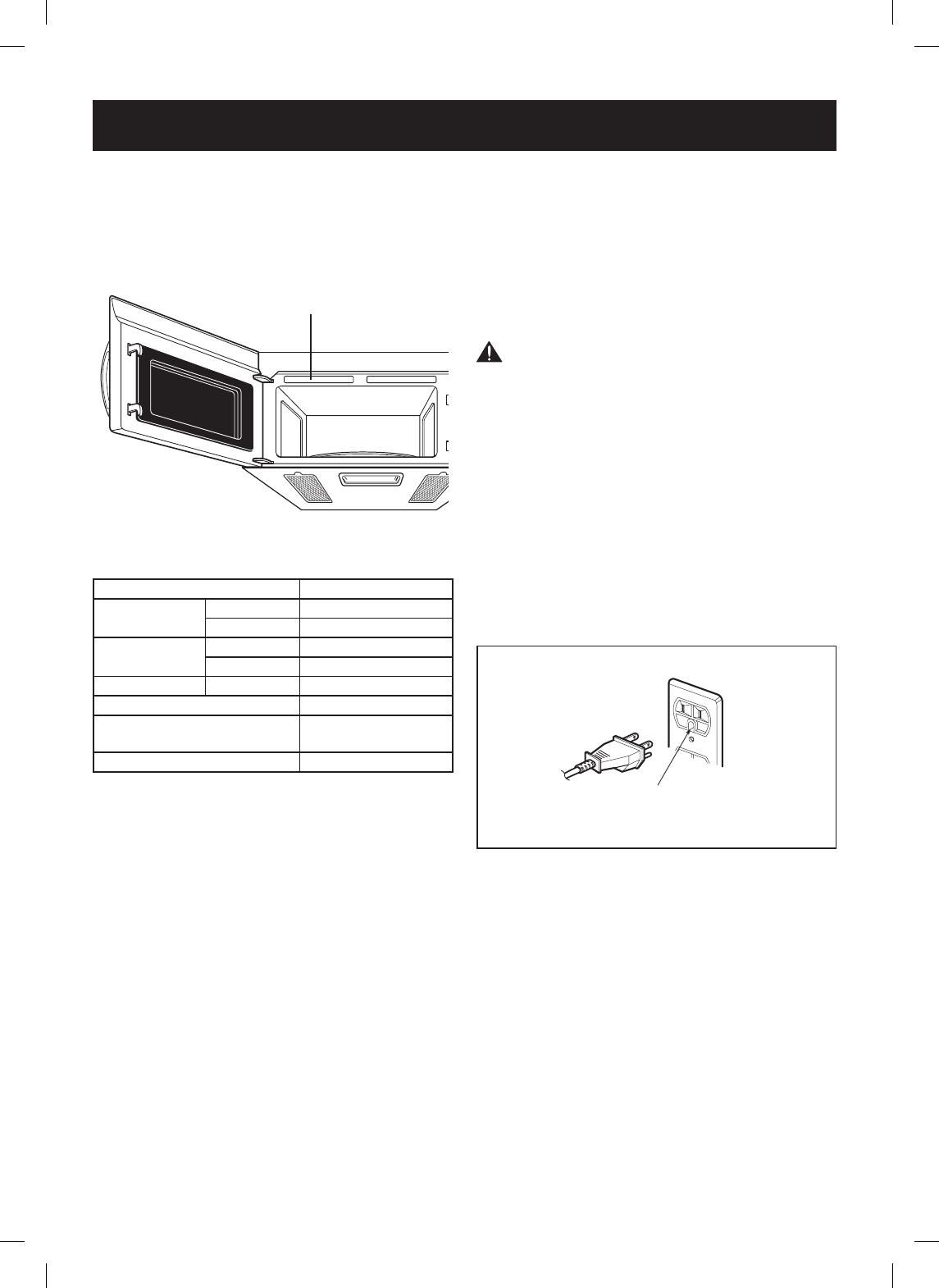
- 6 -
LOCATION OF MODEL NUMBER
To request service information or replacement parts,
the service center requires the complete model number
of your microwave oven. The model number is on the
oven front as shown in the illustration below.
MODEL NUMBER LABEL
OVEN SPECIFICATIONS
Power Supply 120 V AC, 60 Hz
Rated Current Microwave 14.0 A
Convection 14.0 A
Rated Power
Input
Microwave 1650 W
Convection 1650 W
Power Output Microwave 950 W
Overall Dimensions(WxHxD)
2915/16" x 167/16" x 15 3/8"
Oven Cavity Dimensions
(WxHxD)
211/4" x 99/16" x 143/16"
Capacity of Oven Cavity 1.7 cu.ft
ELECTRICAL REQUIREMENTS
The oven is designed to operate on a Standard
120 V/60 Hz household outlet. Be sure the circuit is at
least 15 A or 20 A and the microwave oven is the only
appliance on the circuit. It is not designed for 50 Hz or
any circuit other than a 120 V/60 Hz circuit.
GROUNDING INSTRUCTIONS
This appliance must be grounded. In the event of an
electrical short circuit, grounding reduces the risk of
electric shock by providing an escape wire for the
electric current. This appliance is equipped with a cord
having a grounding wire with a grounding plug. The
plug must be plugged into an outlet that is properly
installed and grounded.
WARNING - Improper use of the
grounding can result in a risk of electric shock.
Consult a qualied electrician or service person if the
grounding instructions are not completely understood,
or if doubt exists as to whether the appliance is
properly grounded.
Because this appliance ts under the cabinet, it has a
short power-supply cord. Do not use an extension cord.
If the power supply cord is too short, have a qualied
electrician or service person install an outlet near the
appliance. A short power supply cord is provided to
reduce the risks resulting from becoming entangled in
or tripping over a longer cord.
See the separate Installation Instructions for directions
on placing the cord properly.
Ensure proper ground
exists before use
Keep the electrical power cord dry and do not pinch or
crush it in any way.
PRODUCT OVERVIEW
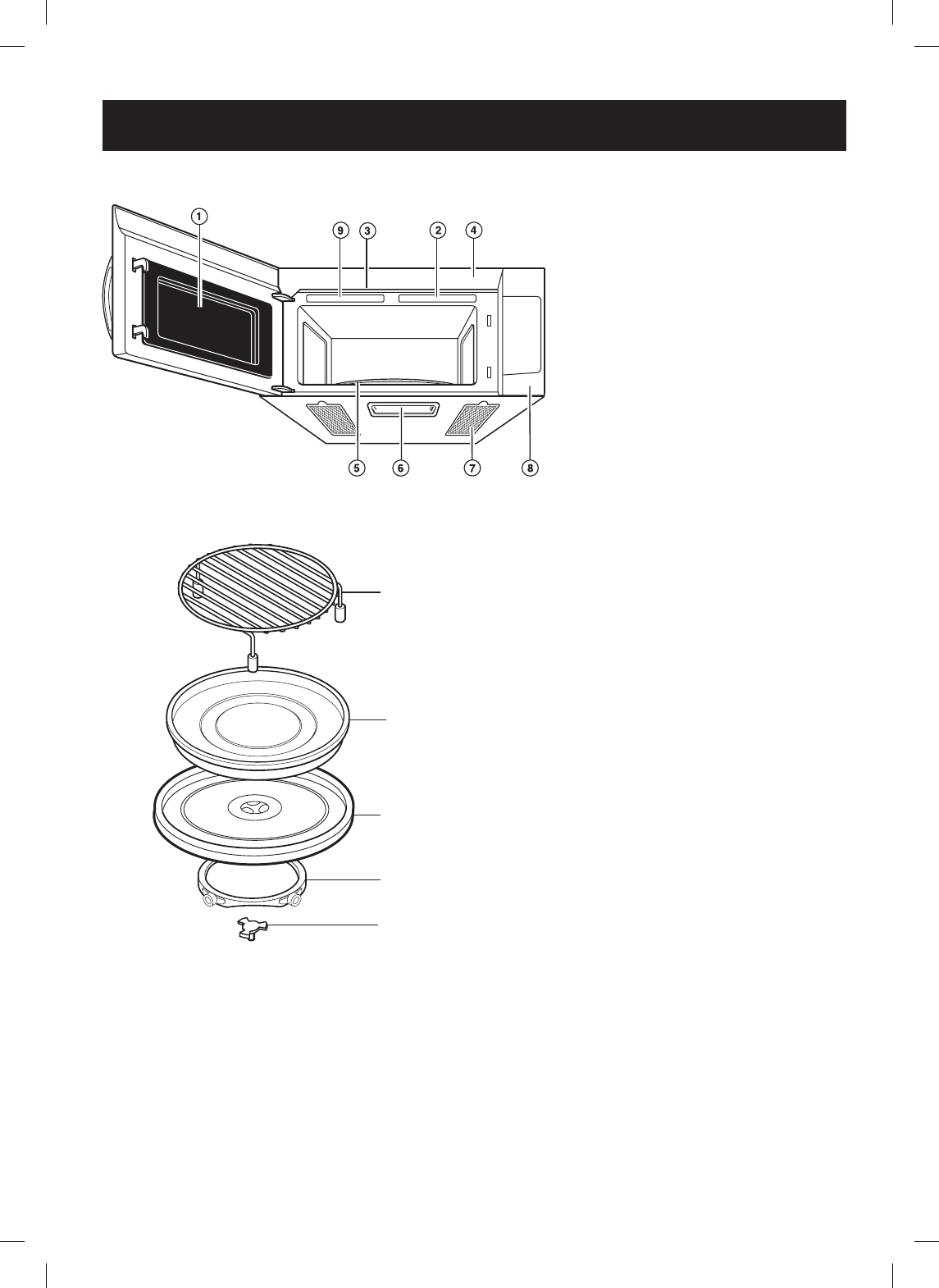
- 7 -
MICROWAVE OVEN FEATURES
PRODUCT OVERVIEW
1. Metal Shielded Window The shield
prevents microwaves from escaping.
It is designed as a screen to allow
you to view food as it cooks.
2. Cooking Guide Label
3. Charcoal Filter (Behind Vent Grille)
4. Vent Grille
5. Glass Tray The glass tray moves
food as it cooks for more even
cooking. It must be in the oven
during operation.
6. Cooktop Light
7. Grease Filter
8. Control Panel Touch the buttons on
this panel to perform all functions.
9. Model and Serial Number Plate
1
2
3
4
5
The turntable rotates in both direction to help
food cook more evenly. Do not operate the
microwave oven without the glass tray in place.
1. Convection Rack
2. Metal Tray/Drip Pan
3. Glass Tray
4. Rotating Ring
5. Shaft
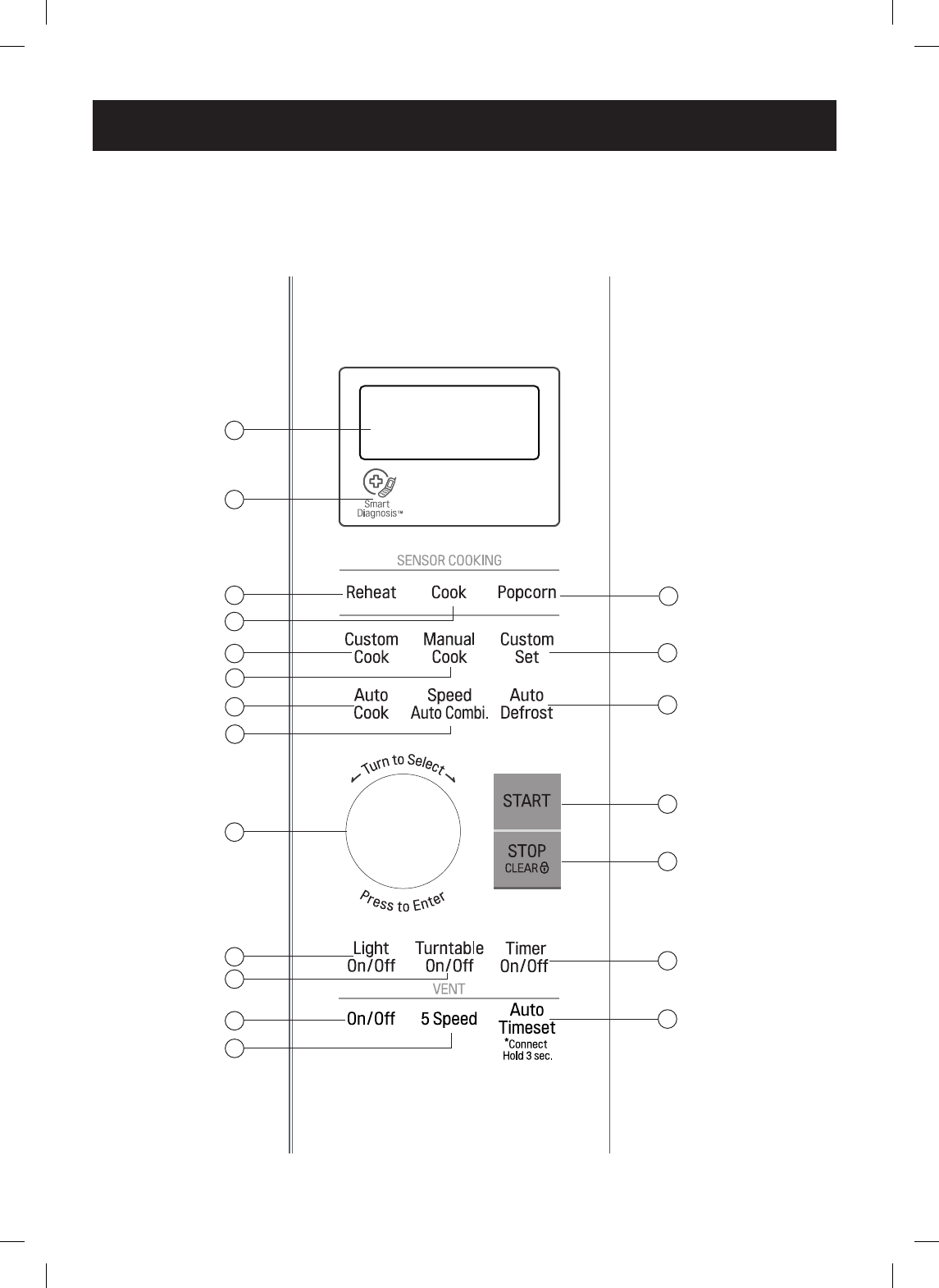
- 8 -
CONTROL PANEL FEATURES
Use the control panel to select the desired cooking function quickly and easily. Simply touch a command
key to select the desired function. For more information on these features, see the OPERATION section.
PRODUCT OVERVIEW
1
2
35
8
11
13
14
17
20
6
9
12
15
18
16
19
10
7
4

- 9 -
1. DISPLAY: The Display includes a clock and
indicators to tell you time of day, cooking time
settings, and cooking functions selected.
ICONS
2. SMART DIAGNOSIS: Hold the mouthpiece
of a phone up to this icon when directed to
by service center personnel, to help diagnose
problems with the oven when calling for
service.
COMMAND KEYS
3. SENSOR REHEAT: Touch this key to reheat
casseroles, dinner plates, pizza slices, and
soups/sauces. The oven’s sensor tells the
oven how long to cook depending on the
amount of humidity coming from the food.
4. SENSOR COOK: Touch this key to cook
baked potatoes, frozen vegetables, fresh
vegetables, canned vegetables, frozen
entrées, and rice. The oven’s sensor tells
the oven how long to cook depending on the
amount of humidity coming from the food.
5. SENSOR POPCORN: Touch this to pop
popcorn. The oven’s sensor tells the oven
how long to cook depending on the amount of
humidity it detects from the popcorn.
6. CUSTOM COOK: Touch this key to recall one
cooking instruction previously programmed
into memory.
7. MANUAL COOK: Select the functions to
operate MICROWAVE and CONVECTION,
COMBI.
8. CUSTOM SET: Touch this key to change the
oven’s default settings for sound, clock, display
speed, and defrost weight.
9. AUTO COOK: Touch this key to cook bacon,
fresh rolls and mufns, frozen rolls and
mufns, beverages, chicken pieces, and hot
cereal.
- SOFTEN: butter, ice cream, cream cheese,
or frozen juice.
- MELT: butter, chocolate, cheese, or
marshmallows.
10. SPEED AUTO COMBI: Touch this key when
setting weight combination cooking.
11. AUTO DEFROST: Touch this key to select
food type and defrost food by weight.
CONTROLS
12. CONTROL DIAL: Set cooking time,
temperature, weight and cooking categories.
Lengthen or shorten the cooking time at any
point by turning the dial(except in defrost
mode). Press on the dial to start a function or
enter all entries.
13. START: Touch the key to start a function,
accept selections, or restart after opening.
14. STOP/CLEAR: Touch this key to stop the
oven or to clear all entries.
15. LIGHT ON/OFF: Touch this key to turn the
cooktop/countertop light on or off.
16. TURNTABLE ON/OFF: Touch this key to turn
off the turntable. OFF appears in the display.
Note: This option is not available in sensor
cook and defrost modes.
17. TIMER ON/OFF: Touch this key to set the
timer.
18. VENT ON/OFF: Touch this key to turn the fan
on/off.
19. VENT 5-SPEED: Touch this key to choose
one of 5 fan speeds.
20. VENT AUTO TIMESET(*Connect Hold
3 sec.): Touch this key when setting the
ventilation time. (1, 3, 5, 10, and 30 minutes.)
Press and hold this key for 3 seconds to
connect to the network.
PRODUCT OVERVIEW

- 10 -
Amount of Food
• If you increase or decrease the amount of food you
prepare, the time it takes to cook that food will also
change. For example, if you double a recipe, add a
little more than half the original cooking time. Check
for doneness and, if necessary, add more time in
small increments.
Starting Temperature of Food
• The lower the temperature of the food being put into
the microwave oven, the longer it takes to cook. Food
at room temperature reheats more quickly than food
at refrigerator temperature.
Composition of Food
• Food with a lot of fat and sugar heats faster than
food containing a lot of water. Fat and sugar also
reach a higher temperature than water during the
cooking process.
• The more dense the food, the longer it takes to
heat. Very dense food like meat takes longer to heat
than lighter, more porous food like sponge cakes.
Size and Shape
• Smaller pieces of food cook faster than larger
pieces. Also, same-shaped pieces cook more evenly
than different-shaped pieces.
• With foods that have different thicknesses, the
thinner parts cook faster than the thicker parts Place
the thinner parts of chicken wings and legs in the
center of the dish.
Stirring and Turning Foods
• Stirring and turning foods spreads heat quickly to
the center of the dish and avoids overcooking at the
outer edges of the food.
Covering Food
Cover food to:
• reduce splattering
• shorten cooking times
• keep food moist
Releasing Pressure in Foods
• Several foods (for example: baked potatoes,
sausages, egg yolks, and some fruits) are tightly
covered by a skin or membrane. Steam can build up
under the membrane during cooking, causing the
food to burst. To relieve the pressure and to prevent
bursting, pierce these foods before cooking with a
fork, cocktail pick, or toothpick.
Using Standing Time
• Always allow food to stand either in or out of the
oven after cooking power stops. Standing time after
defrosting and cooking allows the temperature to
evenly spread throughout the food, improving the
cooking results. For inside oven standing time,
program a 0 power second stage of the cooking
cycle. See Cooking with More than One Cook Cycle.
• The length of the standing time depends on how
much food you are cooking and how dense it is.
Sometimes it can be as short as the time it takes
you to remove the food from the oven and take it
to the serving table. However, with larger, denser
food items, the standing time may be as long as 10
minutes.
Arranging Food
For best results, place food evenly on the plate. You
can do this in several ways:
• If you are cooking several items of the same food,
such as baked potatoes, place them in a ring pattern
for uniform cooking.
• When cooking foods of uneven shapes or
thickness, such as chicken breasts, place the
smaller or thinner area of the food towards the center
of the dish where it will be heated last.
• Layer thin slices of meat on top of each other.
• When you cook or reheat whole sh, score the
skin to prevent cracking.
• Do not let food or a container touch the top or sides
of the oven. This will prevent possible arcing.
MICROWAVE COOKING TIPS
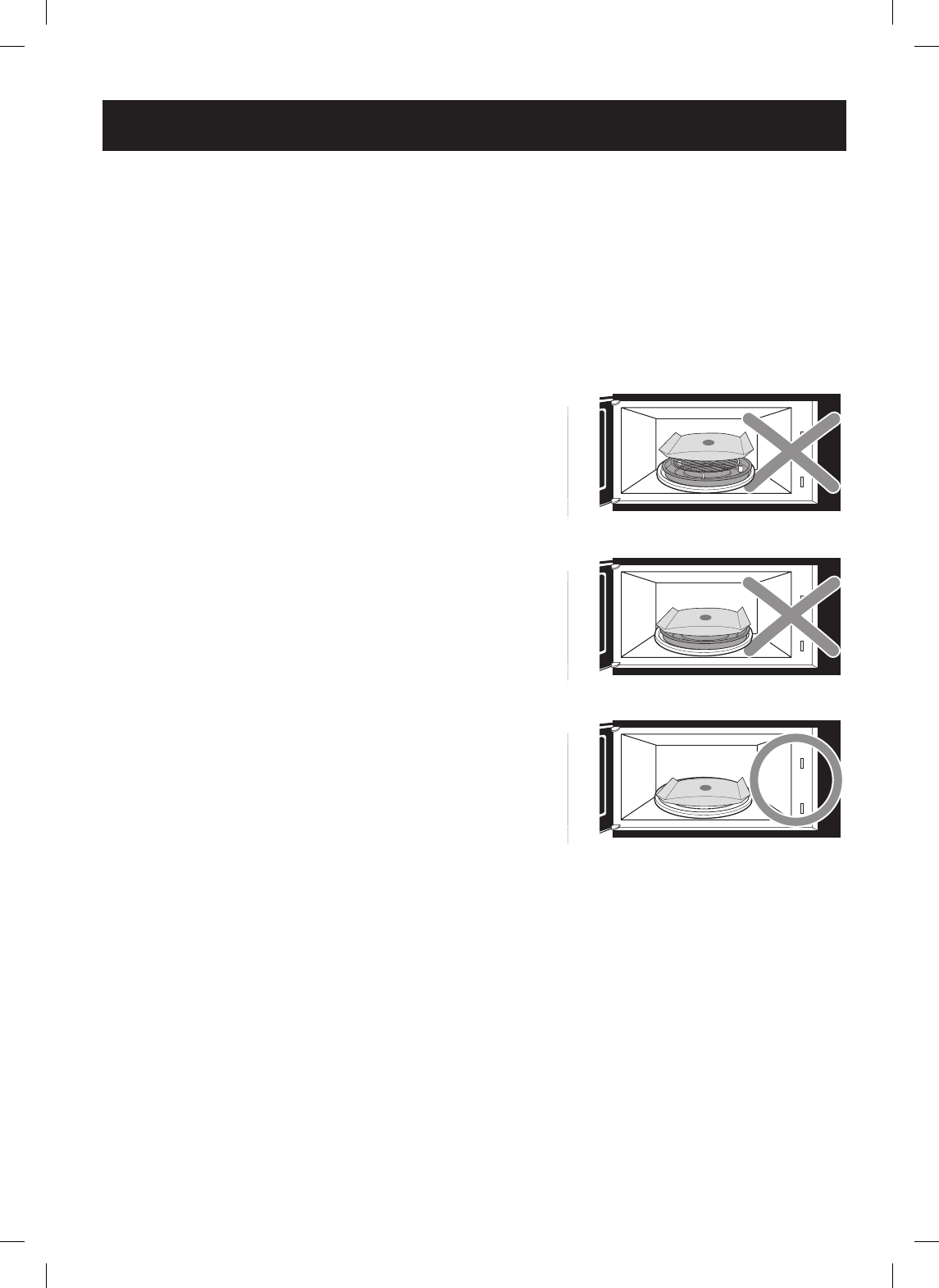
- 11 -
MICROWAVE COOKING TIPS
Using Aluminum Foil
Metal containers should not be used in a microwave
oven. However, if you have purchased food which is
prepackaged in an aluminum foil container, refer to the
instructions on the package. When using aluminum
foil containers, cooking times may be longer because
microwaves will only penetrate the exposed top of the
food and not the bottom or the sides. If using aluminum
containers without package instructions, follow these
guidelines:
• Place the aluminum foil container in a glass bowl
and add water so that it covers the bottom of the
container, but not more than ¼ in. (.64 cm) deep. This
ensures even heating of the container bottom.
• Always remove the container lid to avoid damage to
the oven.
• Use only undamaged containers.
• Do not use containers taller than ¾ in. (1.9 cm).
• Container must be at least half lled.
• To avoid arcing, there must be a minimum ¼ in.(.64
cm) between the aluminum container and the walls of
the oven and also between two aluminum containers.
• Always place the container on the turntable.
• Shield parts of food that may cook quickly, such as
wing tips and leg ends of poultry, with small pieces of
aluminum foil.
• Heating food in aluminum foil containers usually
takes up to double the time compared to reheating in
plastic, glass, china, or paper containers.
The cooking time will vary depending upon the type
of container you use.
• Let food stand for 2 to 3 minutes after heating so
that heat is spread evenly throughout the container.
Do Not Can or Sterilize in Oven
• Do not try to can food in the oven. Closed glass jars
may explode, resulting in damage to the oven.
• Do not use the microwave oven to sterilize objects
(baby bottles, etc.). It is difcult to keep the oven at
the high temperature needed for sterilization.
Removing the Rack
• When popping commercially packaged popcorn,
remove the rack and drip pan from the oven.
Do not place the bag of microwave popcorn on the
rack or under the rack. Leave the glass tray in place
at all times.
CAUTION: Popping microwave popcorn with rack
and drip pan in place can cause re or
damage to the microwave oven.
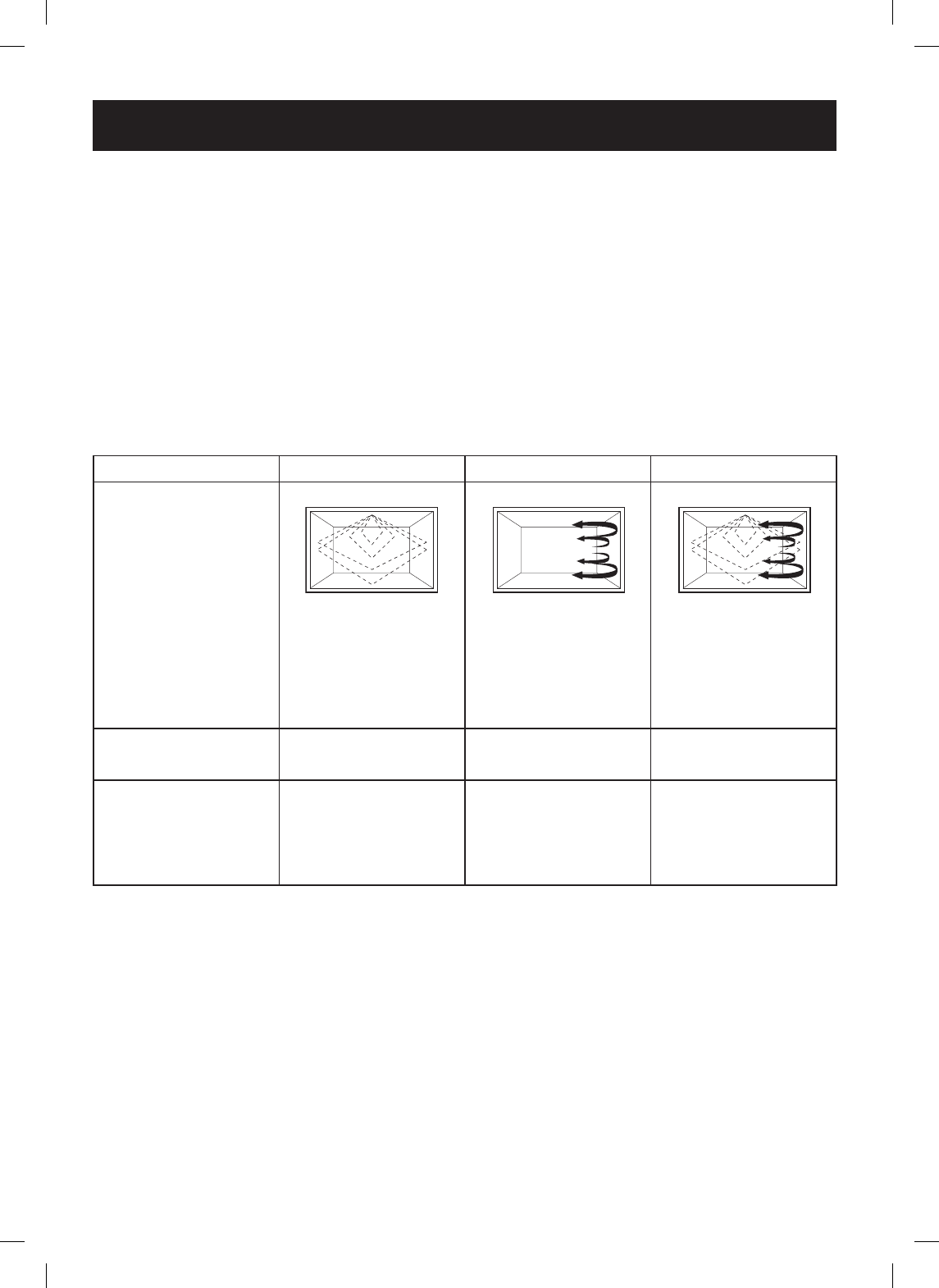
- 12 -
Cooking Comparison Guide
Cooking with your new oven offers a wide variety
of food preparation options: microwave cooking,
convection cooking, and combination cooking.
Microwave cooking uses very short, high-frequency
radio waves. The movement of the microwaves
through the food generates heat and cooks most
foods faster than regular methods, while retaining
their natural texture and moisture. Microwave cooking
heats food directly, not the cookware or the interior
of the oven. Reheating is easy and defrosting is
particularly convenient because less time is spent in
food preparation.
Convection cooking constantly circulates heated air
around the food, creating even browning and sealed-in
avor by the constant motion of hot air over the food
surfaces.
Combination cooking combines microwave energy
with convection to cook with speed and accuracy, while
browning and crisping to perfection.
Timed cooking can be set with microwave cooking,
convection cooking, and combination cooking. Preset
the desired length of cooking time and the oven turns
off automatically.
MICROWAVE COOKING TIPS
MICROWAVE CONVECTION COMBINATION
COOKING
METHOD Microwave energy is
distributed evenly
throughout the oven for
fast, thorough cooking
of food.
Hot air circulates around
food to produce browned
exteriors and sealed-in
juices.
Microwave energy and
convection heat combine
to shorten the cooking
time of regular ovens,
while browning and
sealing in juices.
HEAT SOURCE Microwave energy. Circulating heated air. Microwave energy and
circulating heated air.
BENEFITS
• Fast, high efciency
cooking.
• Oven and surroundings
do not get hot.
• Easy clean-up
• Aids in browning and
seals in avor.
• Cooks some foods
faster than regular
ovens.
• Shortened cooking time
from microwave energy.
• Browning and crisping
from convection heat.
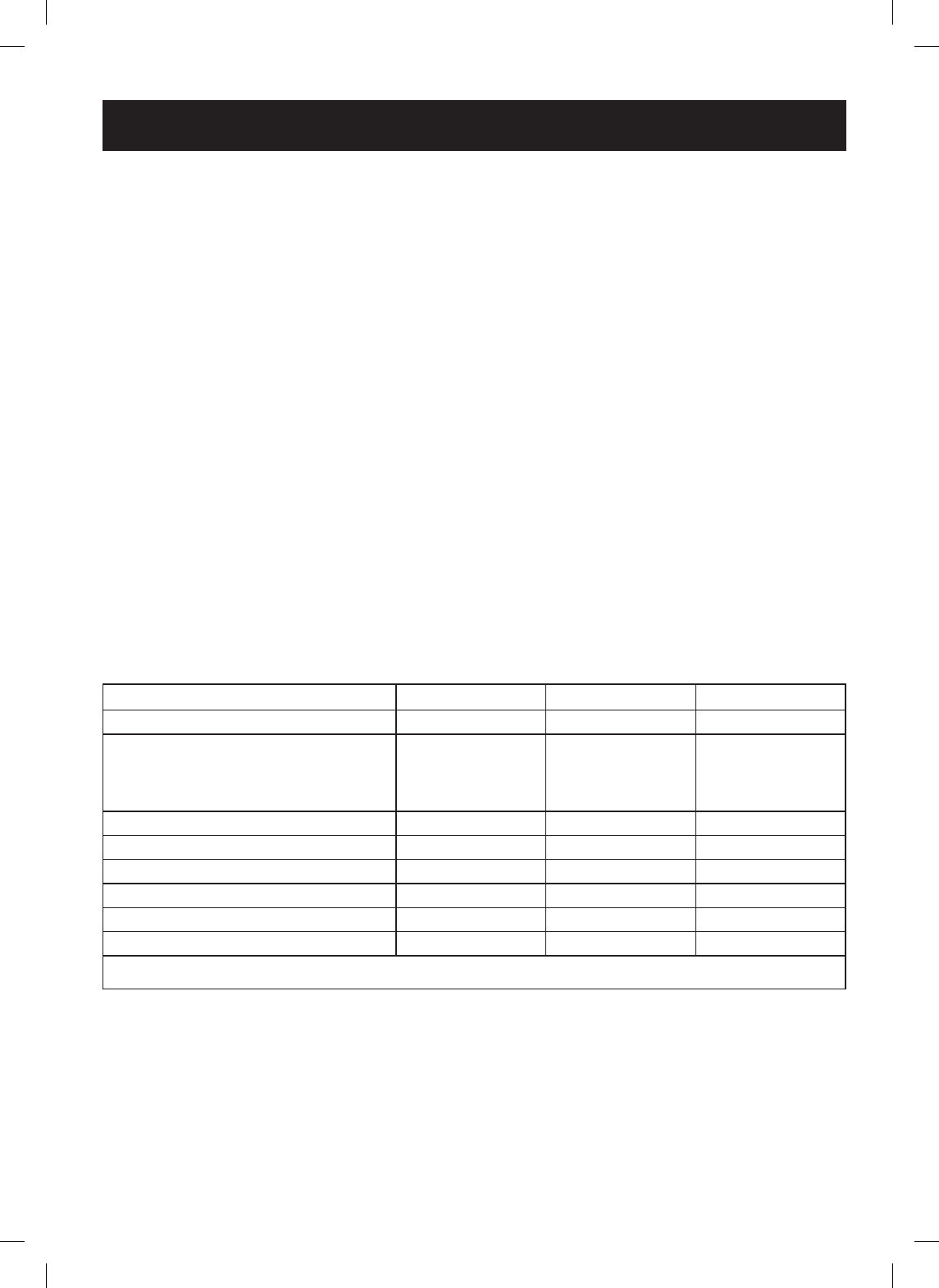
- 13 -
MICROWAVE COOKING TIPS
COOKWARE MICROWAVE CONVECTION COMBINATION
Heat-Resistant Glass, Ceramic Glass Yes Yes Yes
Ceramics, China Yes
(Do not use china
with gold or silver
trim.)
Yes Yes
Metal Cookware No Yes No
Non Heat-Resistant Glass No No No
Microwave-Safe Plastic Yes No Yes*
Plastic Wrap, Wax Paper Yes No No
Paper Products Yes No No
Straw, Wicker, and Wood Yes No No
* Use only microwave cookware that is safe to 450°F
COOKWARE GUIDE
Microwave Cooking
Most heat-resistant, non-metallic cookware is safe for
use in the microwave oven.
Testing Cookware Before Using
1. Place the empty cookware in the microwave oven.
2. Measure 1 cup of water in a glass measuring cup
and place it in the oven beside the cookware.
3. Microwave on 100% power for 1 minute. If the
dish is warm, it should not be used for microwave
cooking.
Convection Cooking
• Metal pans are recommended for all types of baked
products, but especially where browning or crusting is
important.
• Dark or dull nish metal pans are best for breads and
pies because they absorb heat and produce a crisper
crust.
• Shiny aluminum pans are better for cakes, cookies,
or mufns because these pans reect heat and help
produce a light, tender crust.
• Glass or glass-ceramic casserole or baking dishes
are best suited for egg and cheese recipes to provide
easy cleanup.
Combination Cooking
• Glass or glass-ceramic baking containers are
recommended. Do not use items with metal trim as
they may cause arcing (sparking) with oven wall or
oven shelf, damaging the cookware, the shelf, or the
oven.
• Heat-resistant plastic microwave cookware (safe to
450°F) may be used, but is not recommended for
foods that require crusting or all-around browning,
because plastic is a poor conductor of heat.
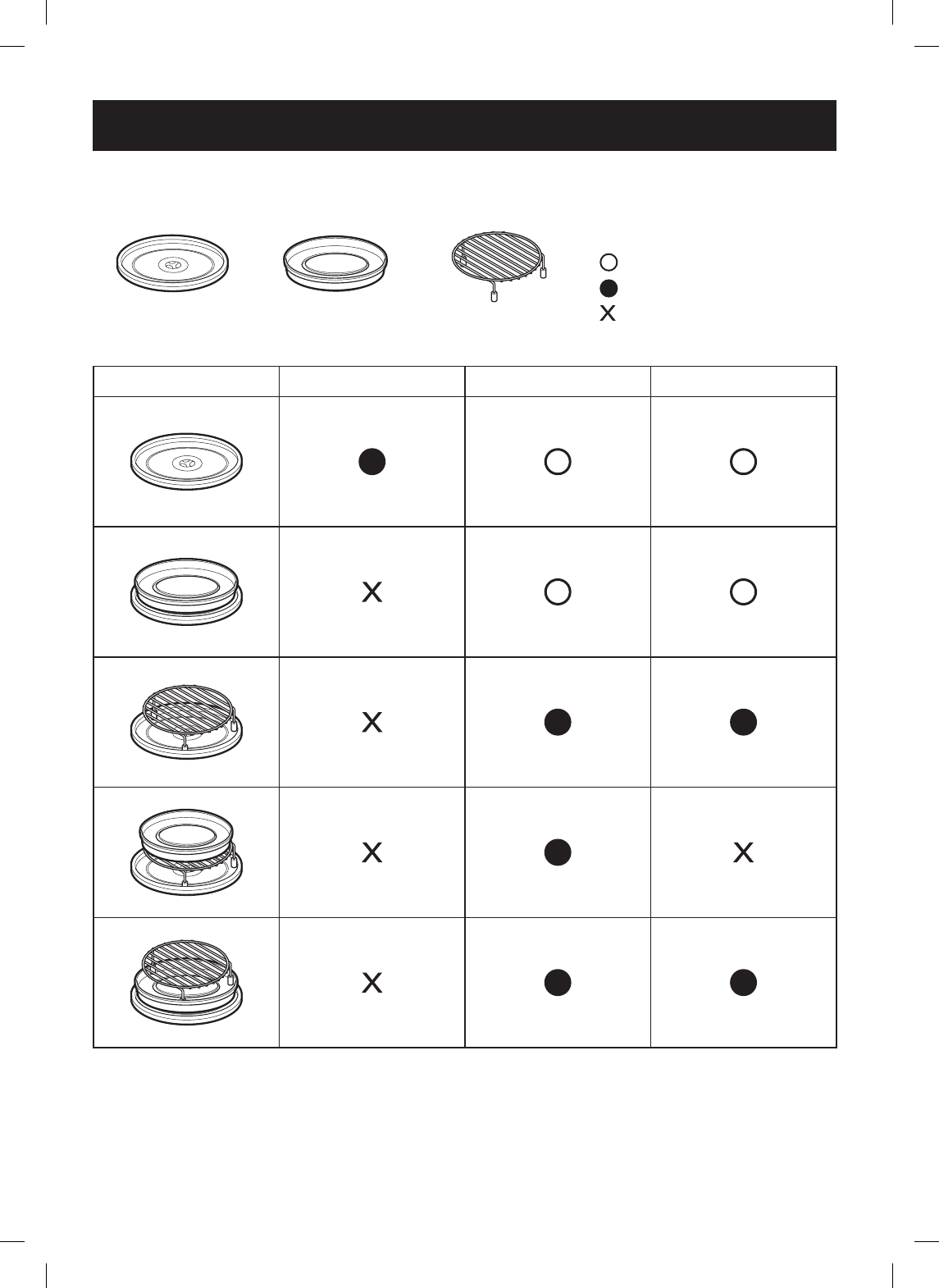
- 14 -
HOW TO USE ACCESSORIES
Glass Tray Metal Tray Metal Rack
: Possible to use
: Recommended method
: Do not use
MICROWAVE CONVECTION COMBINATION
Notes:
• Never operate the oven while empty except to preheat in convection mode.
• NEVER operate the microwave mode while the oven is empty.
MICROWAVE COOKING TIPS
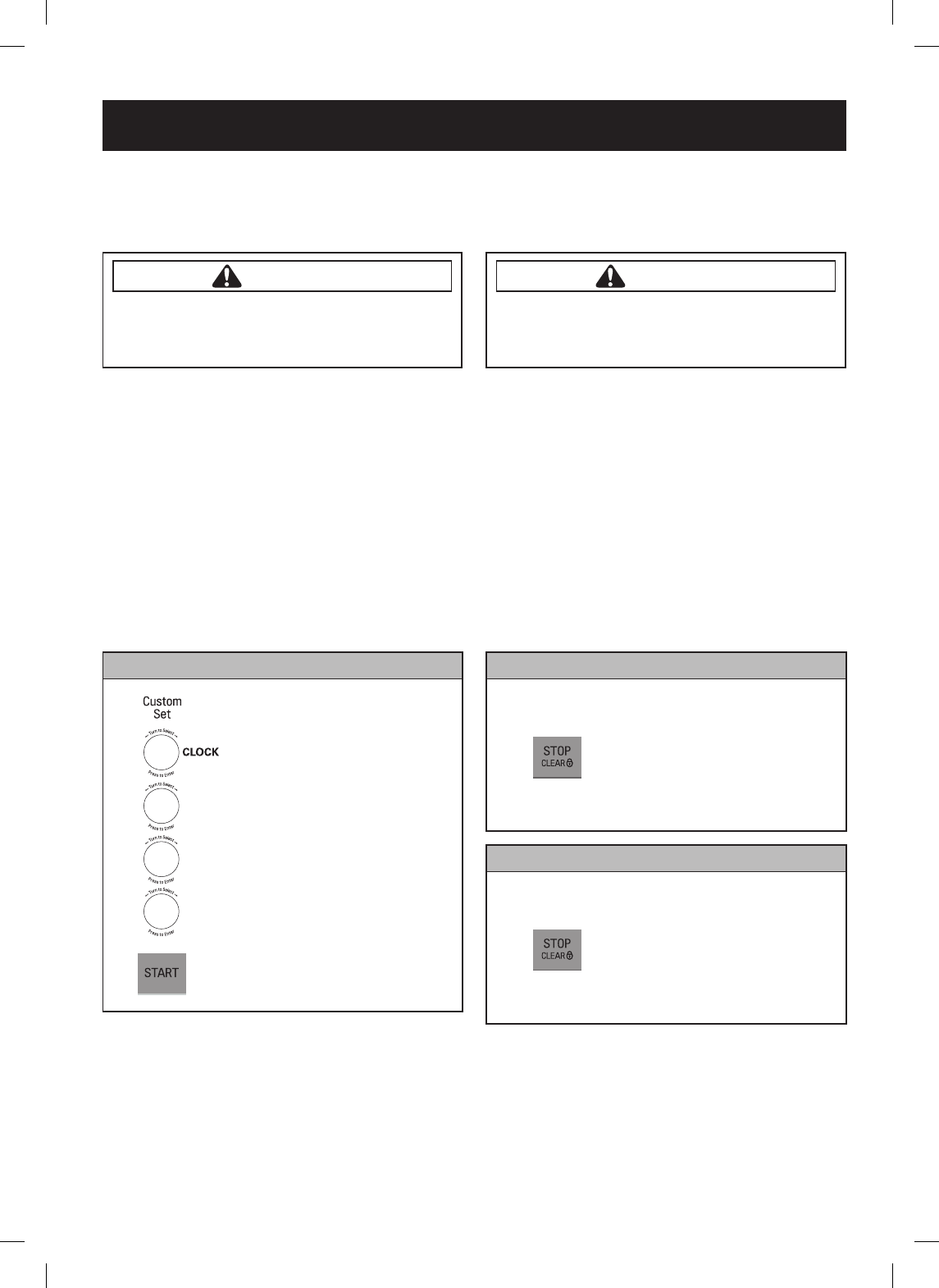
- 15 -
LEARN ABOUT YOUR MICROWAVE OVEN
This section discusses the concepts behind microwave cooking and introduces you to the basics you need to
know to operate your microwave oven. Please read this information before using your oven.
OPERATION
CAUTION
To avoid risk of personal injury or property
damage, do not use stoneware, metal utensils,
or metal trimmed utensils in the oven.
AUDIBLE SIGNALS
Audible signals are available to guide you when setting
and using your oven:
• A tone will sound each time you touch a key.
• A melody signals the end of a Timer countdown.
• A melody signals the end of a cooking cycle.
CLOCK
When your microwave oven is rst plugged in or after
a power failure, the display shows PLEASE SET TIME
OF DAY. If a time of day is not set, a colon (:) shows on
the display until CUSTOM SET is touched.
Example: To set the clock for 10:30(AM).
1. Touch CUSTOM SET.
2. Turn the dial to select the
CLOCK SET. Touch START or
press dial to enter.
3. Turn the dial to set the hour 10.
Touch START or press the dial
to enter.
4. Turn the dial to set the minute 30.
Touch START or press the dial
to enter.
5. Turn the dial to select AM or
PM.(AM)
6. Touch START or press the dial
to enter.
10
SET
30
AM
Note:
• If you touch STOP/CLEAR while setting the clock, the
display shows the last time of day set or a colon (:) if
no time of day has been set.
CAUTION
To avoid risk of personal injury
or property damage, do not run oven empty.
INTERRUPTING COOKING
Stop the oven during a cycle by opening the door. The
oven stops heating and the fan stops, but the light
stays on. To restart cooking, close the door and touch
START.
To stop cooking, open the door and touch STOP/
CLEAR.
CHILD LOCK
Use this safety feature to lock the control panel when
cleaning the oven, or so children cannot use the oven
unsupervised.
Example: To set the child lock.
1. Touch and hold
STOP/CLEAR until LOCKED
appears in the display and a
melody sounds.
(approximately 3 seconds)
Example: To set the child lock.
1. Touch and hold
STOP/CLEAR until LOCKED
appears in the display and a
melody sounds.
(approximately 3 seconds)
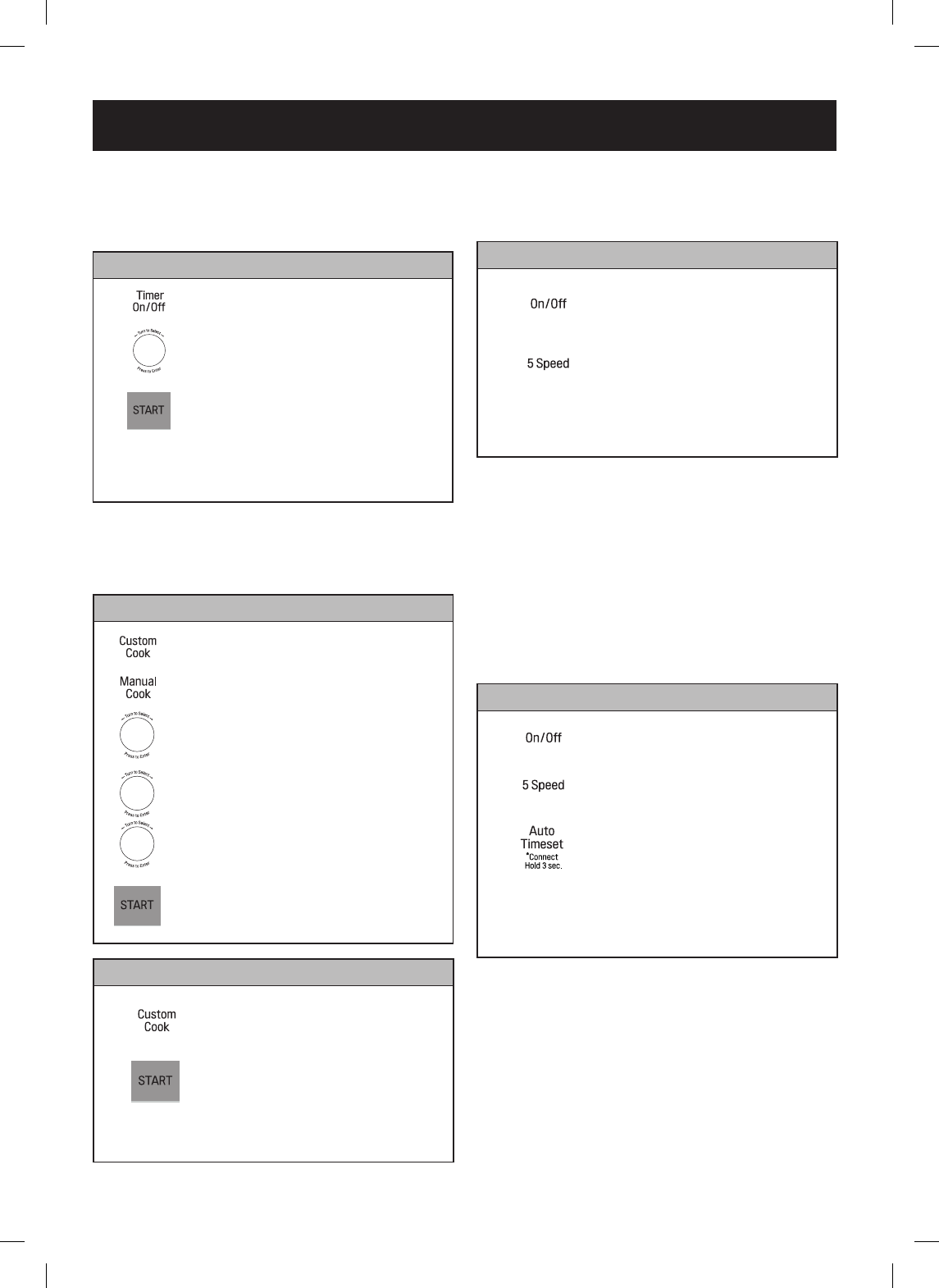
- 16 -
OPERATION
TIMER
Use this feature for a a general purpose timer. It can be
used while cooking in the oven. The timer can be set
for up to 99 minutes and 59 seconds.
CUSTOM COOK
CUSTOM COOK allows one cooking instruction to be
placed in memory and then recalled quickly.
VENT FAN
The bottom of the control panel controls the 5-speed
vent fan.
Note:
• If the temperature from the range or cooktop below
the oven gets too hot, the vent fan in the vent hood
automatically turns on at the 4-Speed setting to
protect the oven. It may stay on up to an hour to cool
the oven. When this occurs, the VENT ON/OFF key
does not turn the fan off. The vent fan cannot be
turned off during microwave cooking.
VENT FAN AUTO TIME SET
Example: To memorize a 2-minute microwave cook.
1. Touch CUSTOM COOK.
2. Touch MANUAL COOK.
3. Turn the dial to select the
cooking type (MICROWAVE).
Touch START or press the dial to
enter.
4. Turn the dial to set the power
level (POWER 100). Touch
START or press the dial to enter.
5. Turn the dial to set the time.
(2:00)
6. Touch START or press the dial
to enter.
Example: To set 3 minutes.
1. Touch TIMER ON/OFF.
2. Turn the dial to set the time. (3:00)
3. Touch START or TIMER ON/OFF
or press the dial to enter.
When the time is over a melody
sounds and END displays. Press
STOP/CLEAR.
To cancel, press TIMER ON/OFF.
Example: To turn off fan after 30 minutes at level 4.
1. Touch ON/OFF.
2. Touch 5 SPEED until Level 4
appears in the display.
3. Touch AUTO TIMESET ve
times.
1 time - 1 minute
2 times - 3 minutes
3 times - 5 minutes
4 times - 10 minutes
5 times - 30 minutes
Example: To set Level 4.
1. Touch ON/OFF.
The display defaults to the last
level selected.
2. Touch 5 SPEED until LEVEL 4
appears in the display.
Turn off fan when desired.
Example: To recall the memory.
1. Touch CUSTOM COOK.
2. Touch START or press the dial to
enter.
When the cook time is over a
melody sounds and COOK END
displays.
3:00
MICROWAVE
POWER 100
2:00
* AUTO TIMESET key is used a function key for Wi-Fi
Connection. Follow details page 39.
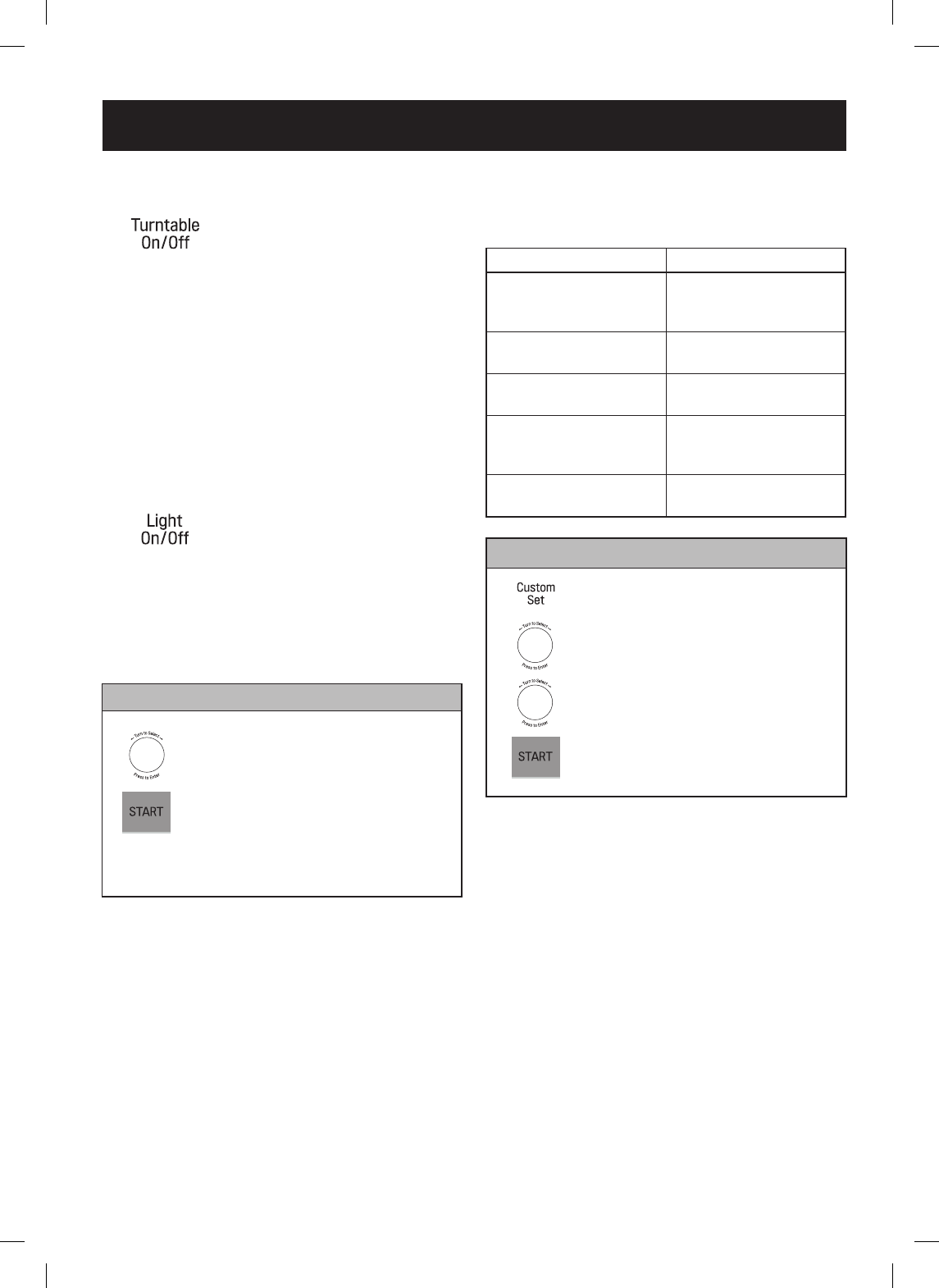
- 17 -
OPERATION
TURNTABLE ON/OFF
For best cooking results, leave
the turntable on. It can be turned
off for large dishes. Touch
TURNTABLE ON/OFF to turn the
turntable on or off.
Notes:
• This option is not available in sensor cook and defrost
modes.
•
Sometimes the turntable can become hot to
touch. Be careful when touching the turntable during
and after cooking.
• Do not run the oven empty.
LIGHT ON/OFF
To turn the hood light on, touch
LIGHT ON/OFF once.
To turn the hood light off, touch
LIGHT ON/OFF again.
COOKING AT HIGH POWER
LEVEL
CUSTOM SET
Use this key to change settings for the clock, beep
sound, display speed, and defrost weight.
See the following chart for more information.
CATEGORY SELECTION
Clock set
Hours
Minutes
AM/PM
Sound ON/OFF Sound ON
Sound OFF
Clock ON/OFF Clock ON
Clock OFF
Scroll speed
Slow speed
Normal speed
Fast speed
Defrost weight mode Lbs.
Kg.
Example: To cook food for 8 minutes 30 seconds.
1. Turn the dial to select the time.
(8:30)
2. Touch START or press the dial
to enter.
When the cook time is over a
melody sounds and COOK END
displays.
Example: To change defrost weight mode.(from Lbs. to Kg.)
1. Touch CUSTOM SET.
2. Turn the dial to select
Lbs/Kg Touch START or press
the dial to enter.
3. Turn the selector dial to select
Kg.
4. Touch START or press the dial
to enter.
Lbs/Kg
Kg
8:30
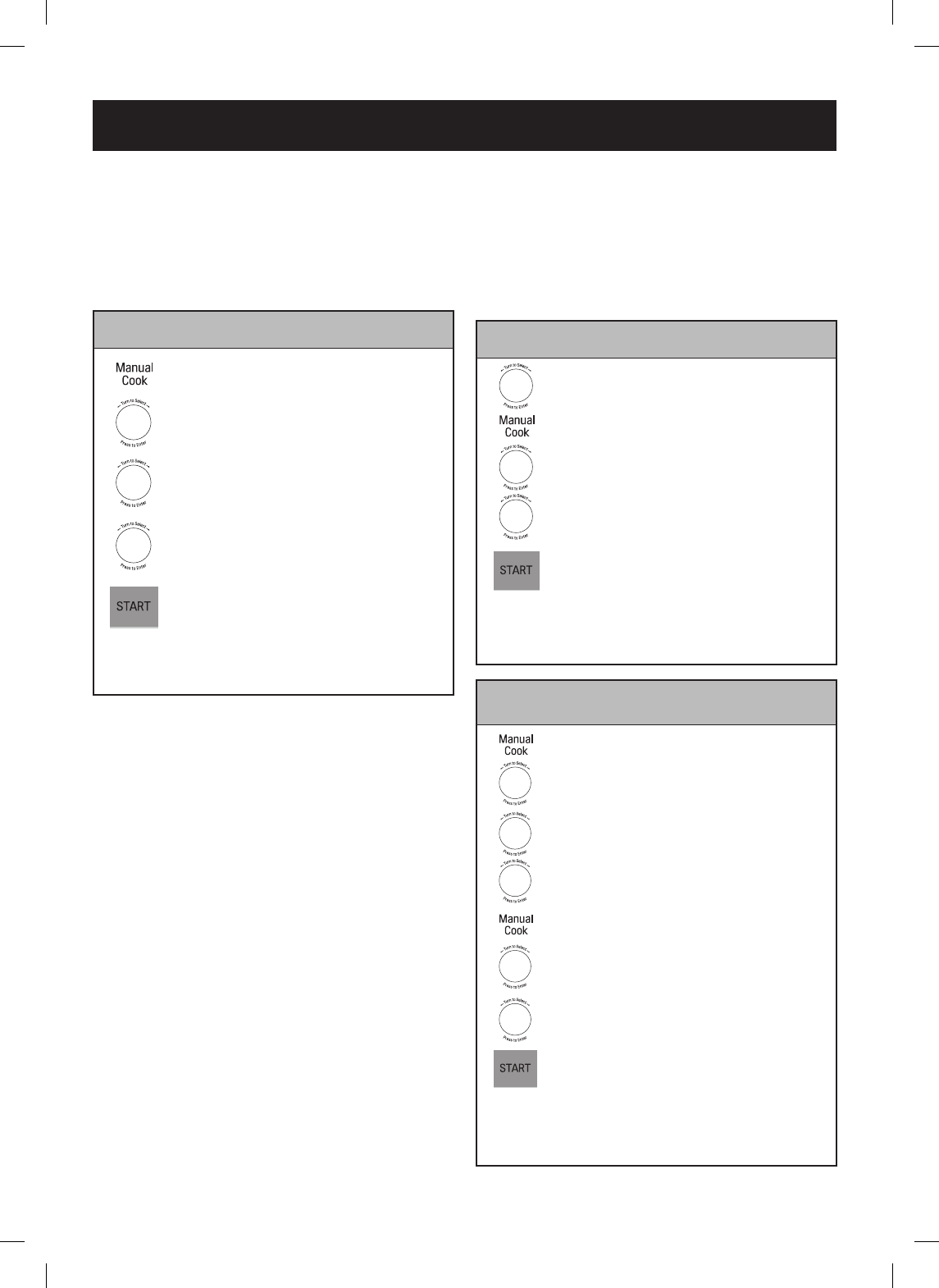
- 18 -
OPERATION
COOKING AT LOWER POWER
LEVELS
HIGH power cooking does not always give the best
results with foods that need slower cooking, such as
roasts, baked goods, or custards. The oven has 10
power settings in addition to HIGH.
COOKING WITH MORE THAN
ONE COOK CYCLE
For best results, some recipes call for one power level
for a certain length of time, and another power level for
another length of time. The oven can be set to change
from one power level to another automatically, for up to
three cycles if the rst heating cycle is defrost.
Example: To cook food for 7 minutes 30 seconds
at 70% power.
1. Touch MANUAL COOK.
2. Turn the dial to select
MICROWAVE. Touch START or
press the dial to enter.
3. Turn the dial to set the power
level (POWER 70). Touch START
or press the dial to enter.
4. Turn the dial to set the time.(7:30)
5. Touch START or press the dial to
enter.
When the cook time is over a
melody sounds and COOK END
displays.
Example: To cook food for 3 minutes at 100% power
and then 70% power for 7 minutes 30 seconds.
1. Turn the dial to select the time.
(3:00)
2. Touch MANUAL COOK.
3. Turn the dial to set the power
level (POWER 70). Touch START
or press the dial to enter.
4. Turn the dial to set the time.(7:30)
5. Touch START or press the dial to
enter.
When the cook time is over a
melody sounds and COOK END
displays.
MICROWAV
E
POWER 70
7:30
3:00
POWER 70
7:30
When the rst stage is over a melody sounds as the oven
begins the second cook stage.
Example: To cook at 70% for 3 minutes and then at
50% for 10 minutes.
1. Touch MANUAL COOK.
2. Turn the dial to select
MICROWAVE. Touch START or
press the dial to enter.
3. Turn the dial to set the power
level (POWER 70). Touch START
or press the dial to enter.
4. Turn the dial to set the time (3:00).
5. Touch MANUAL COOK.
6. Turn the dial to set the power
level (POWER 50). Touch START
or press the dial to enter.
7.
Turn the dial to set the time (10:00).
8. Touch START or press the dial to
enter.
When the cook time is over, a
melody sounds and COOK END
displays.
POWER 70
POWER 50
3:00
10:00
MICROWAVE
When the rst stage is over, a melody sounds as the oven
begins the second cook stage.
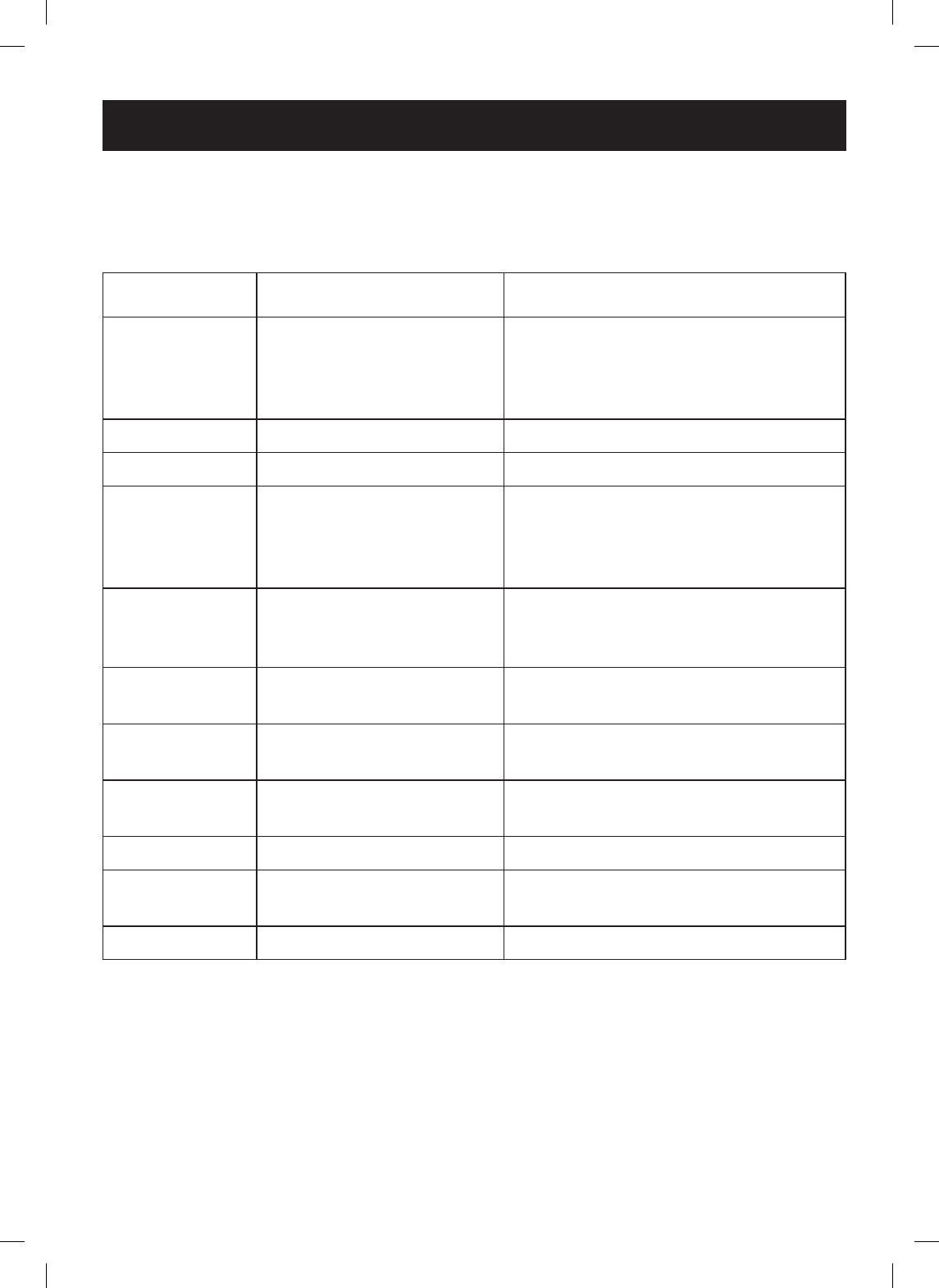
- 19 -
COOKING GUIDE FOR LOWER POWER LEVELS
POWER LEVEL MICROWAVE OUTPUT USE
100
HIGH
100% • Quick heating many convenience foods and
foods with high water content, such as soups
and beverages.
• Cooking tender cuts of meat, ground meat
90 90% • Heating cream soups
80 80% • Heating rice, pasta, or casseroles
70 70% • Cooking and heating foods that need a cook
power lower than high (for example, whole sh
and meat loaf) or when food is cooking too fast
• Reheating a single serving of food
60 60% • Cooking requiring special care, such as cheese
and egg dishes, pudding, and custards
• Finishing cooking casseroles
50 50% • Cooking ham, whole poultry, and pot roasts
• Simmering stews
40 40% • Melting chocolate
• Heating pastries
30 30% • Manually defrosting foods, such as bread, sh,
meats, poultry, and precooked foods
20 20% • Softening butter, cheese, and ice cream
10 10% • Keeping food warm
• Taking the chill out of fruit
00 0% • Standing time in oven
OPERATION
The nine power levels in addition to HIGH provide a
choice of the best level for the food being cooked.
Below are listed all the power levels,
examples of foods best cooked at each level, and the
amount of microwave power being used.
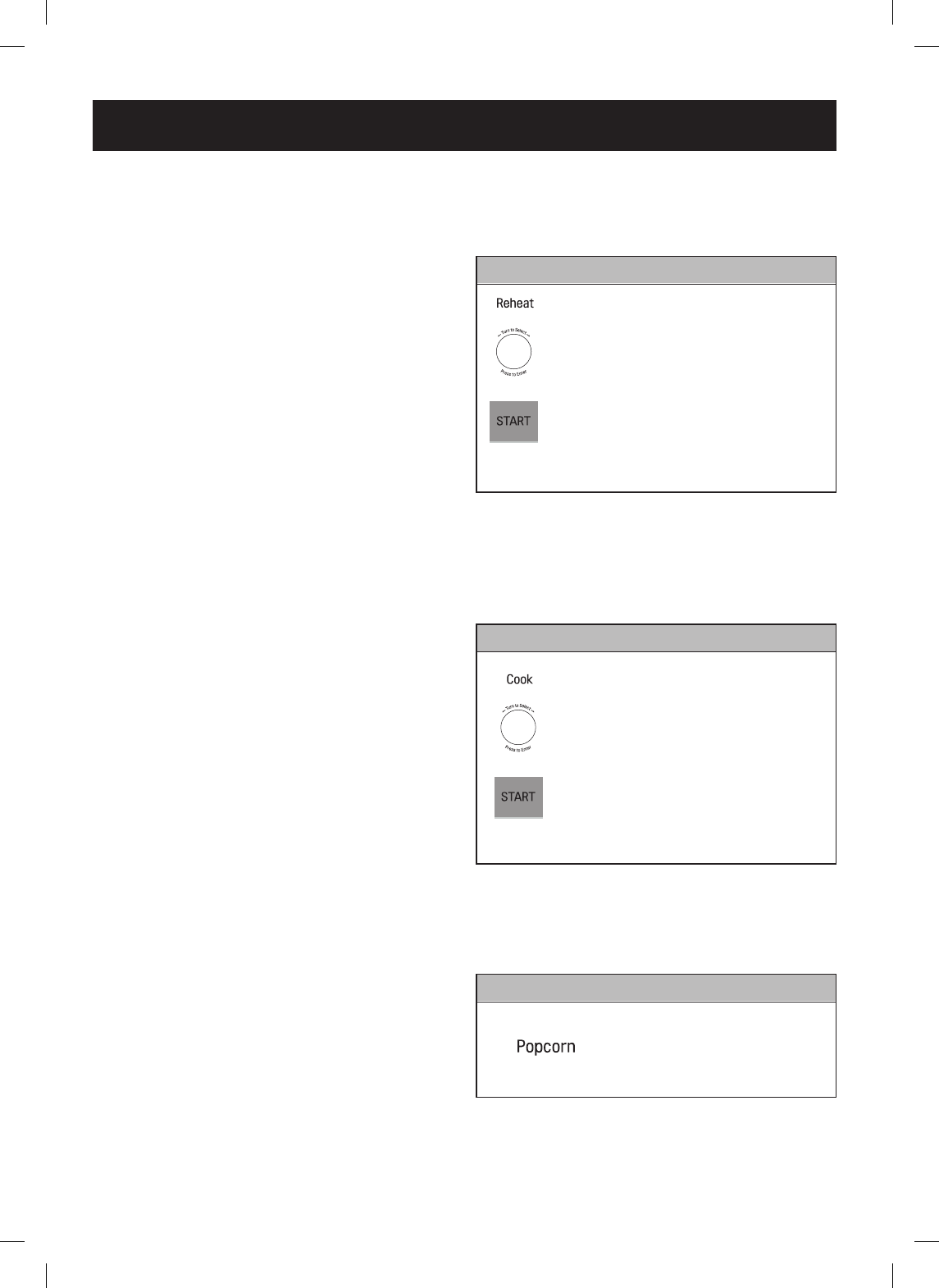
- 20 -
OPERATION
SENSOR OPERATING
INSTRUCTIONS
Sensor Cook cooks favorite foods without selecting
cooking times and power levels.
The oven automatically determines required cooking
time for each food item. When the internal sensor
detects a certain amount of humidity coming from
the food, it tells the oven how much longer to heat.
The display shows the remaining heating time. For
best results when sensor cooking, follow these
recommendations.
1. Food cooked with the sensor system should be at
normal storage temperature.
2. The glass tray and the outside of the container
should be dry to assure best cooking results.
3. Foods should always be covered loosely with
microwavable plastic wrap, waxed paper, or a lid.
4. Do not open the door or touch STOP/CLEAR during
the sensing time. When sensing time is over, the
oven beeps and the remaining cooking time will
appear in the display window.
At this time you can open the door to stir, turn, or
rearrange the food.
SENSOR COOKING GUIDE
Appropriate containers and coverings help assure good
sensor cooking results.
1. Always use microwavable containers and cover
them with lids or vented plastic wrap.
2. Never use tight-sealing plastic covers. They can
prevent steam from escaping and cause food to
overcook.
3. Match the amount to the size of the container.
Fill containers at least half full for best results.
4. Be sure the outside of the cooking container and the
inside of the microwave oven are dry before placing
food in the oven. Beads of moisture turning into
steam can mislead the sensor.
SENSOR REHEAT
Use SENSOR REHEAT to reheat common microwave-
prepared foods without selecting cooking times and
power levels.
SENSOR COOK
Use SENSOR COOK to heat common microwave-
prepared foods without needing to program times and
power levels. SENSOR COOK has preset programs for
6 food categories.
SENSOR POPCORN
POPCORN lets you pop commercially packaged
microwave popcorn. Pop only one package at a time.
For best results, use fresh bags of popcorn.
Example: To cook rice.
1. Touch COOK.
2. Turn the dial to select RICE.
3. Touch START or press the dial to
enter. After a slight delay, cooking
begins.
When the cook time is over a
melody sounds and COOK END
displays.
Example: To reheat slices of pizza.
1. Touch REHEAT.
2. Turn the dial to select
PIZZA SLICE.
3. Touch START or press the dial to
enter.
When the cook time is over a
melody sounds and COOK END
displays.
Example: To pop popcorn.
1. Touch POPCORN.
When the cook time is over a
melody sounds and COOK END
displays.
RICE
PIZZA
SLICE
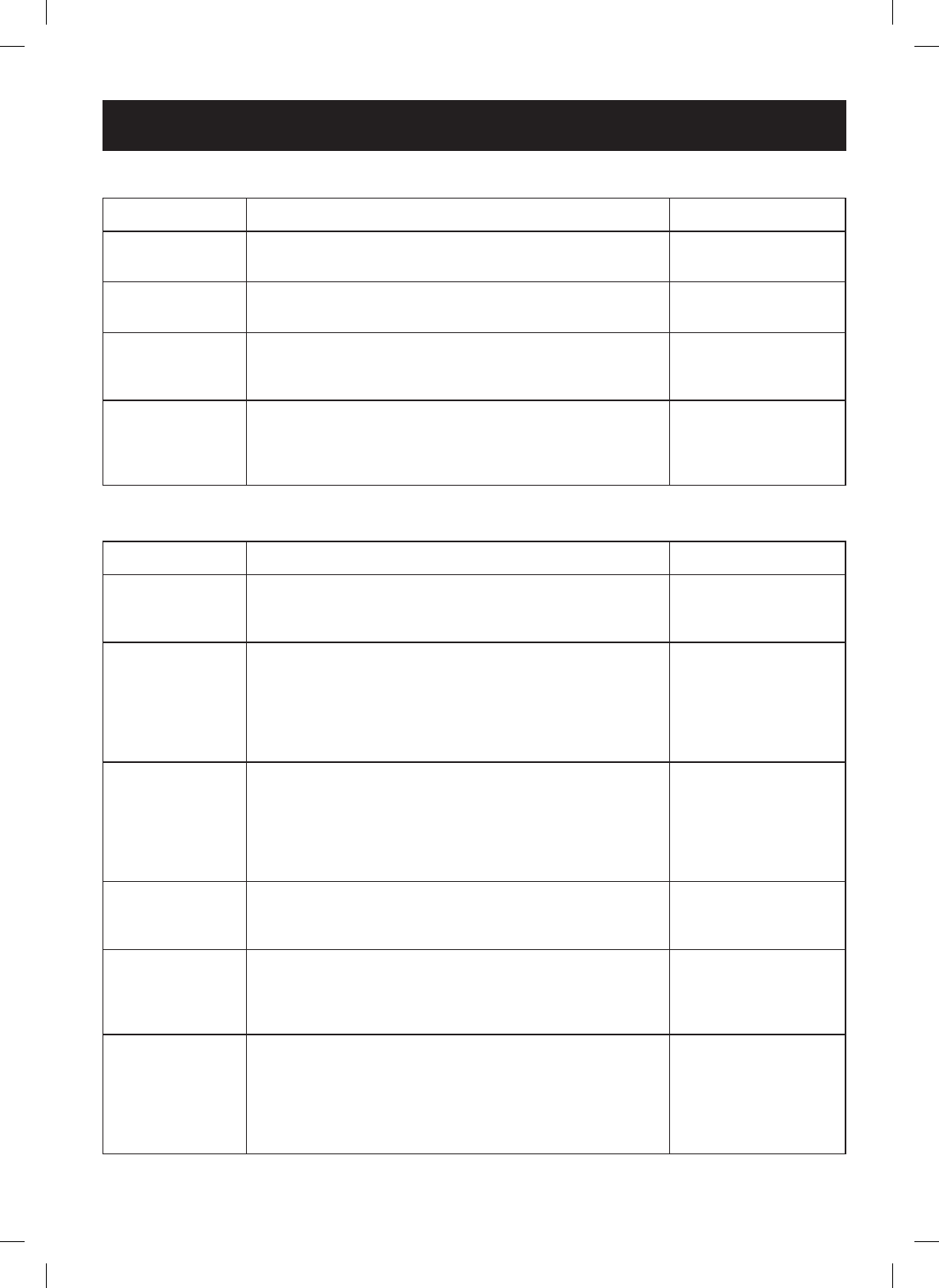
- 21 -
OPERATION
SENSOR REHEAT TABLE
CATEGORY
DIRECTION AMOUNT
Dinner Plate Place on a low plate. Cover with vented plastic wrap.
Let stand 3 minutes after cooking.
1 to 2 servings
Soup/Sauce Place in shallow microwavable casserole. Cover with vented
plastic wrap. After cooking, stir and let stand 3 minutes.
1 - 4 cups
Casserole Place in a microwavable bowl or casserole. Cover with
vented plastic wrap. After cooking, stir and let stand 3
minutes.
1 - 4 cups
Pizza Slice This function is for re-heating pizza that was cooked
previously. It is NOT for raw, ready-to-bake, or frozen pizza.
Place the pizza slice(s) on a paper towel or microwave safe
plate.
1 - 4 slices
SENSOR COOK TABLE
CATEGORY
DIRECTION AMOUNT
Baked
Potato
Pierce each potato with a fork and place on the oven tray
around the edge, at least one inch apart.
After cooking, allow to stand for 5 minutes.
1 - 4 medium
(approx. 8 to 10 oz.
each)
Frozen
Vegetable
Remove from package, rinse off frost under running water.
Place in an appropriately sized microwave container. Add
amount of water according to the quantity (1 - 2 cups: 2
tablespoons, 3 - 4 cups: 4 tablespoons). Cover with plastic
wrap and vent. After cooking, stir and allow to stand for 3
minutes.
1 - 4 cups
Fresh
Vegetable
Prepare as desired, wash, and leave residual water on
the vegetables. Place in an appropriately sized microwave
container. Add amount of water according to the quantity (1 -
2 cups: 2 tablespoons, 3 - 4 cups: 4 tablespoons). Cover with
plastic wrap and vent. After cooking, stir and allow to stand for
3 minutes.
1 - 4 cups
Canned
Vegetable
Remove from the can. Place in an appropriately sized
microwave container, cover with plastic wrap, and vent. After
cooking, stir and allow to stand for 3 minutes.
1 - 4 cups
Frozen
Entrée
Remove from outer package. Slit cover. If not in microwave-safe
container, place on a plate. Cover with plastic wrap and vent the
plastic lm by piercing with a fork (3 times). After cooking, allow
to stand for 3 minutes.
10 to 21 oz.
Rice Place rice and twice as much liquid (water, chicken or
vegetable stock) in a 2-quart microwave dish. Cover with
plastic wrap and vent. After cooking, allow to stand for 10
minutes. Stir for ufer rice.
½ - 2 cups
Use medium or long
grain rice.
Cook instant rice
according to directions
on the package.

- 22 -
OPERATION
TIPS FOR CONVECTION
COOKING
This section provides cooking instructions and
procedures for each convection function.
Convection cooking circulates hot air through the
oven cavity with a fan. The constantly moving air
surrounds the food to heat the outer portion quickly,
creating even browning and sealed-in avor through
the constant motion of hot air over the food surfaces.
To use convection cooking, turn the dial to select the
Convection or Combination modes. DO NOT USE THE
OVEN WITHOUT THE TURNTABLE IN PLACE.
1.
Always use the metal rack on the turntable when
convection cooking.
2.
Do not cover the turntable or metal rack with
aluminum foil. It interferes with the ow of a
4.
Use convection cooking for items like soufés,
breads, cookies, angel food cakes, pizza, and for
some meat and sh.
5.
The oven comes equipped with a metal tray which
can be used for cooking in convection mode or
combination mode.
6.
No special techniques are necessary to adapt
favorite oven recipes to convection cooking; but
reduce the oven temperature by 25°F from the
recommended temperature when cooking packaged
foods in convection mode.
7. When baking cakes, cookies, breads, rolls, or
other baked foods, most recipes call for preheating.
Preheat the empty oven just as with a regular oven.
You can start heavier dense foods such as meats,
casseroles, and poultry without preheating.
8.
All heatproof cookware or metal utensils can be
used in convection cooking.
9.
As in conventional cooking, the distance of the
food from the heat source affects cooking results.
Refer to the charts in this owner's manual.
10.
Use metal utensils only for convection cooking.
Never use for microwave or combination cooking
since arcing and damage to the oven may occur.
11. After preheating, if the door remains closed,
the oven automatically holds at the preheated
temperature for 30 minutes.
PRECAUTIONS
• The oven cavity, door, turntable, roller rest, metal tray,
metal rack, and cooking utensils become very hot.
USE THICK OVEN GLOVES when removing the food,
cooking utensils, metal rack, metal tray, and turntable
from the oven after convection cooking.
• Do not use lightweight plastic containers, plastic
wraps, or paper products during any convection cycle.
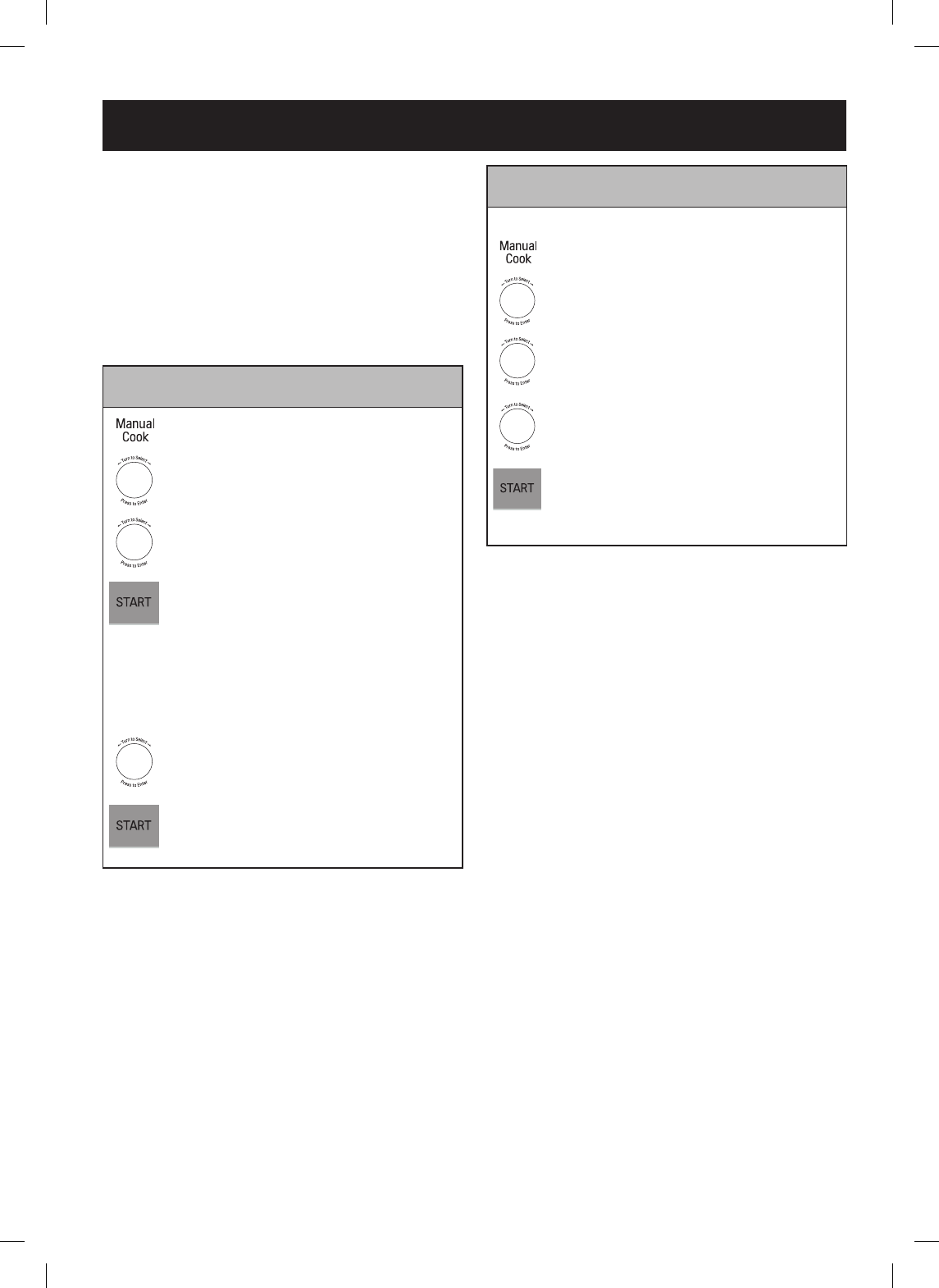
- 23 -
OPERATION
CONVECTION
During convection cooking, a heating element is used
to raise the temperature of the air inside the oven.
Convection cooking temperature ranges from 100°F to
450°F.
It is best to preheat the oven when convection cooking.
Note: Reduce oven temperature by 25°F from the
temperature recommended on packaged foods.
The baking time may vary according to the food
condition or individual preference.
Notes:
• When the oven reaches the set preheat temperature,
a melody will sound and the display scrolls the
message PREHEAT END. The oven automatically
holds that temperature for 30 minutes.
• The oven temperature drops very quickly when the
door is opened; however, this should not prevent food
from being fully cooked during normal cooking time.
• During convection cooking, the vent fan in the vent
hood automatically turns on at the 1-speed (lowest
speed) setting to protect the oven.
Note: The temperature range has 10 steps from 100°F
to 450°F.
Example: To set for convection cooking at 325°F for
45 minutes with preheating.
1. Touch MANUAL COOK.
2. Turn the dial to select
CONVECTION. Touch START or
press the dial to enter.
3. Turn the dial to set the
temperature (325°F). Touch
START or press the dial to enter.
4. Touch START or press the dial to
begin preheating.(Do not enter
the time.)
5. When the melody sounds, Place
the food in the oven.
6. Turn the dial to set the time.
(45:00)
7. Touch START or press the dial to
enter.
Example: To set for convection cooking at 375°F for
30 minutes without preheating.
1. Touch MANUAL COOK.
2. Turn the dial to select
CONVECTION. Touch START or
press the dial to enter.
3. Turn the dial to set the
temperature (375°F). Touch
START or press the dial to enter.
4. Turn the dial to set the time.
(30:00)
5. Touch START or press the dial
to enter.
CONVECTION
325℉
45:00
DISPLA
Y SCROLLS
PREHEA
T END
CONVECTION
375℉
30:00
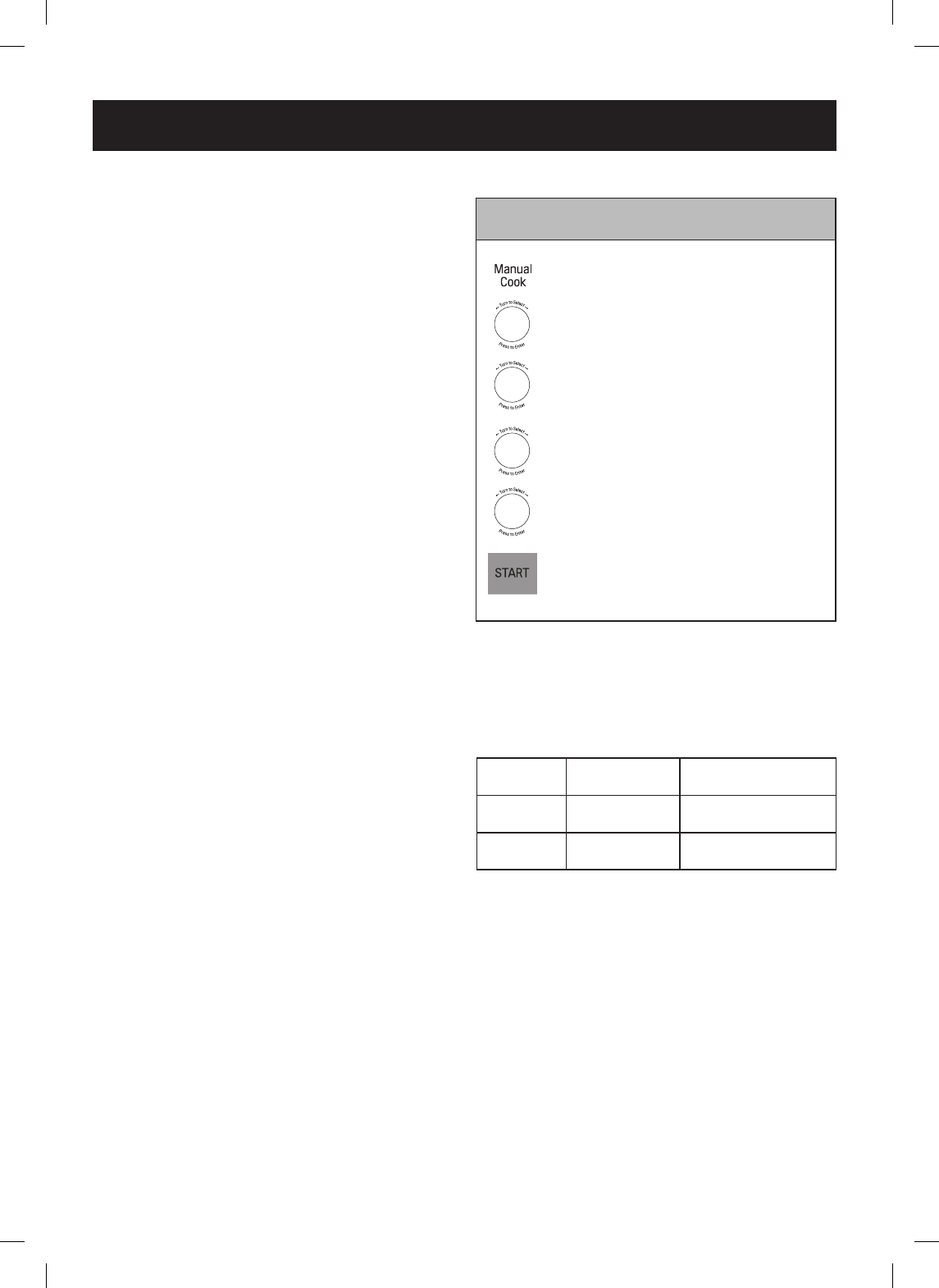
- 24 -
OPERATION
TIPS FOR COMBINATION
COOKING
This section provides instructions for each combination
cooking function. Combination microwave-convection
cooking shortens the cooking time for foods that
normally need a long time to cook. It also leaves
meat juicy on the inside and crispy on the outside.
In combination cooking, the convection heat and
microwave energy alternate automatically. The oven
has three preprogrammed settings that make it easy to
use combination cooking.
HELPFUL HINTS FOR
COMBINATION COOKING
1. Meats can be roasted directly on the metal rack or
in a shallow roasting pan placed on the rack. When
using the metal rack, check the cooking guide for
information on proper use.
2.
Less tender cuts of beef can be roasted and
tenderized using oven cooking bags.
3.
When baking, check for doneness after cooking
time is up. If not completely done, let stand in oven
for a few minutes to complete cooking.
PRECAUTIONS
1. All cookware used for combination cooking must be
BOTH microwave-safe and oven-safe.
2. During combination baking, some baking cookware
may cause arcing when it comes in contact with the
oven walls or metal accessory racks. Arcing is a
discharge of electricity that occurs when microwaves
come in contact with metal.
- If arcing occurs, immediately stop the cooking cycle
and place a heat resistant dish between the pan and
the metal rack.
- Use the metal tray supplied with the oven. It has
rubber feet that help prevent arcing.
- If arcing occurs with other baking cookware, do not
use them for combination cooking.
COMBINATION ROAST
Notes:
• The temperature range has 9 steps from 250°F to
450°F.
• During combination cooking, the exhaust fan in the
vent hood automatically turns on at the 1-speed
(lowest) setting to protect the oven.
COMBI CATEGORY DEFAULT
TEMPERATURE
Co-1 Combination
ROAST
Convection
375°F
Co-2 Combination
BAKE
Convection
325°F
Example: To roast with combination cooking for
45 minutes at 400°F.
1. Touch MANUAL COOK.
2. Turn the dial to select COMBI.
Touch START or press the dial to
enter.
3. Turn the dial to select Co-1.
4. Turn the dial to set the
temperature. (400℉)
5. Turn the dial to set the time.
(45:00)
6. Touch START or press the dial to
enter.
COMBI
Co-1
400 ℉
45:00
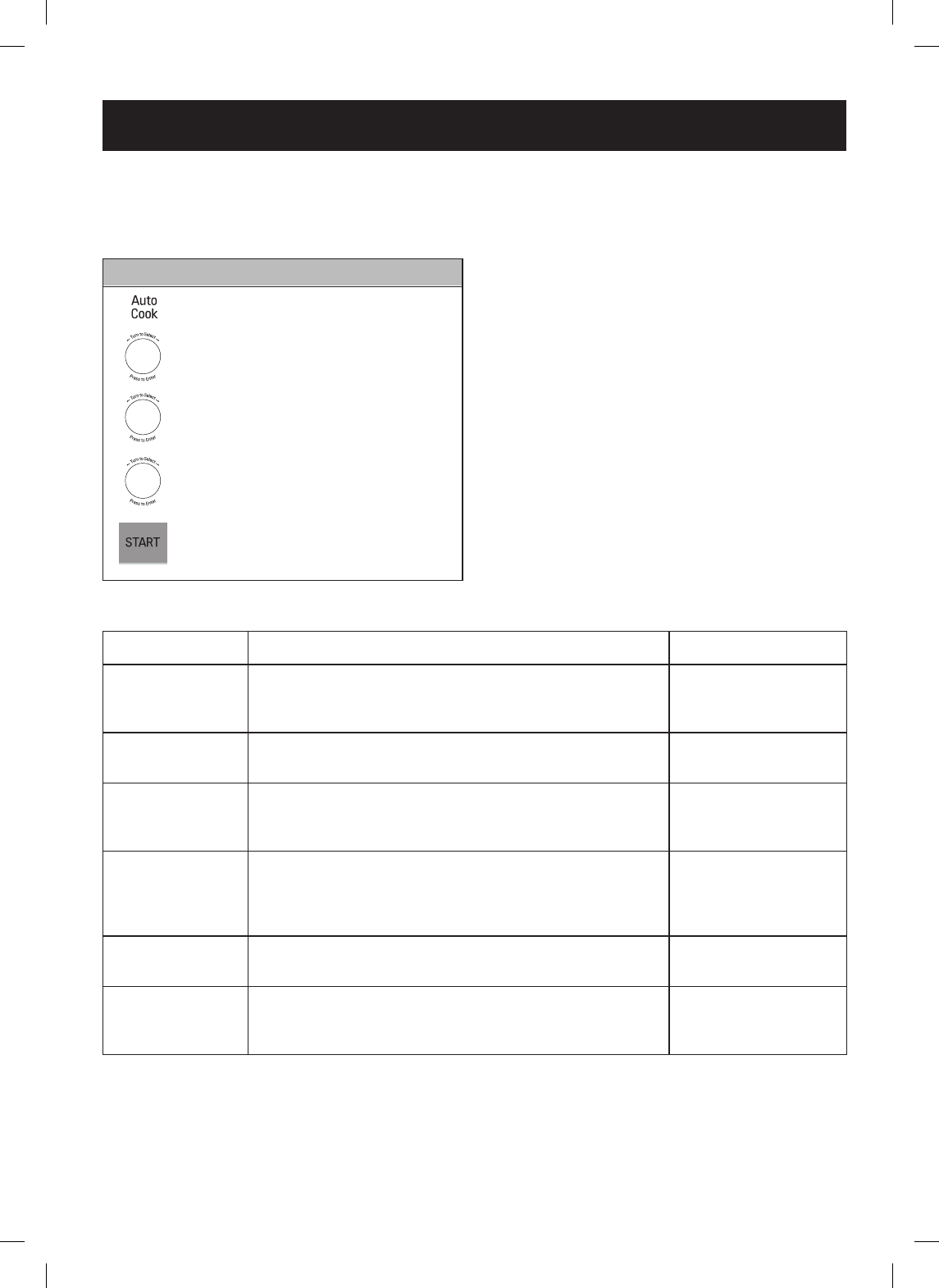
- 25 -
OPERATION
AUTO COOK
Use Auto Cook to heat common microwave-prepared
foods without selecting cooking times and power levels.
Auto Cook has preset programs for 6 food functions.
AUTO COOK TABLE
CATEGORY
DIRECTION AMOUNT
Bacon Place bacon strips on a microwave bacon rack for best
results. (Use dinner plate lined with paper towels if rack is not
available).
2 - 6 slices
Fresh
Roll/Mufn
Remove from package and place on plate. (If mufns are
over 3 oz. each, count each as two when entering quantity).
1 - 6 pieces
(2 - 3 oz. each)
Frozen
Roll/Mufn
Remove from display package and place on plate. (If mufns
are over 3 oz. each, count each as two when entering
quantity).
1 - 6 pieces
(2 - 3 oz. each)
Beverage Use a wide-mouth mug. Do not cover.
(Be careful. The beverage will be very hot! Sometimes liquids
heated in cylindrical containers will splash out when the cup
is moved).
1 - 2 cups
Chicken
Pieces
Place the chicken pieces in an appropriately sized
microwavable container, cover with plastic wrap, and vent.
0.5 - 2 lbs.
(0.2 - 0.9 kg)
Hot Cereal Prepare as directed on package and cook.
Stir well before eating.
Use only instant hot cereal.
1 - 6 servings
Note:
Do not use recycled paper products in the microwave oven.
They sometimes contain impurities that cause arcing and sparking.
NEVER use paper products in the convection oven.
Example: To cook bacon 2 slices.
1. Touch AUTO COOK.
2. Turn the dial to select
AUTO COOK. Touch START or
press the dial to enter.
3. Turn the dial to select BACON.
Touch START or press the dial to
enter.
4. Turn the dial to select
2 SLICES.
5. Touch START or press the dial to
enter.
AUTO
COOK
BACON
2 SLICES
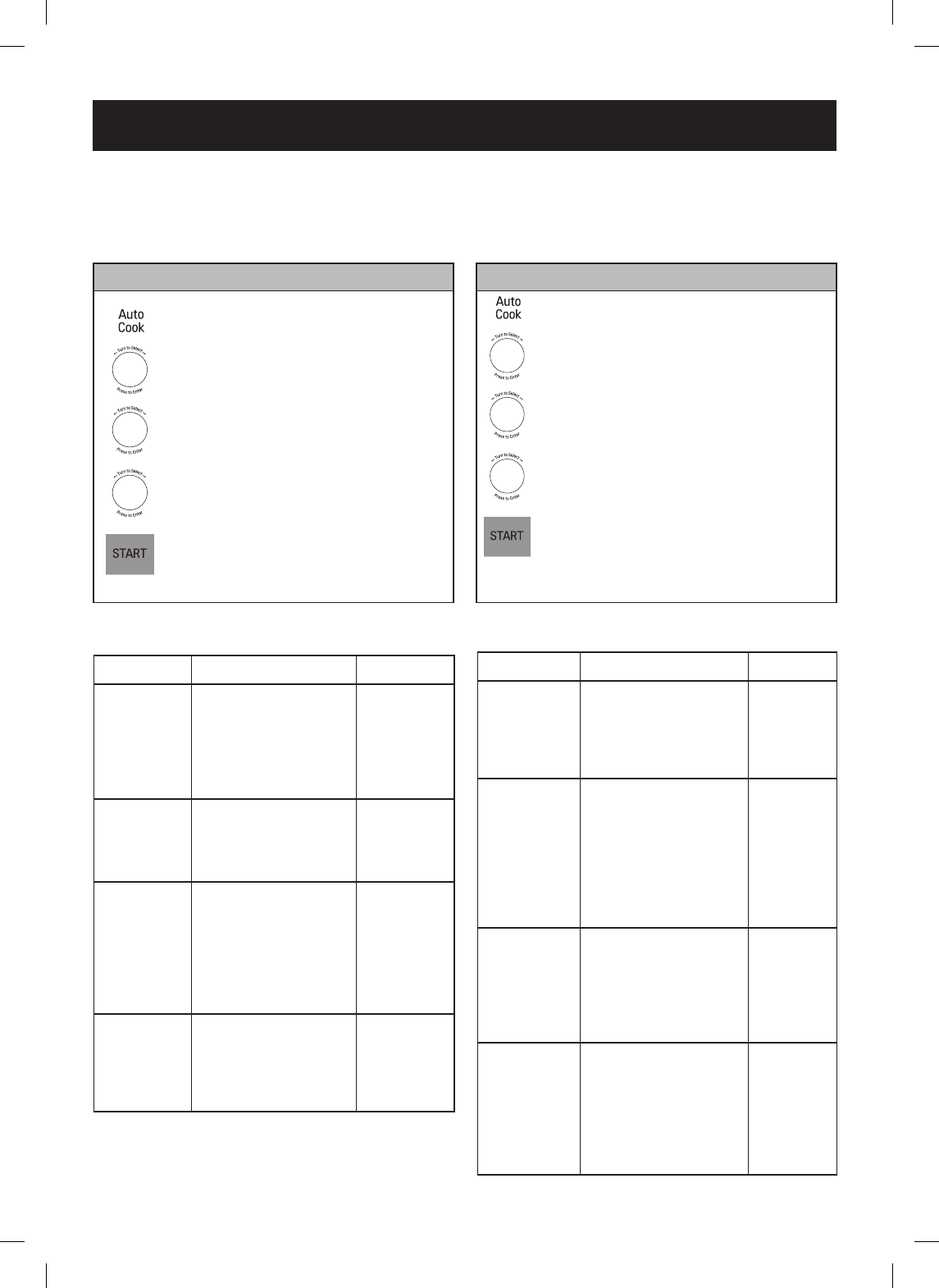
- 26 -
OPERATION
SOFTEN
The oven uses low power to soften foods (butter, ice
cream, cream cheese, and frozen juice).
See the following table.
SOFTEN TABLE
CATEGORY DIRECTION AMOUNT
Butter Unwrap and place
in microwavable
container.
Butter will be at room
temperature and ready
for use in recipe.
1, 2 or 3
sticks
Ice
Cream
Place container in
oven. Ice cream will be
soft enough to make
scooping easier.
Pint,
Quart,
Half
gallon
Cream
Cheese
Unwrap and place
in microwavable
Container.
Cream cheese will be
at room temperature
and ready for use in
recipe.
3 or 8 oz.
Frozen
Juice
Remove top.
Place in oven.
Frozen juice will be
soft enough to mix
easily with water.
6, 12 or
16 oz.
MELT
The oven uses low power to melt foods (butter,
chocolate, processed cheese food, or marshmallows).
See the following table.
MELT TABLE
CATEGORY DIRECTION AMOUNT
Butter Unwrap and place in
microwavable container.
No need to cover butter.
Stir at the end of cooking
to complete melting.
1, 2 or 3
sticks
Chocolate
Chocolate chips or
squares of baking
chocolate may be used.
Unwrap squares and
place in microwavable
container. Stir at the
end of cycle to complete
melting.
4 or 8 oz.
Cheese
Use processed cheese
food only. Cut into cubes.
Place in a single layer in
microwavable container.
Stir at the end of cooking
to complete melting.
8 or 16
oz.
Marshmallows
Large or miniature
marshmallows may be
used.
Place in microwavable
container. Stir at the
end of cycle to complete
melting.
5 or 10
oz.
Example for quart of ice cream.
1. Touch AUTO COOK.
2. Turn the dial to select SOFTEN.
Touch START or press the dial to
enter.
3. Turn the dial to select ICE
CREAM. Touch START or press
the dial to enter.
4. Turn the dial to select QUART.
5. Touch START or press the dial to
enter.
When the cook time is over a
melody sounds and COOK END
displays.
Example for 8 oz. of chocolate.
1. Touch AUTO COOK.
2. Turn the dial to select MELT.
Touch START or press the dial to
enter.
3. Turn the dial to select
CHOCOLATE. Touch START or
press the dial to enter.
4. Turn the dial to select 8 Oz.
5. Touch START or press the dial to
enter.
When the cook time is over a
melody sounds and COOK END
displays.
SOFTEN
ICE CREAM
QUART
MELT
CHOCOLATE
8 Oz
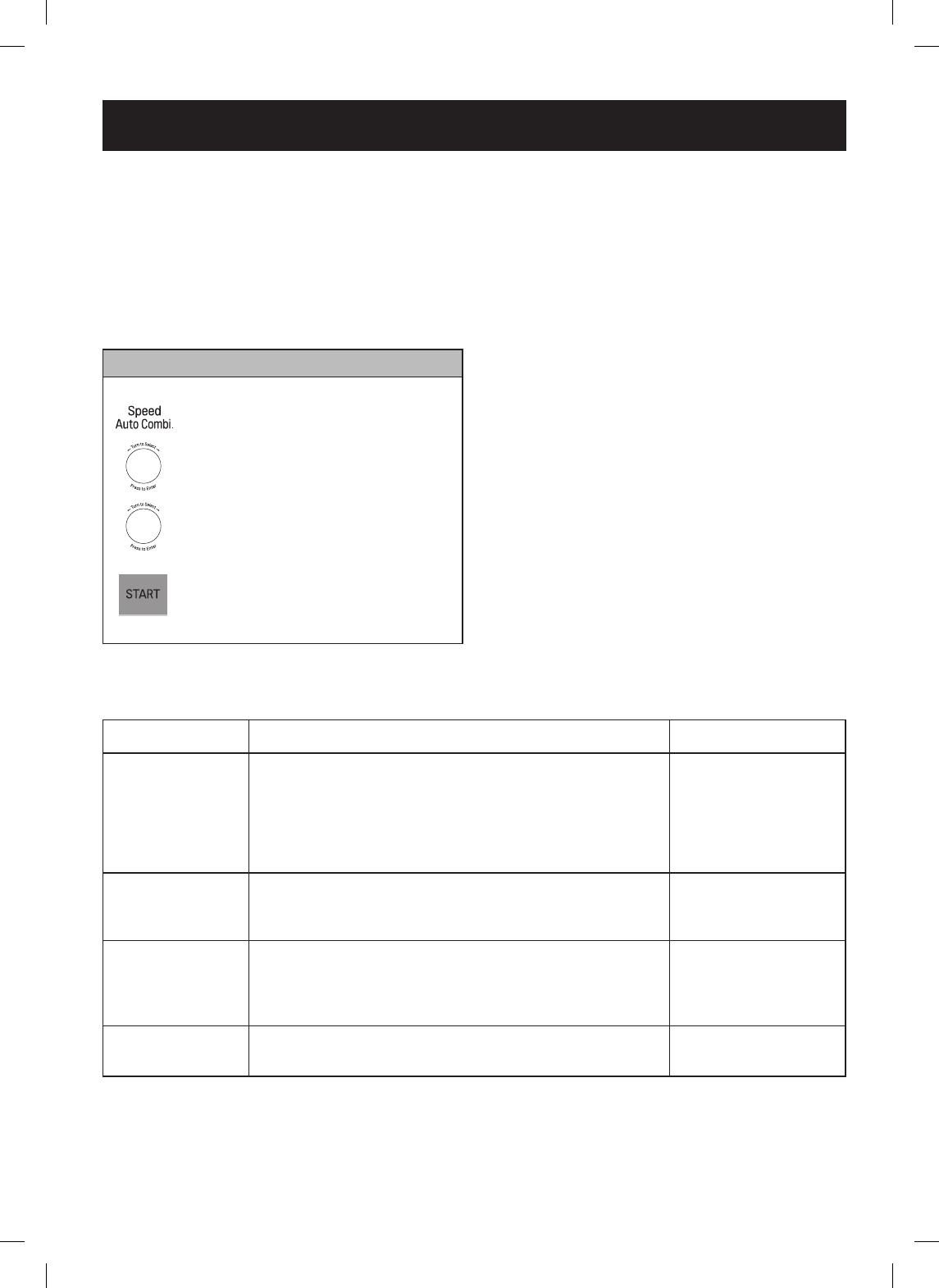
- 27 -
OPERATION
SPEED AUTO COMBINATION
Use to cook food without entering cooking time
or power level on combination mode. SPEED AUTO
COMBINATION has 4 food categories.
See the SPEED AUTO COMBINATION CHART on this
page for the settings available.
For best results, place food on the rack. When
cooking meats, use the metal tray/drip pan to catch
drippings.
SPEED AUTO COMBINATION CHART
CATEGORY
DIRECTION AMOUNT
Whole
Chicken
Thoroughly wash inside and outside of chicken with cold
water. Pat chicken dry with paper towels, secure the legs with
kitchen twine. Brush outside of chicken with melted butter or
margarine. Place chicken breast side down on metal rack on
metal tray. After cooking, loosely tent chicken with aluminum
foil. Let stand for 10 minutes after cooking.
2.0 - 4.0 lbs.
(0.9 - 1.8 kg)
Roast Pork Pat dry with paper towels. Place roast on metal rack on metal
tray. After cooking, loosely tent roast with aluminum foil and
let stand 5 to 10 minutes.
2.0 - 4.0 lbs.
(0.9 - 1.8 kg)
Frozen
Lasagna
Remove from outer package. Remove lm cover. If lasagna is
not in an ovenproof container, place it on an ovenproof dish.
Place on metal rack on metal tray. Let stand for 5 minutes
after cooking.
10 or 21 oz.
Baked Potatoes Pierce each potato several times with a fork and place on
metal rack on metal tray.
1 - 4 ea
Example: To cook 2 lb. roast pork.
1. Touch SPEED AUTO COMBI.
2. Turn the dial to select ROAST
PORK. Touch START or press the
dial to enter.
3. Turn the dial to select 2.0 Lbs.
4. Touch START or press the dial to
enter.
ROAST
PORK
2.0 Lbs
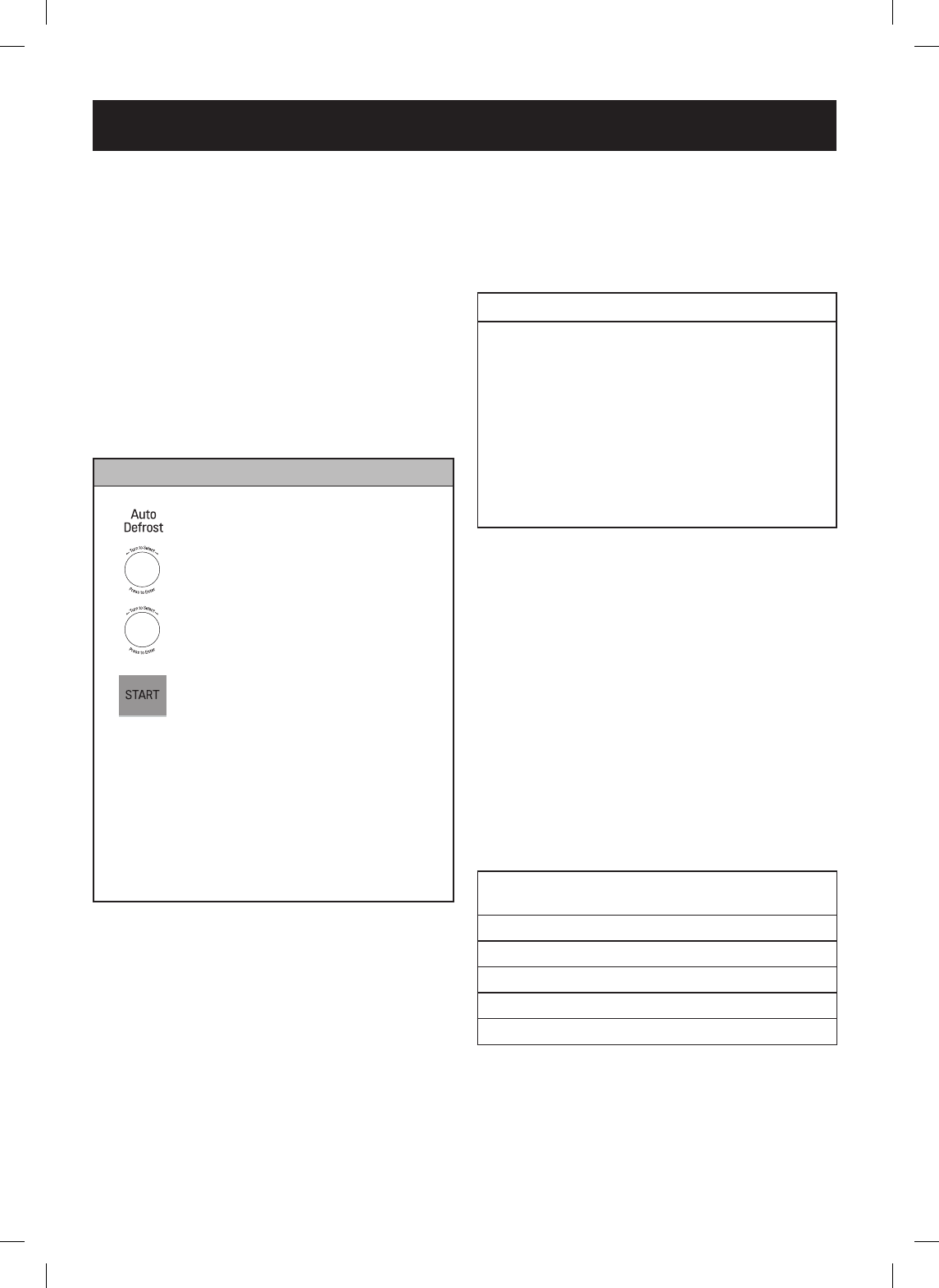
- 28 -
OPERATION
AUTO DEFROST
Five defrost sequences are preset in the oven.
The auto defrost feature provides the best defrosting
method for frozen foods. The Auto Defrost
Table shows which defrost sequence is recommended.
For added convenience, Auto Defrost includes a built-
in beep mechanism as a reminder to check, turn over,
separate, or rearrange food to get the best defrost
results. Five different defrost settings are provided.
1 MEAT
2 POULTRY
3 FISH
4 BREAD
5 QUICK DEFROST
WEIGHT CONVERSION TABLE
Most food weights are given in pounds and ounces.
If using pounds, food weights must be entered into Auto
Defrost in pounds and tenths of pounds (decimals).
Use the following table if necessary to convert food
weights to decimals.
Equivalent Weight
OUNCES
1.6
3.2
4.8
6.4
8.0
9.6
11.2
12.8
14.4
16.0
DECIMAL WEIGHT
.10
.20
.30
.40
.50 One-Half Pound
.60
.70
.80
.90
1.00 One Pound
OPERATING TIPS
• For best results, remove sh, shellsh, meat, and
poultry from its original closed paper or plastic
package (wrapper). Otherwise, the wrap will hold
steam and juice close to the foods, which can cause
the outer surface of the foods to cook.
• For best results, shape the ground meat into the
form of a doughnut before freezing. When defrosting,
scrape off thawed meat when the beep sounds and
continue defrosting.
• Place foods in a shallow container or on a microwave
roasting rack to catch drippings.
• For more defrost help, read Defrosting Tips following
the Auto Defrost Table.
For best results, loosen or remove coverings on food.
FOOD WEIGHTS YOU CAN SET
(tenths of a pound)
Meat 0.1 to 6.0 (0.1 - 4 kg)
Poultry 0.1 to 6.0 (0.1 - 4 kg)
Fish 0.1 to 6.0 (0.1 - 4 kg)
Bread 0.1 to 1.0 (0.1 - 0.5 kg)
Quick Defrost Only 1 lb (0.5 kg only)
Example: To defrost 1.2 lbs. of meat.
1. Touch AUTO DEFROST.
2. Turn the selector dial to select
the food category. (Meat)
※ Category: Meat, Poultry, Fish,
Bread, Quick
3. Turn the dial to select the
weight. (1.2 Lbs)
4. Touch START or press the dial
to enter.
Note: When you touch the START or press the
dial, the display changes to the defrost time
count down. When the oven beeps during
the DEFROST cycle, open the door and turn,
separate, or rearrange the food. Remove
any portions that have thawed. Return frozen
portions to the oven and touch START to
resume the defrost cycle.
MEAT
1.2 Lbs
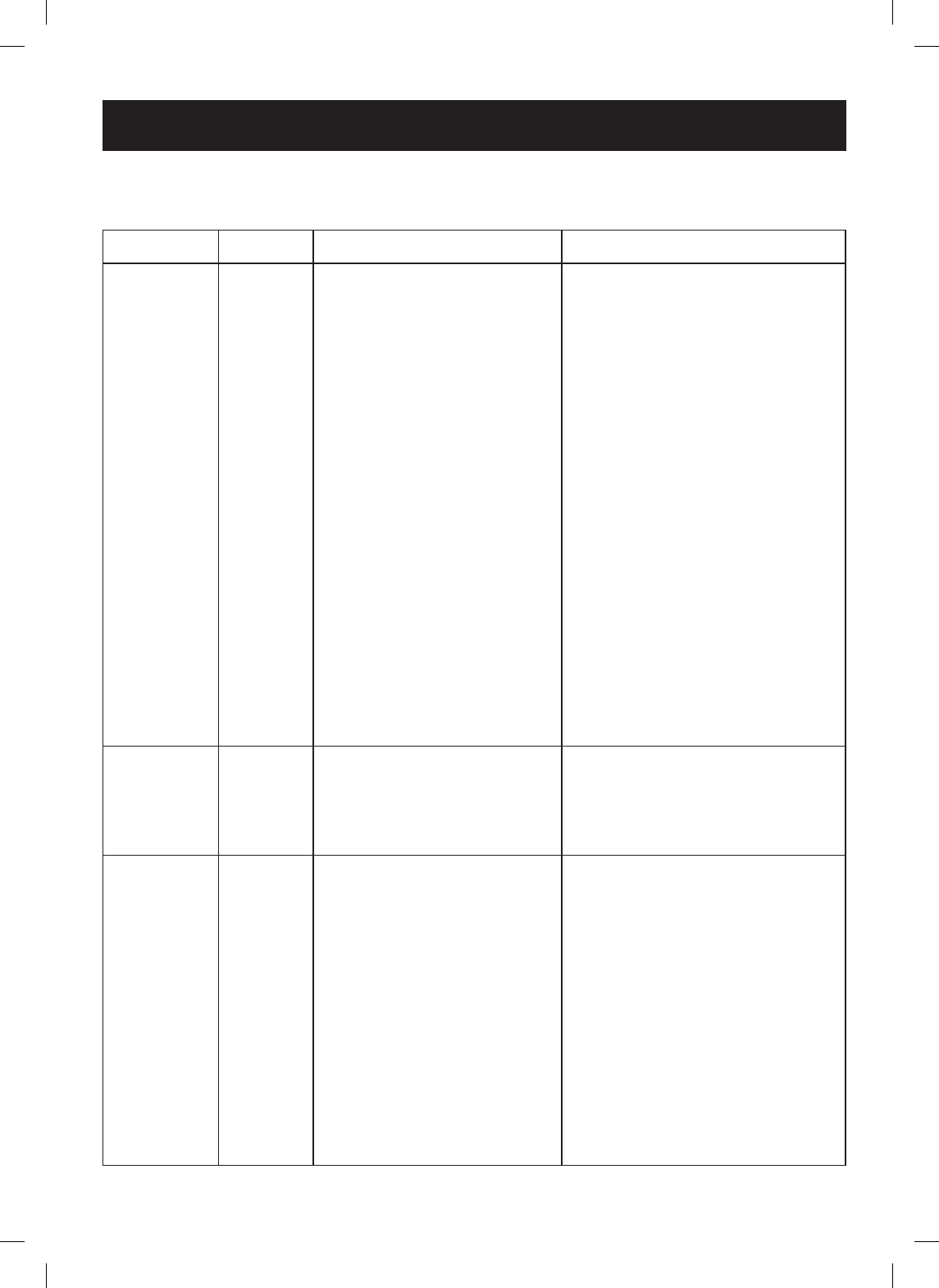
- 29 -
OPERATION
AUTO DEFROST TABLE
Meat setting
FOOD SETTING AT BEEP SPECIAL INSTRUCTIONS
BEEF Meat of irregular shape and large, fatty
cuts of meat should have the narrow
or fatty areas shielded with foil at the
beginning of a defrost sequence.
Ground Beef,
Bulk
MEAT Remove thawed portions with fork
Turn over. Return remainder to
oven.
Do not defrost less than ¼ lb.
Freeze in doughnut shape.
Ground Beef,
Patties
MEAT Separate and rearrange. Do not defrost less than 2 oz. patties.
Depress center when freezing.
Round Steak MEAT Turn over. Cover warm areas with
aluminum foil.
Place on a microwavable roasting rack.
Tenderloin
Steak
MEAT Turn over. Cover warm areas with
aluminum foil.
Place on a microwavable roasting rack.
Stew Beef MEAT Remove thawed portions with fork.
Separate remainder.
Return remainder to oven.
Place in a microwavable baking dish.
Pot Roast,
Chuck Roast
MEAT Turn over. Cover warm areas with
aluminum foil.
Place on a microwavable roasting rack.
Rib Roast MEAT Turn over. Cover warm areas with
aluminum foil.
Place on a microwavable roasting rack.
Rolled Rump
Roast
MEAT Turn over. Cover warm areas with
aluminum foil.
Place on a microwavable roasting rack.
LAMB
Cubes for
Stew
MEAT Remove thawed portions with fork.
Return remainder to oven.
Place in a microwavable baking dish.
Chops
(1 inch thick)
MEAT Separate and rearrange. Place on a microwavable roasting rack.
PORK
Chops
(½ inch thick)
MEAT Separate and rearrange. Place on a microwavable roasting rack.
Hot Dogs MEAT Separate and rearrange. Place on a microwavable roasting rack.
Spareribs
Country-style
Ribs
MEAT Turn over. Cover warm areas with
aluminum foil.
Place on a microwavable roasting rack.
Sausage,
Links
MEAT Separate and rearrange. Place on a microwavable roasting rack.
Sausage,
Bulk
MEAT Remove thawed portions with fork.
Turn over. Return remainder to
oven.
Place in a microwavable baking dish.
Loin Roast,
Boneless
MEAT Turn over. Cover warm areas with
aluminum foil.
Place on a microwavable roasting rack.
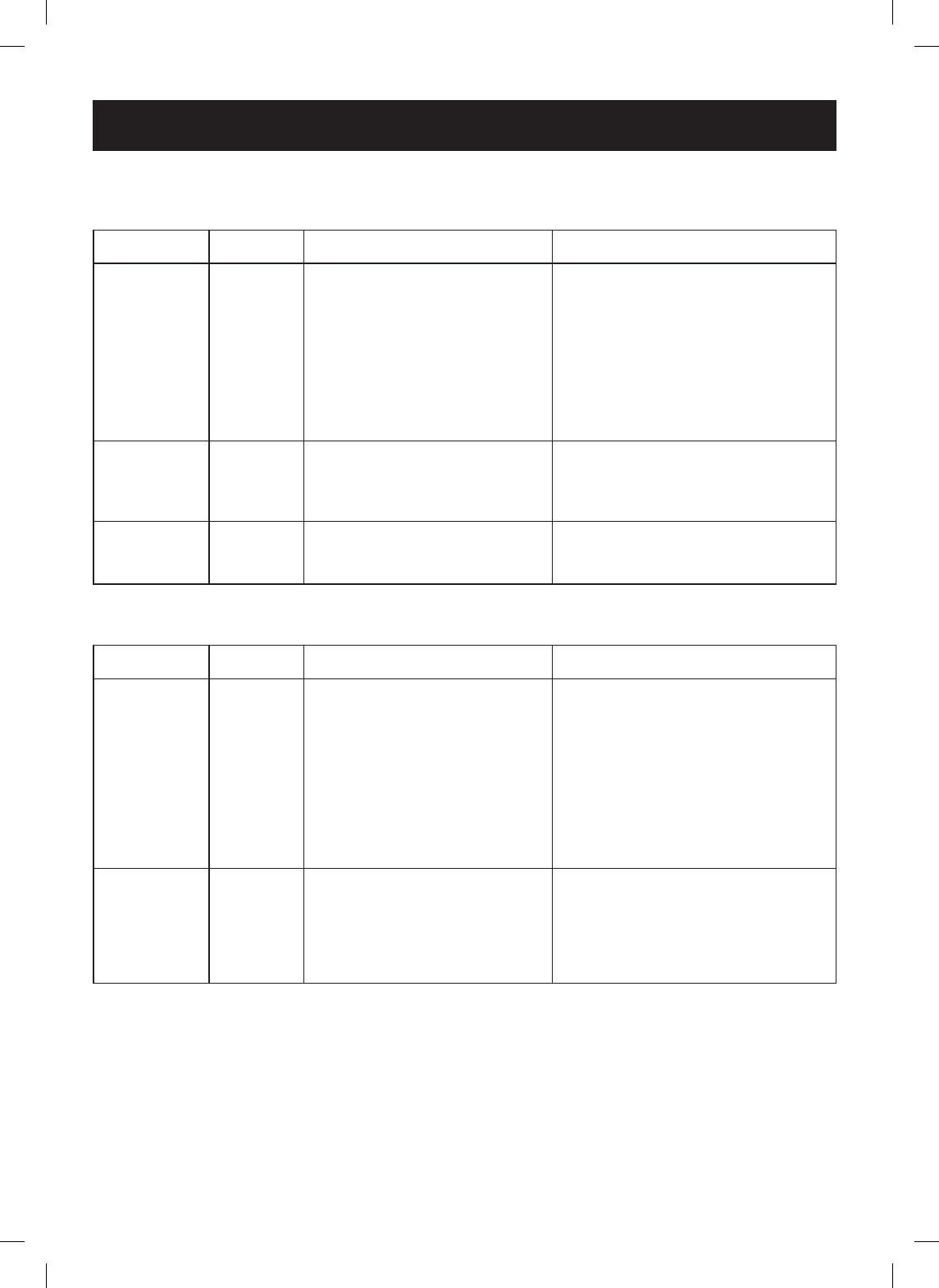
- 30 -
OPERATION
AUTO DEFROST TABLE (CONT.)
Poultry setting
FOOD SETTING AT BEEP SPECIAL INSTRUCTIONS
CHICKEN
Whole
(up to 6 lbs.)
POULTRY Turn over (nish defrosting
breastside down). Cover warm
areas with aluminum foil.
Place chicken breast-side up on a
microwavable roasting rack. Finish
defrosting by immersing in cold water.
Remove giblets when chicken is partially
defrosted.
Cut-up Separate pieces and rearrange. Place on a microwavable roasting rack.
Turn over. Cover warm areas with
aluminum foil.
Finish defrosting by immersing in cold
water.
CORNISH
HENS
Whole
POULTRY Turn over. Cover warm areas with
aluminum foil.
Place on a microwavable roasting rack.
Finish defrosting by immersing in cold
water.
TURKEY
Breast
(up to 6 lbs.)
POULTRY Turn over. Cover warm areas with
aluminum foil.
Place on a microwavable roasting rack.
Finish defrosting by immersing in cold
water.
Fish setting
FOOD SETTING AT BEEP SPECIAL INSTRUCTIONS
FISH
Fillets
FISH Turn over. Separate llets when
partially thawed if possible.
Place in a microwavable baking dish.
Carefully separate llets under cold
water.
Steaks FISH Separate and rearrange. Place in a microwavable baking dish.
Run cold water over to nish defrosting.
Whole FISH Turn over. Place in a microwavable baking dish.
Cover head and tail with foil; do not let
foil touch sides of microwave. Finish
defrosting by immersing in cold water.
SHELLFISH
Crabmeat
Lobster tails
Shrimp
Scallops
FISH
FISH
FISH
FISH
Break apart. Turn over.
Turn over and rearrange.
Separate and rearrange.
Separate and rearrange.
Place in a microwavable baking dish.
Place in a microwavable baking dish.
Place in a microwavable baking dish.
Place in a microwavable baking dish.

- 31 -
OPERATION
AUTO DEFROST TABLE (CONT.)
Bread setting
FOOD SETTING AT BEEP SPECIAL INSTRUCTIONS
BREAD Turn over and rearrange. Place on 3 sheets of paper towel.
Bagel
Dinner Roll
BREAD
BREAD
Note:
Do not use recycled paper products in
the microwave oven. They sometimes
contain impurities that cause arcing and
sparking.
NEVER use paper products in the
convection oven.
DEFROSTING TIPS
• When using Auto Defrost, the weight to be entered
is the net weight in pounds and tenths of pounds (the
weight of the food minus the container).
• Before starting, remove the metal twist-ties which
often come with frozen food bags, and replace them
with strings or elastic bands.
• Open containers such as cartons before they are
placed in the oven.
• Always slit or pierce plastic pouches or packaging.
• If food is foil wrapped, remove foil and place the
food in a suitable container.
• Slit the skins, if any, of frozen food such as sausage.
• Bend plastic pouches of food to ensure even
defrosting.
• Always underestimate defrosting time. If defrosted
food is still icy in the center, return it to the microwave
oven for more defrosting.
• The length of defrosting time varies according to how
solidly the food is frozen.
• The shape of the package affects how quickly
food will defrost. Shallow packages will defrost more
quickly than a deep block.
• As food begins to defrost, separate the pieces
Separated pieces defrost more easily.
• Use small pieces of aluminum foil to shield parts
of food such as chicken wings, leg tips, sh tails, or
areas that start to get warm. Make sure the foil does
not touch the sides, top, or bottom of the oven. The
foil can damage the oven lining.
• For better results, let food stand after defrosting.
(For more information on standing time, see the
Microwave Cooking Tips section.)
• Turn over food during defrosting or standing time
Break apart and remove food as required.
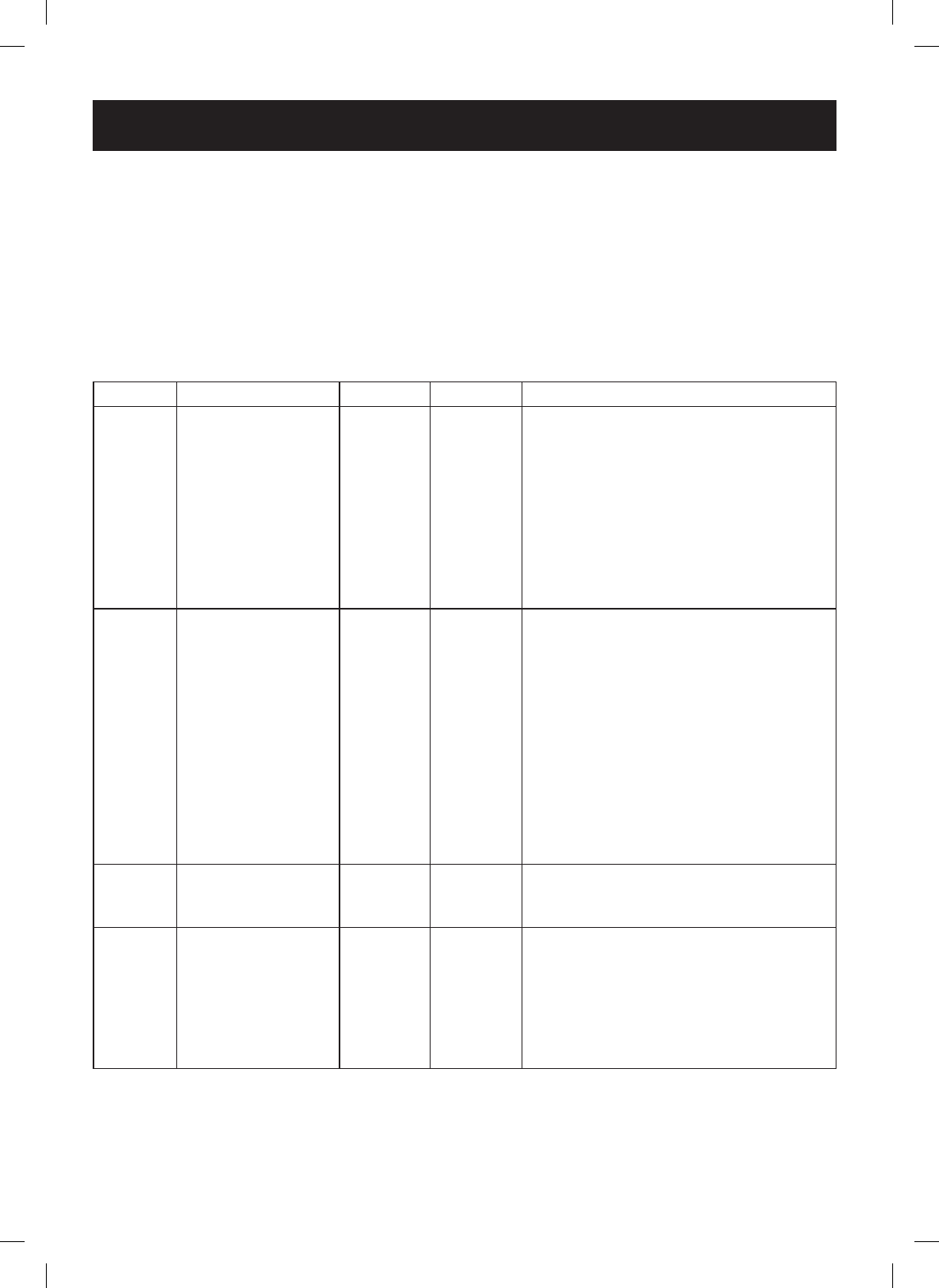
- 32 -
1. Always use the metal rack when convection baking.
Place food directly on rack or place in metal tray and
then place tray on rack.
2. Aluminum pans conduct heat quickly. For most
convection baking, light, shiny nishes give best
results because they prevent overbrowning in the
time it takes to cook the center areas. Pans with dull
(satin-nish) bottoms are recommended for cake
pans and pie pans for best bottom browning.
3. Dark or non-shiny nishes, glass, and pyroceramic
absorb heat which may result in dry, crisp crusts.
4. Preheating the oven is recommended when baking
foods by convection.
5. To prevent uneven heating and save energy, open
the oven door to check food as seldom as possible.
FOOD OVEN TEMP. TIME, MIN. COMMENTS
Breads Refrigerated Biscuits
Corn Bread
Mufns
Popovers
Nut Bread or Fruit
Bread
Yeast Bread
Plain or Sweet Rolls
375°F
350°F
425°F
325°F
325°F
375°F
350°F
11 to 14
35 to 40
18 to 22
45 to 55
60 to 70
16 to 23
13 to 16
Allow additional time for large biscuits.
Remove from pans immediately and cool
slightly on wire rack.
Pierce each popover with a fork after removing
from oven to allow steam to escape.
Interiors will be moist and tender.
Lightly grease baking sheet.
Cakes Devil’s Food
Fudge brownies
Coffee Cake
Cup Cakes
Fruit Cake (loaf)
Gingerbread
Butter Cakes, Cake
Mixes
9 x 13 inch
Tube Cake
Pound Cake
350°F
350°F
325°F
325°F
275°F
300°F
325°F
325°F
325°F
325°F
35 to 40
26 to 30
30 to 35
20 to 25
90 to 100
25 to 30
35 to 45
35 to 45
30 to 40
45 to 55
Place cake pan on rack.
Bake 2 layers of brownies at a time.
Interior will be moist and tender.
Turn end for end half way through baking.
Grease and our pan.
Cool in pan 10 minutes before inverting on
wire rack.
Cookies Chocolate Chip
Sugar
350°F
350°F
11 to 14
11 to 14
Place metal tray on rack. Allow extra time for
frozen cookie dough.
Place metal tray on rack.
Fruits,
Other
Desserts
Baked Apples or Pears
Bread Pudding
Cream Puffs
Meringue Shells
350°F
300°F
400°F
300°F
35 to 40
35 to 40
30 to 35
30 to 35
Bake in cookware with shallow sides.
Pudding is done when knife inserted near
center comes out clean.
Puncture puffs twice with toothpick to release
steam after 25 minutes of baking time.
When done, turn oven off and let shells stand
in oven 1 hour to dry.
Notes:
• The oven temperature indicated in the chart above is recommended over the package instruction temperature.
• The baking time in the chart above is only a guideline for reference. Adjust time according to the food condition
or your preference. Check doneness at the minimum time.
COOKING GUIDE
CONVECTION BAKING GUIDELINES
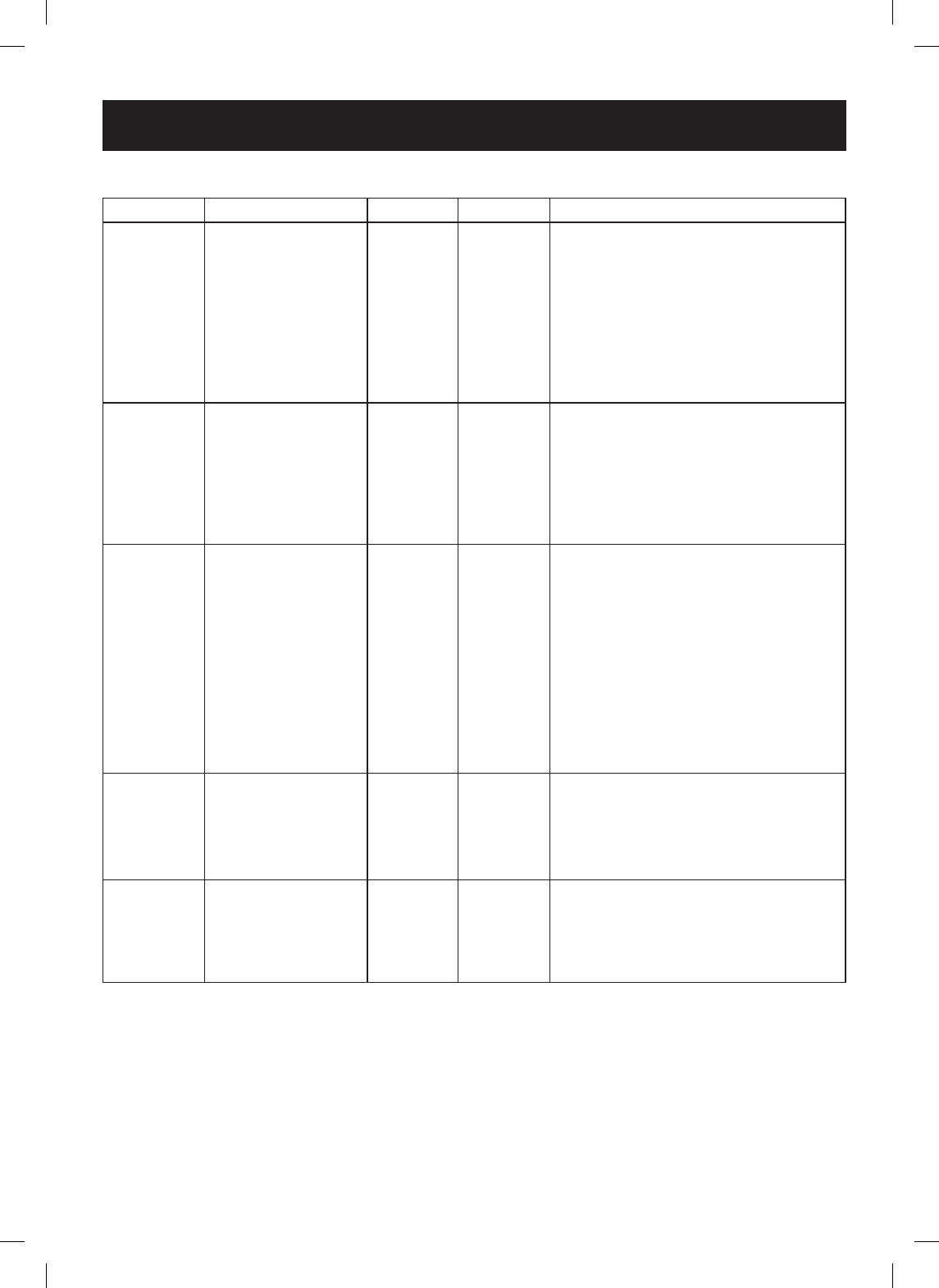
- 33 -
CONVECTION BAKING GUIDELINES (CONT'D)
FOOD OVEN TEMP. TIME, MIN. COMMENTS
Pies,
Pastries
Frozen Pie
Meringue-Topped
Two-Crust
Quiche
Pastry Shell
400°F
450°F
400°F
350°F
400°F
50 to 60
9 to 11
50 to 55
30 to 35
10 to 16
Place metal tray on rack and place in cold
oven. Preheat oven, tray and rack to 400°F.
When preheated, place frozen pie on metal
tray and bake according to package time or
until crust is browned and lling is hot.
Follow package directions for preparation.
Follow package directions for preparation.
Let stand 5 minutes before cutting.
Pierce pastry with fork to prevent shrinkage.
Casseroles Meat, Chicken,
Seafood Combinations
Pasta
Potatoes, scalloped
Vegetable
350°F
350°F
350°F
350°F
20 to 40
25 to 45
55 to 60
25 to 35
Cook times vary with casserole size and
ingredients.
Cook times vary with casserole size and
ingredients.
Let stand 5 minutes before serving.
Cook times vary with casserole size and
ingredients.
Convenience
Foods
Frozen Bread Dough
Frozen Entrée
Frozen Pizza Rising
Crust
Frozen Pizza
French Fries Crinkle
Cut
Frozen Wafe
Frozen Cheese Sticks
Frozen Turnovers
350°F
325°F
400°F
400°F
450°F
400°F
450°F
450°F
30 to 35
70 to 80
25 to 35
17 to 21
15 to 19
5 to 7
6 to 8
18 to 22
Follow package directions for preparation.
Follow package directions for preparation.
Follow package directions for preparation.
Pizza should not extend over the rack.
Follow package directions for preparation.
Pizza should not extend over the rack.
Follow package directions for preparation.
Follow package directions for preparation.
Follow package directions for preparation.
Follow package directions for preparation.
Main Dishes Meat Loaf
Oven-Baked Stew
Swiss Steak
Stuffed Peppers
400°F
325°F
350°F
350°F
30 to 40
80 to 90
60 to 70
40 to 45
Let stand 5 minutes after cooking.
Brown meat before combining with liquid
and vegetables.
Let stand 2 minutes after cooking.
Use green, red, or yellow peppers.
Vegetables Acorn Squash Halves
Baked Potatoes
Twice-Baked Potatoes
375°F
425°F
400°F
55 to 60
50 to 60
25 to 30
Pierce skin in several places. Add ½ cup
water to dish. Turn squash halves cut side
up after 30 minutes of cook time and cover.
Pierce skin with fork before baking.
Pierce skin with fork before baking.
Notes:
• The oven temperature indicated in the chart above is recommended over the package instruction temperature.
• The baking time in the chart above is only a guideline for reference. Adjust time according to the food condition
or your preference. Check doneness at the minimum time.
COOKING GUIDE
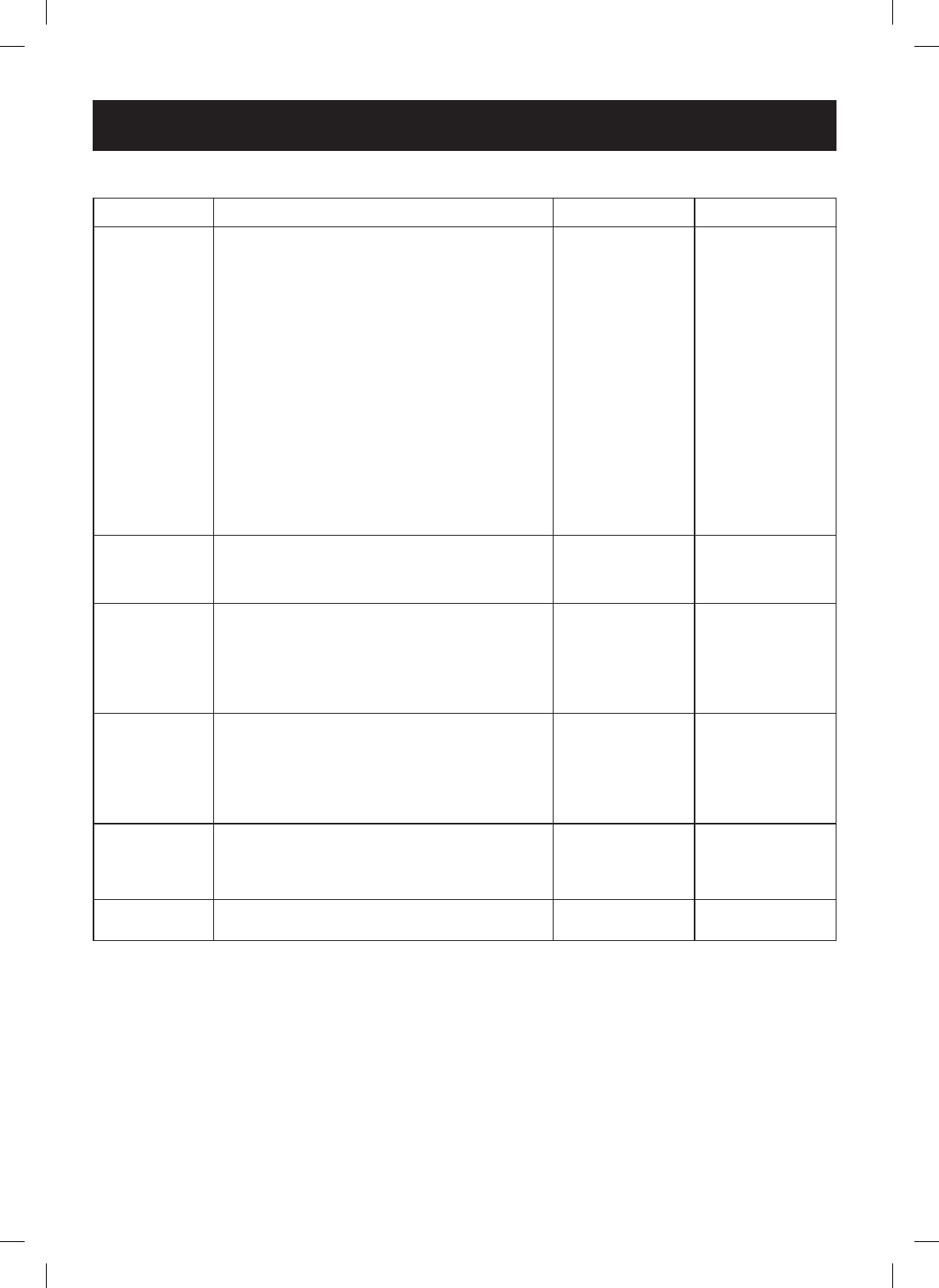
- 34 -
MEAT ROASTING GUIDELINES FOR CONVECTION COOKING
FOOD OVEN TEMP. TIME, MIN./LB.
Beef Ribs (2 to 4 lbs.)
Rare
Medium
Well
Boneless Ribs, Top Sirloin
Rare
Medium
Well
Beef Tenderloin
Rare
Medium
Pot Roast (2½ to 3 lbs.)
Chuck, Rump
Meat Loaf (2 lbs.)
300°F
300°F
300°F
300°F
300°F
300°F
300°F
300°F
300°F
400°F
45 to 50
50 to 55
55 to 60
53 to 58
58 to 63
63 to 68
28 to 32
32 to 36
83 to 88
65 to 75
Ham Canned (3-lb. fully cooked)
Butt (5-lb. fully cooked)
Shank (5-lb. fully cooked)
325°F
325°F
325°F
20 to 25
20 to 25
17 to 20
Lamb Bone-in (2 to 4 lbs.)
Medium
Well
Boneless (2 to 4 lbs.)
Medium
Well
300°F
300°F
300°F
300°F
42 to 47
47 to 52
50 to 55
55 to 60
Pork Bone-in (2 to 4 lbs.)
Boneless (2 to 4 lbs.)
Pork Chops (½ to 1-inch thick)
2 chops
4 chops
6 chops
300°F
300°F
325°F
325°F
325°F
48 to 52
56 to 61
42 to 45
45 to 48
48 to 55
Poultry Whole Chicken (2½ to 3½ lbs.)
Chicken Pieces (2½ to 3½ lbs.)
Duckling (4 to 5 lbs.)
Turkey Breast (4 to 6 lbs.)
375°F
425°F
375°F
325°F
25 to 35
10 to 12
19 to 21
21 to 25
Seafood Fish, whole (3 to 5 lbs.)
Lobster Tails (6 to 8-oz. each)
400°F
350°F
13 to 18
12 to 17
Note:
• The roasting time in the chart above is only a guideline for reference. Adjust time according to the food condition
or your preference. Check doneness at the minimum time.
COOKING GUIDE
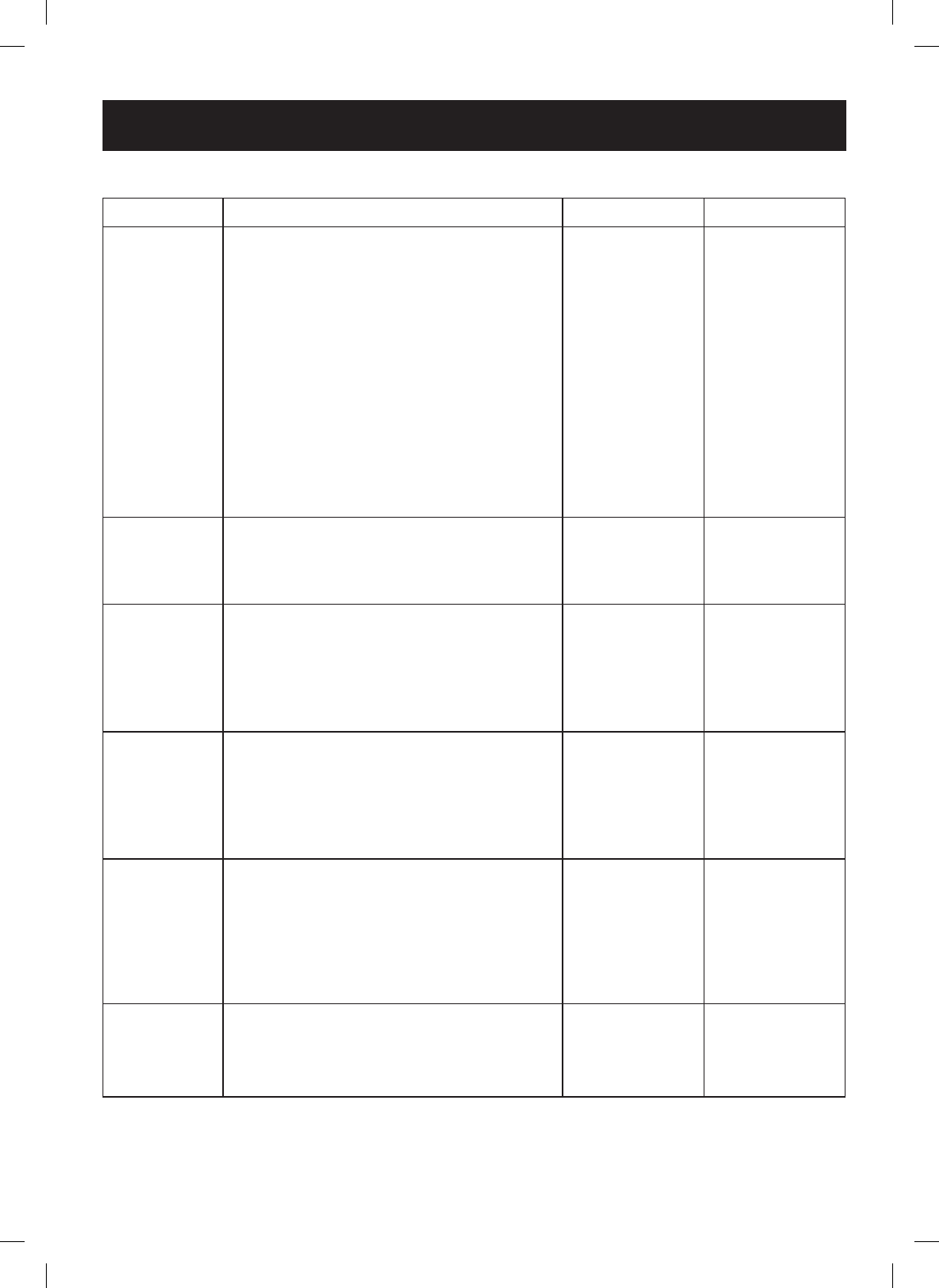
- 35 -
COMBINATION ROAST COOKING GUIDE
FOOD OVEN TEMP. TIME, MIN./LB.
Beef Turn over after half of cooking time.
Ribs (2 to 4 lbs.)
Rare
Medium
Well
Boneless Ribs, Top Sirloin
Rare
Medium
Well
Beef Tenderloin
Rare
Medium
Chuck, Rump or Pot Roast (2½ to 3 lbs.)
(Use cooking bag for best results.)
375°F
375°F
375°F
375°F
375°F
375°F
375°F
375°F
300°F
9 to 13
11 to 15
13 to 17
9 to 13
11 to 15
13 to 17
16 to 18
18 to 20
18 to 20
Ham Turn over after half of cooking time.
Canned (3-lb. fully cooked)
Butt (5-lb. fully cooked)
Shank (5-lb. fully cooked)
300°F
300°F
300°F
15 to 18
15 to 18
15 to 18
Lamb Turn over after half of cooking time.
Bone-in (2 to 4 lbs.)
Medium
Well
Boneless (2 to 4 lbs.)
Medium
Well
300°F
300°F
300°F
300°F
13 to 18
18 to 23
14 to 19
19 to 24
Pork Turn over after half of cooking time.
Bone-in (2 to 4 lbs.)
Boneless (2 to 4 lbs.)
Pork Chops (¾ to 1-inch thick)
2 chops
4 chops
6 chops
300°F
300°F
350°F
305°F
305°F
17 to 20
19 to 22
10 to 13
13 to 16
16 to 19
Poultry Turn over after half of cooking time.
Whole Chicken (2½ to 6 lbs.)
Chicken Pieces (2½ to 6 lbs.)
Cornish Hens (untied)
Unstuffed
Stuffed
Duckling
Turkey Breast (4 to 6 lbs.)
375°F
375°F
425°F
375°F
375°F
300°F
15 to 17
15 to 18
15 to 18
22 to 25
15 to 18
11 to 15
Seafood Fish
1-lb. llets
Lobster Tails (6 to 8-oz. each)
Shrimp (1 to 2 lbs.)
Scallops (1 to 2 lbs.)
350°F
350°F
350°F
350°F
7 to 10
10 to 15
9 to 14
8 to 13
Note:
• The roasting time in the chart above is only a guideline for reference. Adjust time according to the food condition
or your preference. Check doneness at the minimum time.
COOKING GUIDE

- 36 -
COMBINATION BAKE COOKING GUIDE
FOOD OVEN TEMP. TIME, MIN. COMMENTS
Pies,
Pastries
Quiche 425°F 15 to 17 Let stand 5 minutes before cutting.
Convenience
Foods
Frozen Entrée
Frozen Pizza
Rolls, Egg Rolls
Pizza
375°F
450°F
450°F
39 to 43
4 to 6
23 to 26
Follow package directions for preparation.
Follow package directions for preparation.
Follow package directions for preparation.
Vegetables Baked Potatoes 450°F 36 to 40 Pierce skin with a fork before baking.
Place on rack.
COOKING GUIDE
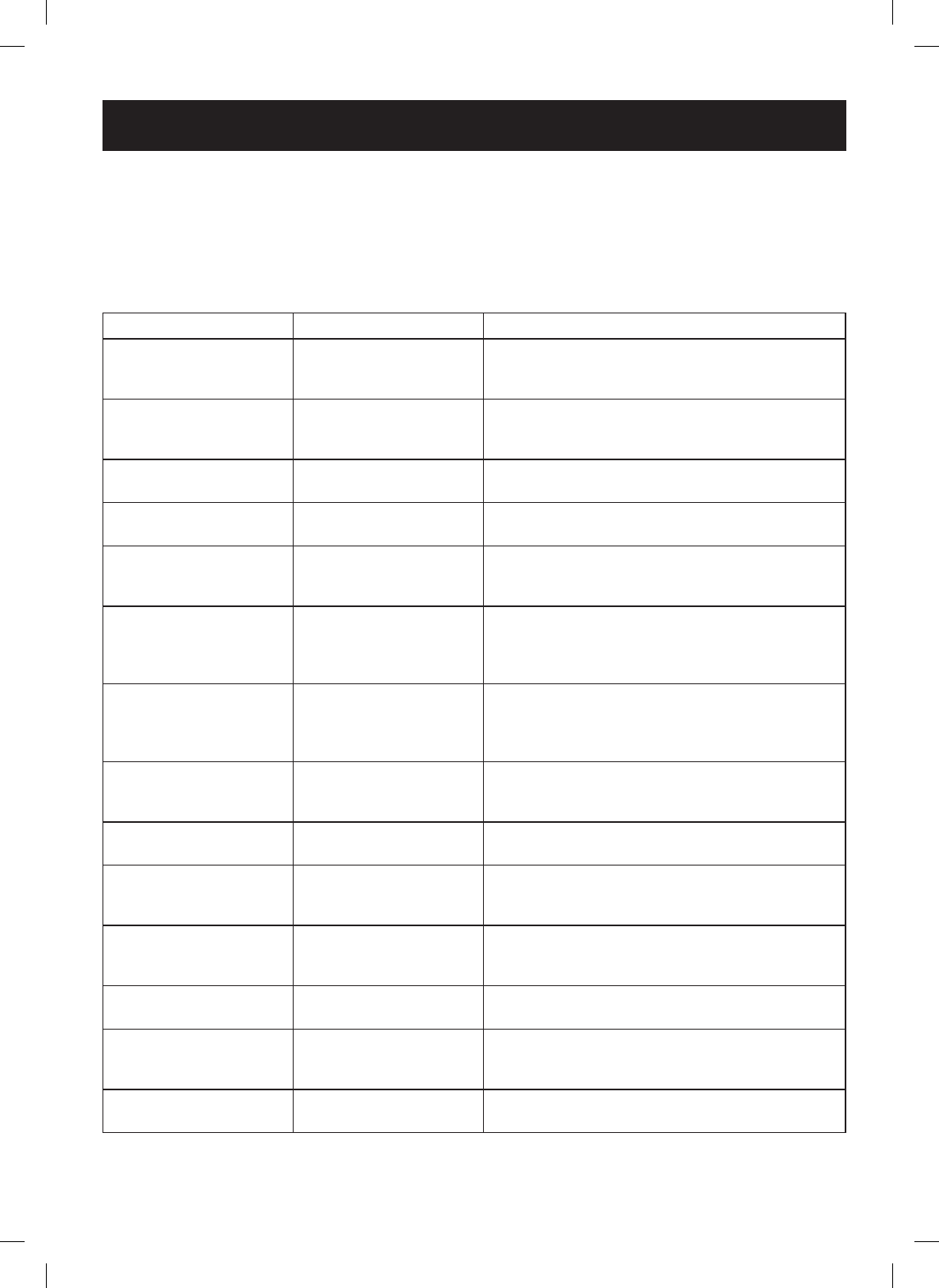
- 37 -
HEATING/REHEATING GUIDE
To heat or reheat successfully in a microwave oven, follow these guidelines: Measure the amount of food in order
to determine the time needed to reheat. Arrange the food in a circular pattern for best results. Room temperature
food will heat faster than refrigerated food. Canned foods should be taken out of the can and placed in a
microwave-safe container. The food will heat more evenly if covered with a microwave-safe lid or vented plastic
wrap. Remove the cover carefully to prevent steam burns. Use the following chart as a guide for reheating cooked
food.
ITEMS COOK TIME (AT HIGH) SPECIAL INSTRUCTIONS
Sliced meat
3 slices (¼ -inch thick)
1 - 2 minutes Place sliced meat on microwavable plate.
Cover with plastic wrap and vent.
Note: Gravy or sauce helps to keep meat juicy.
Chicken pieces
1 breast
1 leg and thigh
2 - 3½ minutes
1½ - 3 minutes
Place chicken pieces on microwavable plate.
Cover with plastic wrap and vent.
Fish llet
(6 - 8 oz.)
2 - 4 minutes Place sh on microwavable plate.
Cover with plastic wrap and vent.
Lasagna
1 serving (10½ oz.)
4 - 6 minutes Place lasagna on microwavable plate.
Cover with plastic wrap and vent.
Casserole
1 cup
4 cups
1 - 3½ minutes
5 - 8 minutes
COOK covered in microwavable casserole.
Stir once halfway through cooking.
Casserole – cream or
cheese
1 cup
4 cups
1½ - 3 minutes
3½ - 5½ minutes
COOK covered in microwavable casserole.
Stir once halfway through cooking.
Sloppy Joe or
Barbecued Beef
1 sandwich (½ cup
meat lling)without bun
1 - 2½ minutes
Reheat lling and bun separately.
Cook lling covered in microwavable casserole.
Stir once.
Heat bun as directed in chart below.
Mashed potatoes
1 cup
4 cups
1 - 3 minutes
5 - 8 minutes
COOK covered in microwavable casserole.
Stir once halfway through cooking.
Baked beans
1 cup 1½ - 3 minutes
COOK covered in microwavable casserole.
Stir once halfway through cooking.
Ravioli or pasta in sauce
1 cup
4 cups
2½ - 4 minutes
7½ - 11 minutes
COOK covered in microwavable casserole.
Stir once halfway through cooking.
Rice
1 cup
4 cups
1½ - 3½ minutes
4 - 6½ minutes
COOK covered in microwavable casserole.
Stir once halfway through cooking.
Sandwich roll or bun
1 roll 15 - 30 seconds
Wrap in paper towel and place on glass microwavable
rack.
Vegetables
1 cup
4 cups
1½ - 2½ minutes
4 - 6 minutes
COOK covered in microwavable casserole.
Stir once halfway through cooking.
Soup
1 serving (8 oz.) 1½ - 2½ minutes
COOK covered in microwavable casserole.
Stir once
COOKING GUIDE
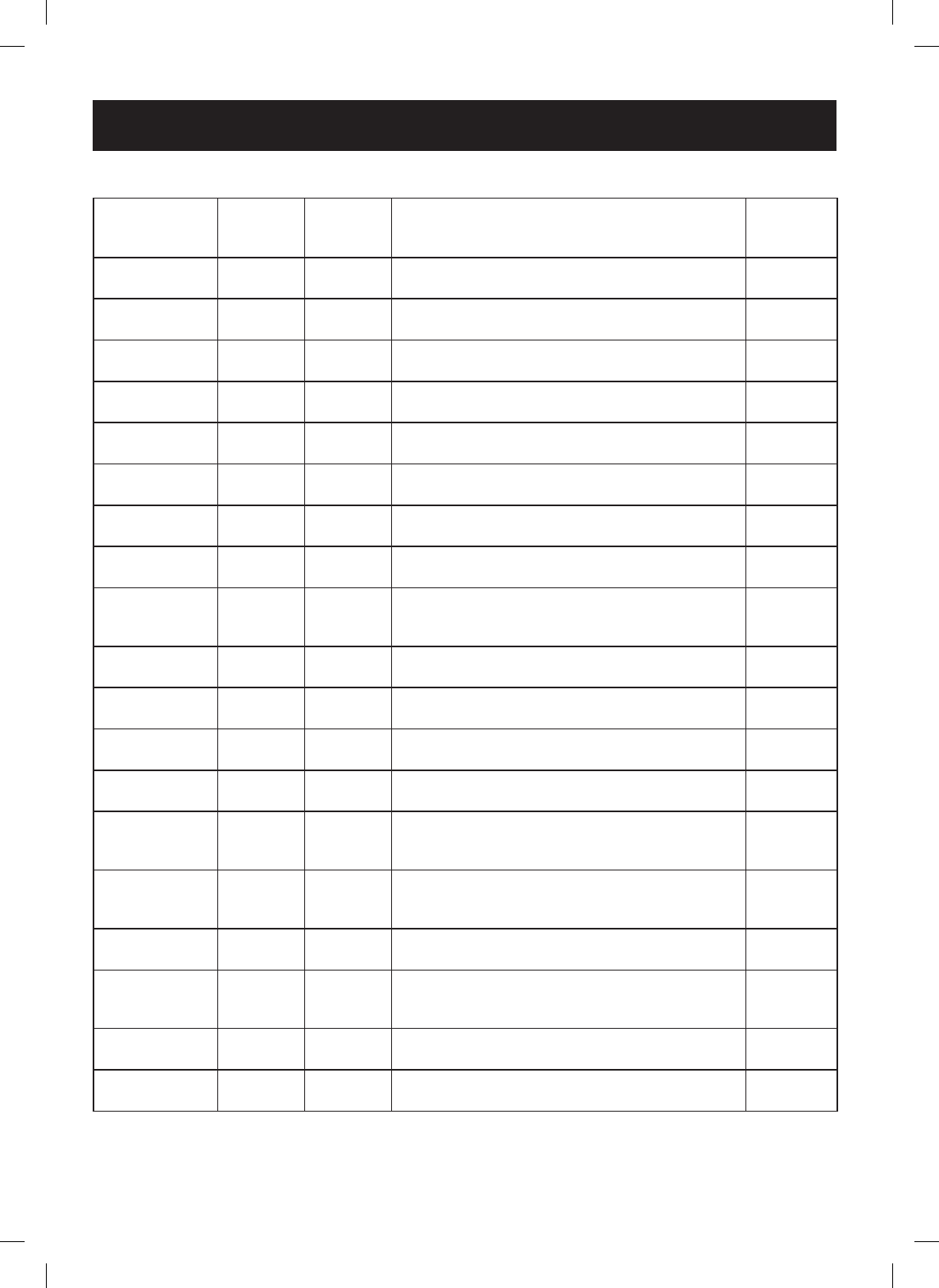
- 38 -
FRESH VEGETABLE GUIDE
VEGETABLE AMOUNT
COOK TIME
AT HIGH
(MINUTE)
INSTRUCTIONS STANDING
TIME
Artichokes
(8 oz.each)
2 medium
4 medium
5 - 8
10 - 13
Trim. Add 2 tsp water and 2 tsp juice. Cover.
2 - 3 minutes
Asparagus,
Fresh, Spears
1 Ib. 3 - 6 Add ½ cup water. Cover.
2 - 3 minutes
Beans, Green
and Wax
1 Ib. 7 - 11 Add ½ cup water in 1½ qt. casserole. Stir halfway
through cooking.
2 - 3 minutes
Beets, Fresh 1 Ib. 12 - 16 Add ½ cup water in 1½ qt. covered casserole.
Rearrange halfway through cooking.
2 - 3 minutes
Broccoli, Fresh,
Spears
1 Ib. 4 - 8 Place broccoli in baking dish. Add ½ cup water.
2 - 3 minutes
Cabbage,
Fresh, Chopped
1 Ib. 4 - 7 Add ½ cup water in 1½ qt. covered casserole.
Stir halfway through cooking.
2 - 3 minutes
Carrots, Fresh,
Sliced
2 cups 2 - 4 Add ¼ cup water in 1 qt. covered casserole. Stir
halfway through cooking.
2 - 3 minutes
Cauliower,
Fresh, Whole
1 lb. 7 - 11 Trim and add ¼ cup water in 1 qt. covered casserole.
Stir halfway through cooking.
2 - 3 minutes
Flowerettes,
Fresh Celery,
Fresh, Sliced
2 cups
4 cups
2½ - 4½
6 - 8
Slice and add ½ cup water in 1½ qt. covered
casserole. Stir halfway through cooking.
2 - 3 minutes
Corn, Fresh 2 ears 5 - 9 Husk and add 2 tbsp water in 1½ qt. baking dish.
Cover.
2 - 3 minutes
Mushrooms,
Fresh, Sliced
½ Ib. 2 - 3½ Place mushrooms in 1½ qt. covered casserole.
Stir halfway through cooking.
2 - 3 minutes
Parsnips,
Fresh, Sliced
1 Ib. 4 - 8 Add ½ cup water in 1½ qt. covered casserole.
Stir halfway through cooking.
2 - 3 minutes
Peas, Green,
Fresh
4 cups 7 - 10 Add ½ cup water in 1½ qt. covered casserole.
Stir halfway through cooking.
2 - 3 minutes
Sweet Potatoes
Whole Baking
(6-8 oz.each)
2 medium
4 medium
5 - 10
7 - 13
Pierce potatoes several times with fork.
Place on 2 paper towels.
Turn over halfway through cooking.
2 - 3 minutes
2 - 3 minutes
White Potatoes,
Whole Baking
(6-8 oz.each)
2 potatoes
4 potatoes
5 - 8
10 - 14
Pierce potatoes several times with fork.
Place on 2 paper towels.
Turn over halfway through cooking.
2 - 3 minutes
2 - 3 minutes
Spinach, Fresh,
Leaf
1 Ib. 4 - 7 Add ½ cup water in 2 qt. covered casserole.
2 - 3 minutes
Squash, Acorn
or Butternut,
Fresh
1 medium 6 - 8 Cut squash in half. Remove seeds.
Place in 8 x 8-inch baking dish. Cover.
2 - 3 minutes
Zucchini, Fresh,
Sliced
1 Ib. 4½ - 7½ Add ½ cup water in 1½ qt. covered casserole.
Stir halfway through cooking.
2 - 3 minutes
Zucchini, Fresh,
Whole
1 Ib. 6 - 9 Pierce. Place on 2 paper towels. Turn over and
rearrange halfway through cooking.
2 - 3 minutes
COOKING GUIDE

- 39 -
SMART FEATURES
1. a wireless router and home Wi-Fi network.
2. the SIGNATURE KITCHEN SUITE microwave oven.
3. an Android-based smart phone.
4. the SIGNATURE KITCHEN SUITE app from the Google
Play Store.
PRODUCT REGISTRATION
The Smart Features allows you to conveniently us
SIGNATURE KITCHEN SUITE Smart Diagnosis™, set
cook mode and communicate with the appliance usi
smart phone. To use the Smart Features, you will need
the following devices and apps:
1 Search for the SIGNATURE KITCHEN SUITE
application from the Google Play Store on a smart
phone. And run the SIGNATURE KITCHEN SUITE
application on a smart phone.
2 Create an account and sign in.
4 Select Microwave oven.
5
7The app will automatically go through the process of
registering your product on the network, using the
information you’ve provided. This may take some
time, and the Connect Icon ( ) will continue to
blink during this process. After the registration
process is completed, a message is displayed and the
app will proceed to the product state.
Check the Wi-Fi connection. After connecting, Wi-Fi
Connecting Icon ( ) is displayed.
•SIGNATURE KITCHEN SUITE is not responsible for
any network connection problems or any faults,
malfunctions, or errors caused by network connection.
•The machine supports 2.4 Ghz Wi-Fi networks only.
•If the appliance is having trouble connecting to the
Wi-Fi network, it may be too far from the router.
Purchase a Wi-Fi repeater (range extender) to
improve the Wi-Fi signal strength.
•The Wi-Fi connection may not connect or may be
interrupted because of the home network environment.
•The network connection may not work properly
depending on the internet service provider.
•The surrounding wireless environment can make
the wireless network service run slowly.
•This information is current at the time of publication.
The application is subject to change for product
improvement purposes without notice to users.
Choose your home wireless router from the list of
routers in the app. If necessary, enter the password for
your router and click the connect button in the app.
6Press and hold the Auto Timeset
button on the controller for three
seconds. The Connect Icon ( )
should blink while the connection is
being made.
8
3 Select Register.
USING THE APPLICATION - WHAT'S
INCLUDED
COOK SETTINGS
Allows you to set cook mode, power level, temperature
and cook time in the app. Contained kitchen timer,
favorite my recipes functions.
MONITORING
This function helps you recognize the current status,
remaining time, cook settings and end time on the screen.
INTERWORKING FUNCTION
It provides an interworking function that automatically
On/Off the Vent Fan & Cooktop Lamp with other
SIGNATURE KITCHEN SUITE's Cooktop products. If you
wish using a feature that interwork with Cooktop
product, it must be registered to SIGNATURE KITCHEN
SUITE Application. And connected product must contain
the interworking function.
PUSH ALERT
Once the push alert is turned on, the current status of the
appliance is informed. The alert is activated when
SIGNATURE KITCHEN SUITE application is on or not.
SMART DIAGNOSIS
Allows you to diagnose and troubleshoot problems with
your microwave oven.
SETTING
Allows you to set various options on the microwave
oven and in the application.
BEFORE USING SMART FEATURES
•
NOTE
NOTE
Microwave oven is not cook start or stop in used
application.

- 40 -
SMART FEATURES
FCC Statement:
This device complies with Part 15 of the FCC Rules.
Operation is subject to the following two conditions: (1)
this device may not cause harmful interference, and
(2) this device must accept any interference received,
including interference that may cause undesired
operation.
Any changes or modications not expressly approved
by the party responsible for compliance could void the
user’s authority to operate this equipment.
This equipment has been tested and found to comply
with the limits for a Class B digital device, pursuant to
part 15 of the FCC Rules. These limits are designed
to provide reasonable protection against harmful
interference in a residential installation. This equipment
generates, uses and can radiate radio frequency energy
and, if not installed and used in accordance with the
instructions, may cause harmful interference to radio
communications. However, there is no guarantee that
interference will not occur in a particular installation.
If this equipment does cause harmful interference to
radio or television reception, which can be determined
by turning the equipment off and on, the user is
encouraged to try to correct the interference by one or
more of the following measures:
- Increase the separation between the equipment and
receiver.
- Connect the equipment into an outlet on a circuit
different from that to which the receiver is connected.
- Consult the dealer or an experienced radio/TV
technician for help.
- Reorient or relocate the receiving antenna.
OPEN SOURCE SOFTWARE
NOTICE
To obtain the source code under GPL, LGPL, MPL and
other open source licenses, that is contained in this
product, please visit http://opensource.lge.com.
In addition to the source code, all referred license
terms, warranty disclaimers and copyright notices are
available for download.
SIGNATURE KITCHEN SUITE will also provide open
source code to you on CD-ROM for a charge covering
the cost of performing such distribution (such as the
cost of media, shipping and handling) upon email
request to opensource@ lge.com. This offer is valid for
three (3) years from the date on which you purchased
the product.
FCC RF Radiation Exposure Statement: This equipment
complies with FCC radiation exposure limits set forth
for an uncontrolled environment. This equipment should
be installed and operated with minimum distance 20 cm
between the radiator and your body. End users must
follow the specic operating instructions for satisfying
RF exposure compliance.
This transmitter must not be co-located or operating in
conjunction with any other antenna or transmitter.
Responsible Party:
LG Electronic USA, Inc.
1000 Sylvan Avenue Englewood Cliffs, NJ 07632
TEL. : +1-800-243-0000
RF Module's Specication
Standard IEEE 802.11b/g/n wireless LAN + MCU
IEEE 802.11b/g/n HT20 single band WLAN
Infrastructure
Host
interface
UART
Frequency
range
2.400 - 2.483 GHz
Security WFA, WPA, WPA2, WEP, WAPI, TKIP
Output
power
IEEE802.11b: 17 dBm
IEEE802.11g: 14 dBm
IEEE802.11gn: (2.4 GHz) 13 dBm
Data rate IEEE802.11b: 1, 2, 5.5, 11 Mbps
IEEE802.11g: 6, 9, 12, 18, 24, 36, 48, 54
Mbps
IEEE802.11gn: 6.5, 13, 19.5, 26, 39, 52,
58.5, 65 Mbps
Sensitivity IEEE802.11b: - 88 dBm
IEEE802.11g: - 73 dBm
IEEE802.11gn: - 68 dBm
REGULATION NOTICE FOR TRANSMITTER MODULE CONTAINED
IN MICROWAVE OVEN
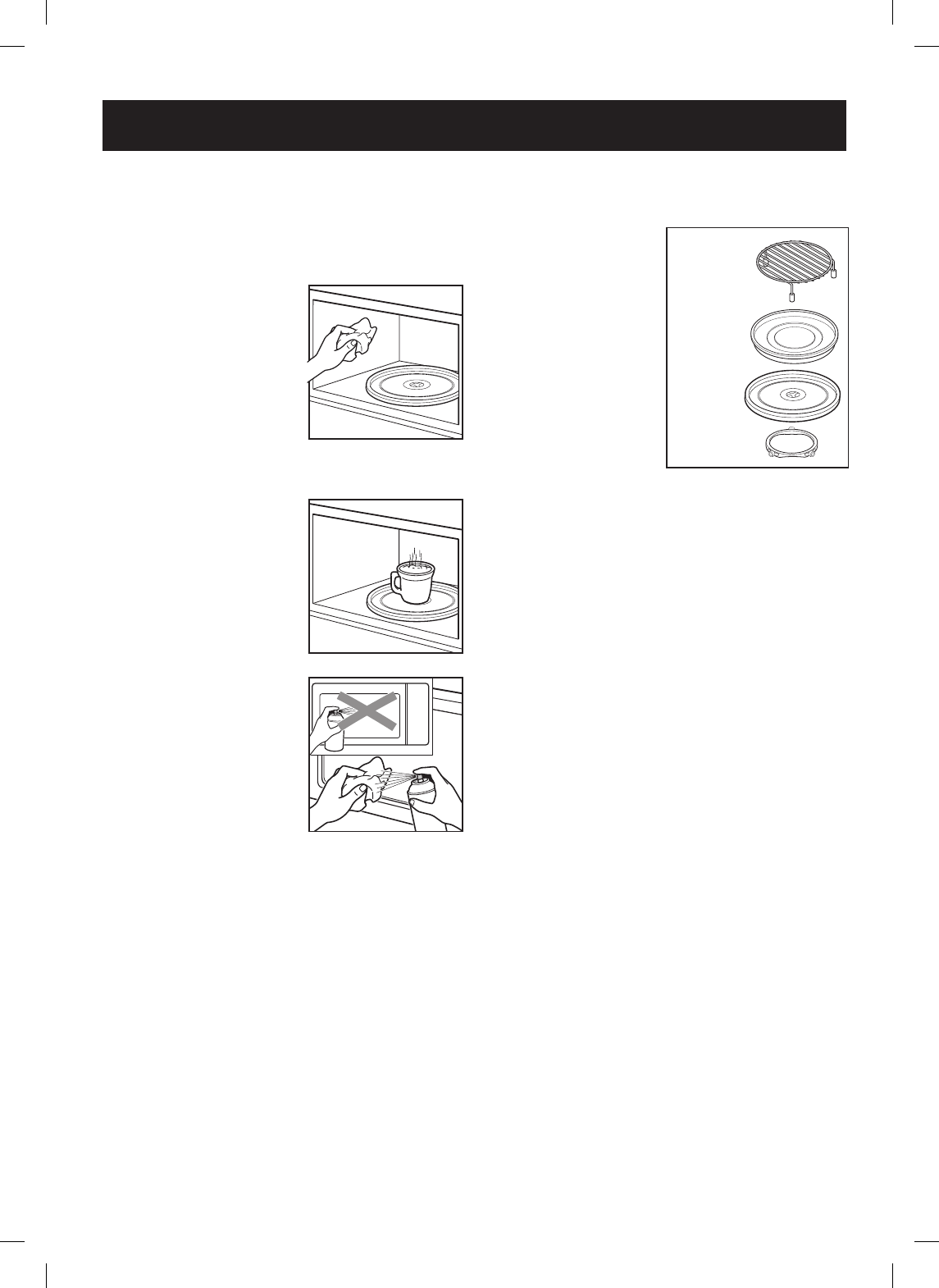
- 41 -
MAINTENANCE
CARING FOR YOUR
MICROWAVE OVEN
To make sure the microwave oven looks good and
works well for a long time, maintain it properly. For
proper care, follow these instructions carefully.
For interior surfaces: Wash
often with warm, sudsy water
and a sponge or soft cloth. Use
only mild, nonabrasive soaps
or a mild detergent. Keep the
areas clean where the door
and oven frame touch when
closed.
Wipe well with a clean cloth.
Over time, stains can occur on the surfaces as the
result of food particles spattering during cooking.
This is normal.
For stubborn soil, boil a cup of
water in the oven for 2 to 3
minutes. Steam will soften the
soil. To get rid of odors inside
the oven, boil a cup of water
with some lemon juice or
vinegar in it.
For exterior surfaces and
control panel: Use a soft cloth
sprayed with glass cleaner.
Apply the glass cleaner to the
soft cloth; do not spray directly
on the oven.
Note: Abrasive cleansers,
steel wool pads, gritty wash
cloths, some paper towels,
etc., can damage the control panel and the interior and
exterior oven surfaces.
To clean the glass tray
and rotating ring, wash in
mild, sudsy water.
For heavily soiled areas
use a mild cleanser and
scouring sponge.
The glass tray and rotating
ring are dishwasher safe.
Metal
Rack
Metal
Tray
Glass
Tray
Rotating
Ring
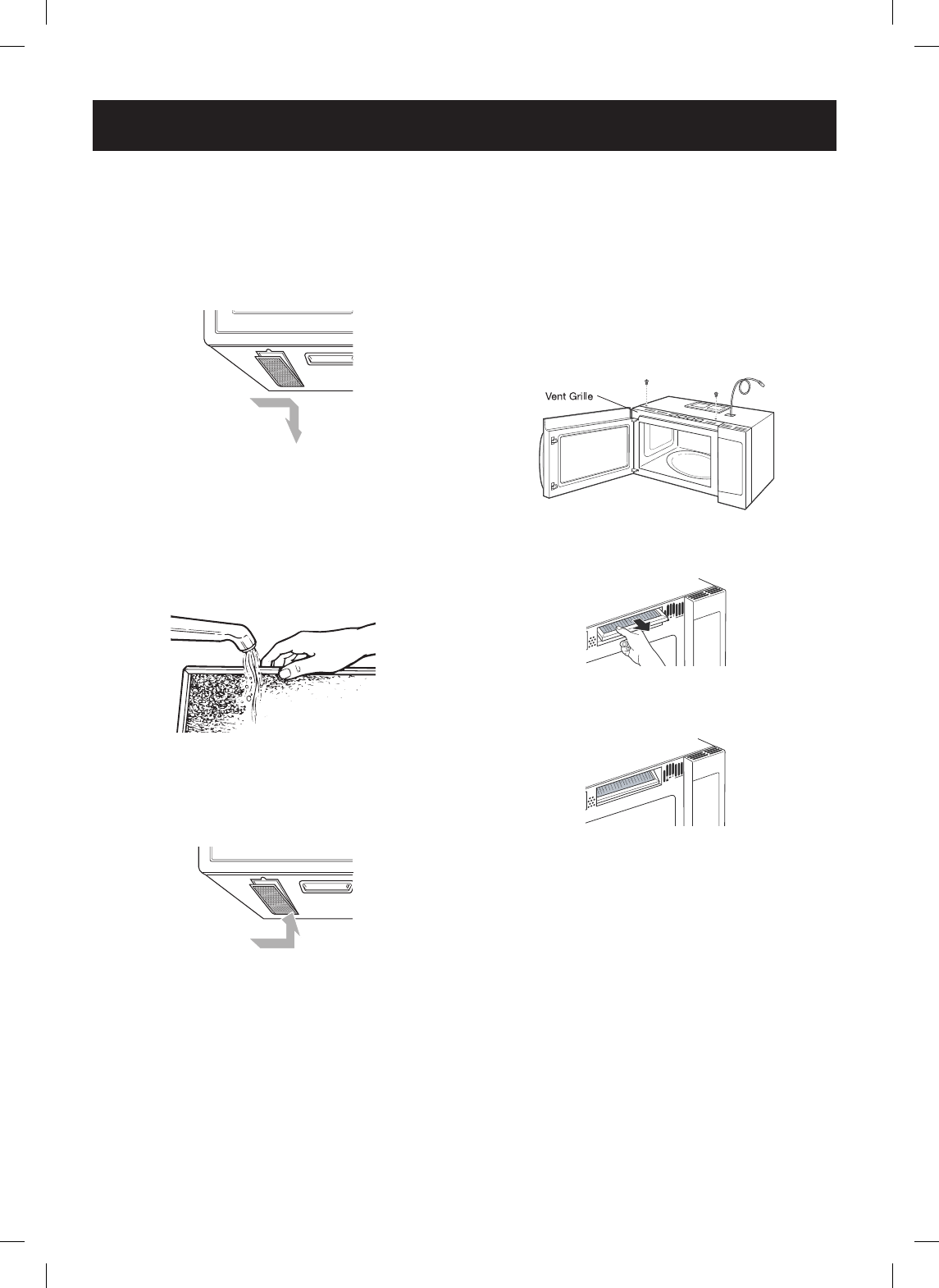
- 42 -
CLEANING THE GREASE
FILTERS
1. Unplug the microwave oven.
2.
To remove grease lters, slide each lter to the side.
Pull lters downward and push to the other side. The
lter will drop out.
3.
Soak grease lters in hot water and a mild detergent.
Scrub and swish to remove embedded dirt and
grease. Rinse well and shake to dry. Do not clean
lters with ammonia, corrosive cleaning agents
such as lye-based oven cleaners, or place them
in a dishwasher. The lters will turn black or
could be damaged.
4.
To replace grease lters, slide lter in the frame slot
on one side of the opening. Push lter upward and
push to the other side to lock into place.
5. Plug in the microwave oven.
CHARCOAL FILTER
REPLACEMENT
If the oven is vented inside, the charcoal lter should
be replaced every 6 to 12 months, and more often
if necessary. The charcoal lter cannot be cleaned.
To order a new charcoal lter, contact the Parts
Department at your nearest Authorized Service Center.
1. Unplug the microwave oven.
2. Remove the vent grille mounting screws.
3. Tip the grille forward, then lift out to remove.
4. Remove the charcoal lter
5.
Slide a new charcoal lter into place.
The lter should rest at the angle shown.
6. Slide the bottom of the vent grille into place.
Push the top until it snaps into place.
Replace the mounting screws.
7. Plug in the microwave oven.
MAINTENANCE
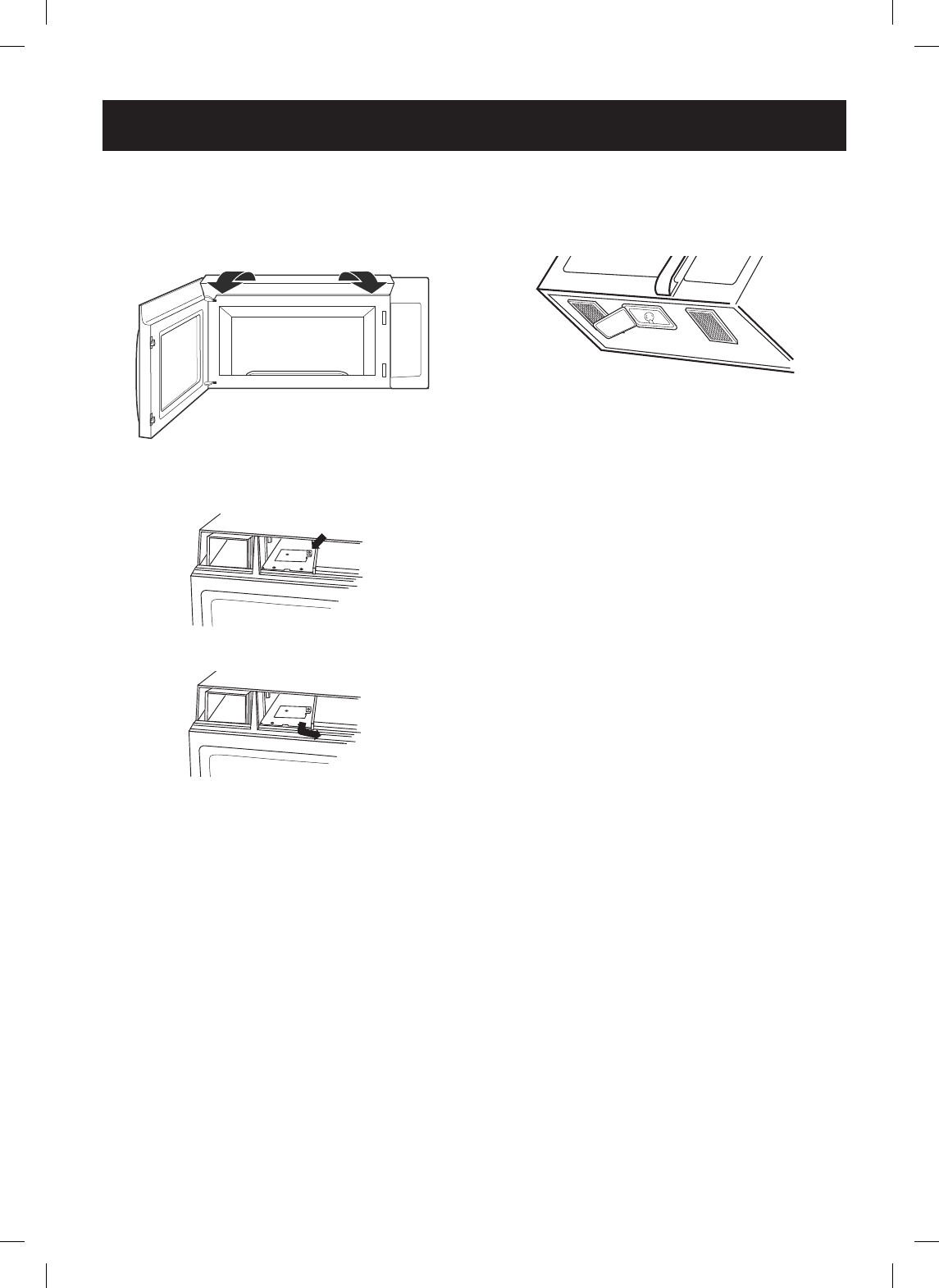
- 43 -
MAINTENANCE
OVEN LIGHT REPLACEMENT
1. Unplug the microwave oven.
2. Remove the vent grille mounting screws.
3. Tip the grille forward, then lift out to remove.
4. Remove charcoal lter.
5. Remove the screw holding the lamp shield in place.
6. Pull the lamp shield out.
7. Replace the bulb with a candelabra-base 50 watt
bulb.
8.
Return the lamp and lamp shield to original position
and replace screw and charcoal lter.
9.
Replace the mounting screws.
10. Plug in the microwave oven.
COOKTOP/COUNTERTOP LIGHT
REPLACEMENT
1. Unplug the microwave oven.
2. Remove the bulb cover mounting screws.
3. Replace bulb(s) with candelabra-base 50 watt bulb.
4. Replace bulb cover and mounting screw.
5. Plug in the microwave oven.

- 44 -
MICROWAVE UTENSIL GUIDE
USE DO NOT USE
OVENPROOF GLASS
(treated for high intensity heat):
utility dishes, loaf dishes, pie plates, cake
plates, liquid measuring cups, casseroles
and bowls without metallic trim.
CHINA:
bowls, cups, serving plates, and platters
without metallic trim.
PLASTIC:
Plastic wrap (as a cover)- lay the plastic
wrap loosely over the dish and press it to
the sides.
Vent plastic wrap by turning back one
edge slightly to allow excess steam to
escape. The dish should be deep enough
so that the plastic wrap will not touch the
food. As the food heats it may melt the
plastic wrap wherever the wrap touches
the food.
Use plastic dishes, cups, semi-rigid freezer
containers and plastic bags only for
short cooking time. Use these with care
because the plastic may soften from
the heat of the food.
PAPER:
Paper towels, waxed paper, paper
napkins, and paper plates with no metallic
trim or design. Look for the manufacturer's
label for use in the microwave oven.
Note:
Do not use recycled paper products in the
microwave oven. They sometimes contain
impurities that cause arcing and sparking.
NEVER use paper products in the
convection oven.
METAL UTENSILS:
Metal shields the food from microwave energy and produces
uneven cooking. Also avoid metal skewers, thermometers, or foil
trays. Metal utensils can cause arcing, which can damage the
microwave oven.
METAL DECORATION:
Metal-trimmed or metal-banded dinnerware, casserole dishes,
etc. The metal trim interferes with normal cooking and may
damage the oven.
ALUMINUM FOIL:
Avoid large sheets of aluminum foil because they hinder cooking
and may cause harmful arcing. Use small pieces of foil to shield
poultry legs and wings. Keep ALL aluminum foil at least 1 inch
from the side walls and door of the oven.
WOOD:
Wooden bowls and boards will dry out and may split or crack
when you use them in the microwave oven. Baskets react in the
same way.
TIGHTLY COVERED UTENSILS:
Be sure to leave openings for steam to escape from covered
utensils. Pierce plastic pouches of vegetables or other food items
before cooking. Tightly closed pouches could explode.
BROWN PAPER:
Avoid using brown paper bags.
They absorb too much heat and could burn.
FLAWED OR CHIPPED UTENSILS:
Any utensil that is cracked, awed, or chipped may break in the
oven.
METAL TWIST TIES:
Remove metal twist ties from plastic or paper bags.
They become hot and could cause a re.
MAINTENANCE

- 45 -
BEFORE CALLING FOR SERVICE
Check the following list to be sure a service call is
really necessary. A quick reference of this manual as
well as reviewing additional information on items to
check may prevent an unneeded service call.
If nothing on the oven operates:
• check for a blown circuit fuse or a tripped main circuit
breaker.
• check if oven is properly connected to electric circuit
in house.
• check that controls are set properly.
If the oven interior light does not work
• the light bulb is loose or defective.
If oven will not cook:
• check that control panel was programmed correctly.
• check that door is rmly closed.
• check that Start was pressed.
•
check that timer wasn’t started instead of a cook function.
If oven takes longer than normal to cook or cooks
too rapidly:
• be sure the Power Level is programmed properly.
If the time of day clock does not always keep
correct time:
• check that the power cord is fully inserted into the
outlet receptacle.
• be sure the oven is the only appliance on the
electrical circuit.
If food cooks unevenly:
• be sure food is evenly shaped.
• be sure food is completely defrosted before cooking.
• check placement of aluminum foil strips used to
prevent overcooking.
If food is undercooked:
• check recipe to be sure all directions (amount, time,
and power levels) were correctly followed.
• be sure microwave oven is on a separate circuit.
• be sure food is completely defrosted before cooking.
If food is overcooked:
• check recipe to be sure all directions (amount, power
level, time, size of dish) were followed.
If arcing (sparks) occur:
• be sure microwavable dishes were used.
• be sure wire twist ties weren’t used.
• be sure oven wasn’t operated when empty.
• make sure metal rack (if used) is properly installed on
4 supports.
If the display shows a time counting down but the
oven is not cooking:
• check that door is rmly closed.
• check that timer wasn’t started instead of a cooking
function.
FREQUENTLY ASKED QUESTIONS
Q. Can I use a rack in my microwave oven to reheat
or cook on two levels at once?
A. Only use the rack that is supplied with your
microwave oven. Use of any other rack can result
in poor cooking performance and/or arcing and may
damage your oven.
Q. Can I use either metal or aluminum pans in my
microwave oven?
A. Usable metal includes aluminum foil for shielding
(use small, at pieces), and shallow foil trays (if
tray is ¾ inch deep and lled with food to absorb
microwave energy). Never allow metal to touch walls
or door.
Q. Sometimes the door of my microwave oven
appears wavy. Is this normal?
A. This appearance is normal and does not affect the
operation of your oven.
Q. The glass tray does not move.
A. The glass tray is not correctly in place. It should be
correct-side up and sitting rmly on the center hub.
The support is not operating correctly. Remove the
glass tray and restart the oven. Cooking without
the glass tray can give you poor results.
Q. Why does the dish become hot when I
microwave food in it? I thought that this should
not happen.
A. As the food becomes hot it will conduct the heat to
the dish. Use hot pads to remove food after cooking.
Q. What does standing time mean?
A. Standing time means that food should be taken
out of the oven and covered for additional time after
cooking. This process allows the cooking to nish,
saves energy, and frees the oven for other purposes.
Q. Can I pop popcorn in my microwave oven?
How do I get the best results?
A. Yes. Pop packaged microwave popcorn following
manufacturer’s guidelines or use the preprogrammed
Popcorn key.
Do not use regular paper bags. Use the listening test
by stopping the oven as soon as the popping slows
to a pop every one or two seconds. Do not try to
repop unpopped kernels. You can also use special
microwave poppers. When using a popper, be sure
to follow manufacturer’s directions. Do not pop
popcorn in glass utensils.
Q. Why does steam come out of the air exhaust
vent?
A. Steam is normally produced during cooking. The
microwave oven has been designed to vent steam
out of the top vent.
TROUBLESHOOTING
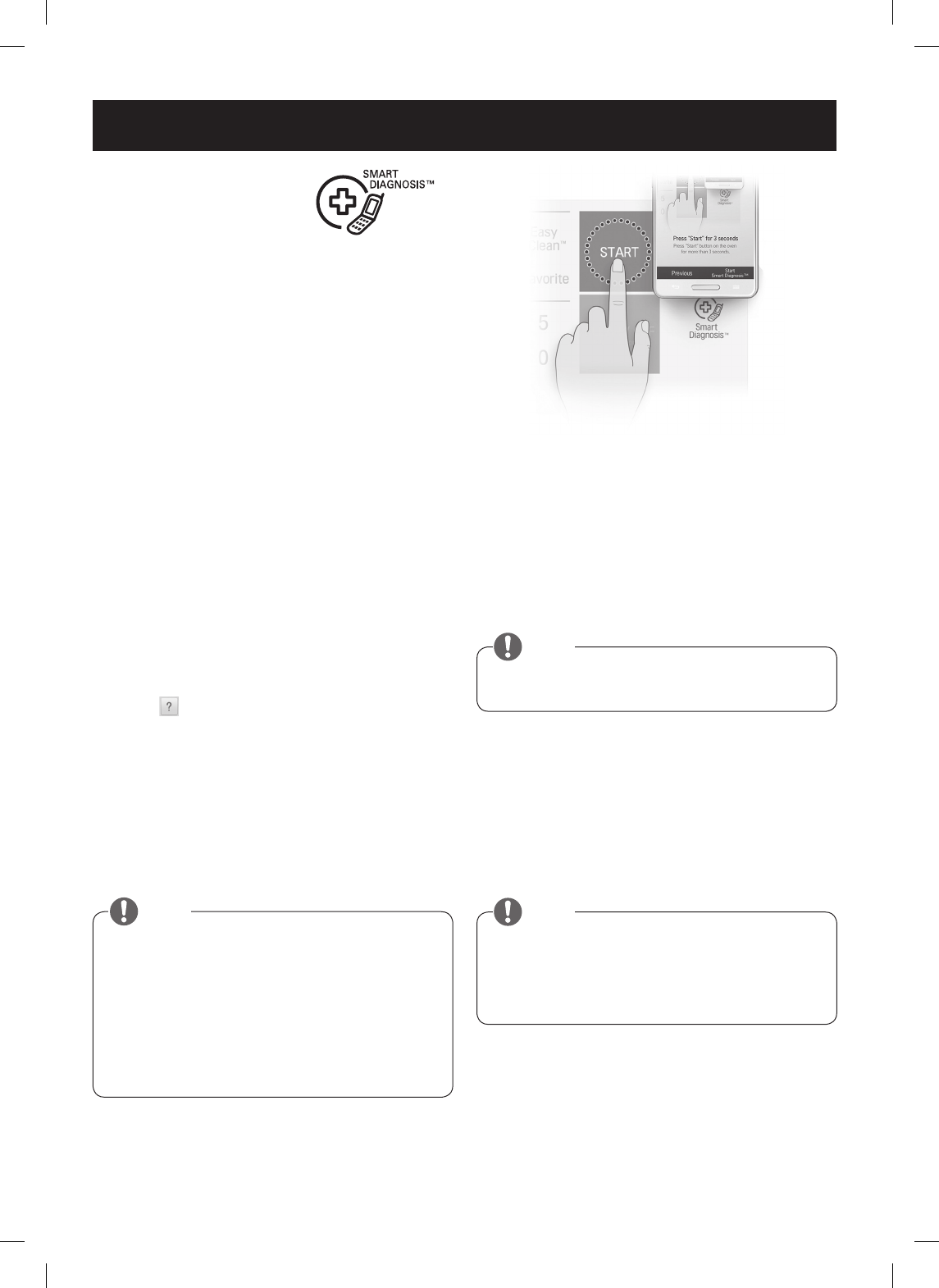
- 46 -
SMART DIAGNOSIS
Should you experience any problems with your
microwave oven, it has the capability of transmitting
data to your smart phone using the SmartThinQ
Application or via your telephone to the SIGNATURE
KITCHEN SUITE call center.
Smart Diagnosis™ cannot be activated unless your
microwave oven is turned on. If your microwave oven
is unable to turn on, then troubleshooting must be
done without using Smart Diagnosis™.
USING SMART DIAGNOSIS™
SMART DIAGNOSIS™ USING YOUR
SMART PHONE
1. Download the SmartThinQ application on your smart
phone.
2. Open the SmartThinQ application on your smart
phone. Press the Smart Diagnosis™ button to
advance to the next screen.
3. Follow the directions in the application.
Using ‘Tag on’ is recommended but, if it does not
work well, the application will show how to use
Audible Diagnosis.
4. Press [ ] in the SmartThinQ app for a more
detailed guide on how to use the Tag On function.
SMART DIAGNOSIS™ THROUGH THE
CALL CENTER
1. Call the call center at: 1-855-790-6655.
2. When instructed to do so by the call center agent,
hold the mouthpiece of your phone over the Smart
Diagnosis™ logo on the machine.
Hold the phone no more than one inch from (but not
touching) the machine.
3. Press and hold the Start button for three seconds.
4. Keep the phone in place until the tone transmission
has nished. The display will count down the time.
5. Once the countdown is over and the tones have
stopped, resume your conversation with the call
center agent, who will then be able to assist you in
using the information transmitted for analysis.
SMART DIAGNOSIS
NOTE
NOTE
NOTE
• Call quality differences by region may affect the
function.
• Use the home telephone for better
communication performance, resulting in better
service.
• Bad call quality may result in poor data
transmission from your phone to the machine,
which could cause Smart Diagnosis™ to
malfunction.
Do not touch any other buttons or icons on the
display screen.
• For best results, do not move the phone while
the tones are being transmitted.
• If the call center agent is not able to get an
accurate recording of the data, you may be
asked to try again.

MEMO

MEMO

SIGNATURE KITCHEN SUITE MICROWAVE OVEN LIMITED WARRANTY-USA
Model UPMC3084ST
SIGNATURE KITCHEN SUITE will repair or replace your product, at SIGNATURE KITCHEN SUITE'S option,
if it proves to be defective in material or workmanship under normal use, during the warranty period set forth
below, effective from the date of original consumer purchase of the product. This warranty is good only to the
original purchaser of the product and effective only when used in the United States, including U.S Territories.
WARRANTY PERIOD:
LABOR: Three Years from the Date of Purchase*.
PAR TS(except as listed below): Three Years from
the Date of Purchase*.
MAG NETRON: Ten Years from the Date of
Purchase*.
Replacement Units and Repair Parts are warranted
for the remaining portion of the original unit's warranty
period.
* Retain your Sales Receipt to prove the date of
purchase. A copy of your Sales Receipt must be
submitted at the time warranty service is provided.
HOW SERVICE IS HANDLED:
Please call 1-855-790-6655 and choose the
appropriate option. (Phones are answered 24 hours
a day, 365 days per year.) Please have the product
type (Microwave) and your ZIP code ready.
Or visit our website at: www.thesignaturekitchen.com
THIS WARRANTY IS IN LIEU OF ANY OTHER WARRANTY, EXPRESS OR IMPLIED, INCLUDING WITHOUT
LIMITATION, ANY WARRANTY OF MERCHANTABILIYT OR FITNESS FOR A PARTICULAR PURPOSE. TO THE
EXTENT ANY IMPLIED WARRANTY IS REQUIRED BY LAW, IT IS LIMITED IN DURATION TO THE EXPRESS
WARRANTY PERIOD ABOVE. SIGNATURE KITCHEN SUITE WILL NOT BE LIABLE FOR ANY INCIDENTAL,
CONSEQUENTIAL, INDIRECT, SPECIAL, OR PUNITIVE DAMAGES OF ANY NATURE, INCLUDING WITHOUT
LIMITATION, LOST REVENUES OR PROFITS, OR ANY OTHER DAMAGE WHETHER BASED IN CONTRACT,
TORT, OR OTHERWISE. Some states do not allow the exclusion or limitation of incidental or consequential
damages or limitations on how long an implied warranty lasts, so the above exclusion or limitation may nto apply
to yor. This warranty gives you specic legal rights and yor may also have other rights that vary from state to state.
THIS LIMITED WARRANTY DOES NOT APPLY TO:
● Service trips to your home to deliver, pick up, and/or install the product, instruct, or replace house fuses or
correct wiring, or correction of unauthorized repairs.
● Damages or operating problems that result from misuse, abuse, operation outside environmental specications
or contrary to the requirements of precautions in the Operating Guide, accident, vermin, re, ood, improper
installation, acts of God, unauthorized modication or alteration, incorrect electrical current or voltage, or
commercial use, or use for other than intended purpose.
The cost of repair or replacement under these excluded circumstances shall be borne by the consumer.
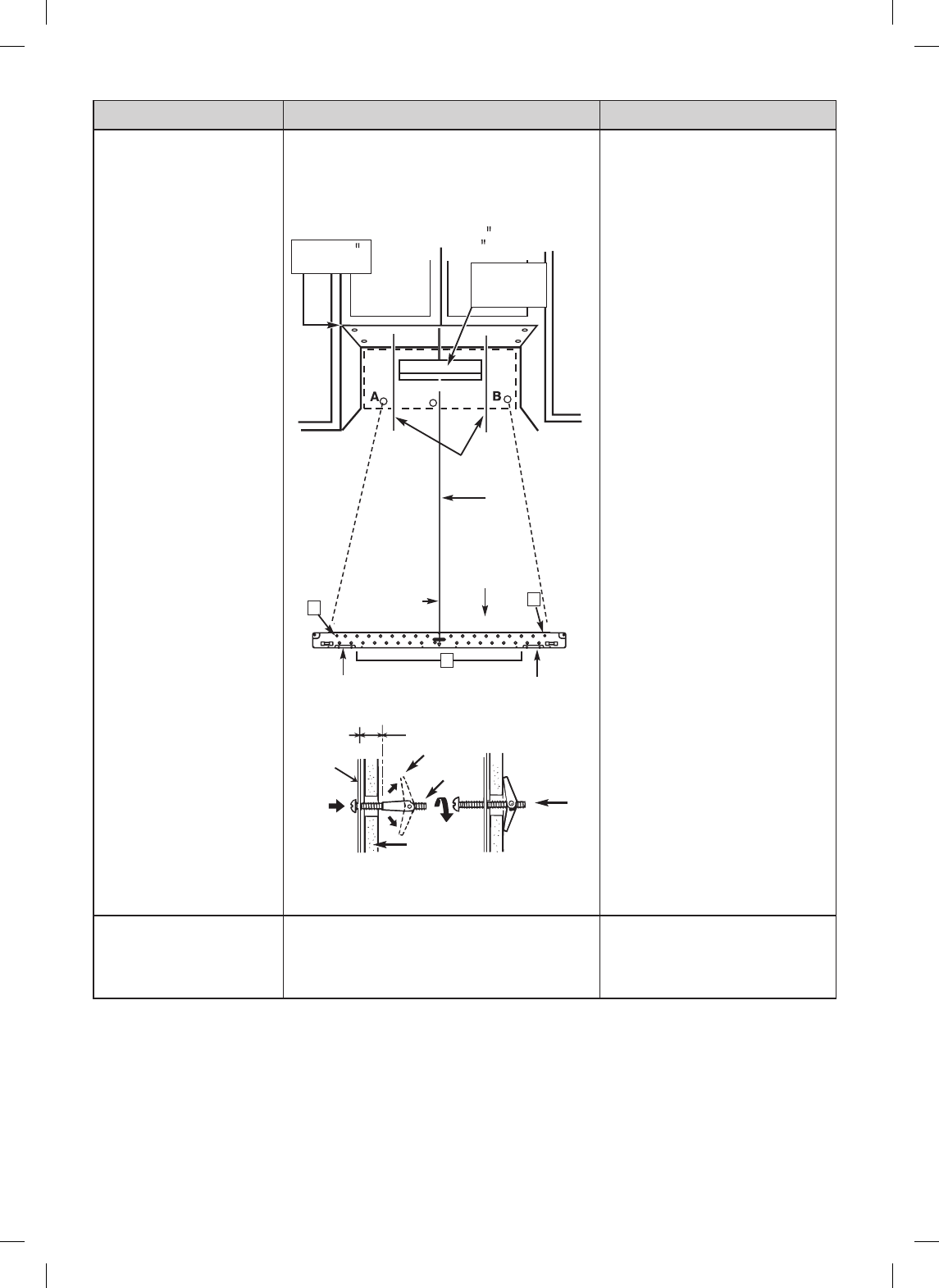
Problem Cause Solution
Microwave oven
Installation issue
- Vibration noise
- Unit is not level
- Installation damage
1. Mounting bracket screw not xed
completely
2. Mounting plate not aligned
Check with installer rst
C
B
A
Wall
Mounting
Plate
Space More Than Wall Thickness
Bolt
En
d
Toggle Bolt
Toggle Wings1
3/16 Hole on Studs
5/8 Hole on Drywall Only
Minimum 66
From the Floor
For Wall -
Venting Only
Draw Lines
on Studs
Draw
Center Line
Center Line
Mounting Plate
Support Tab Support Tab
3. Product carried/installed improperly
Spark / Arcing Aluminum foil or metal utensil used in
microwave mode
DO NOT use aluminum foil or
metal utensils in microwave mode
- Check user instructions
The cost of repair or replacement under these excluded circumstances shall be borne by the consumer.
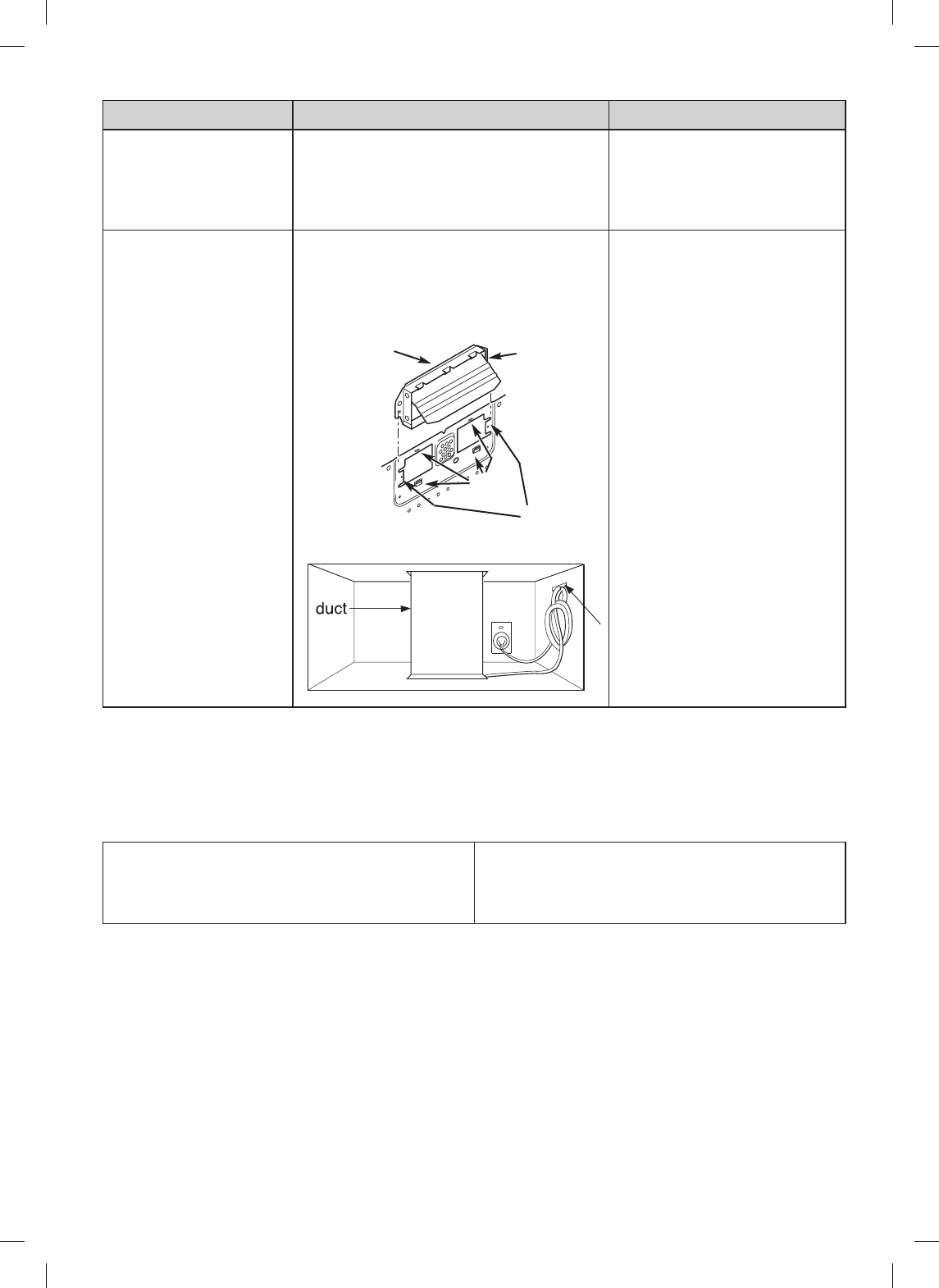
Problem Cause Solution
Unit has no power 1. House power turned off (power supply)
2. Tripped breaker
3. The power cord is not installed properly
1. Check house power supply
2. Check proper power cord
connection
3. Check extension cord
Vent is not working
- Weak or no ventilation
- Abnormal noise during
operation
- Product overheating
1. Improper blower unit direction or installation
2. Improper ductwork or damper connection
1. Check blower unit direction and
reinstall if necessary.
2. Properly align the exhaust
ports and blower plate opening.
Slide exhaust
adapter into
guides on
rear panel.
Exhaust Adapter Damper
(hinge side up)
Locking
Tabs
Guides
3. Blower unit exhaust ports
should be completely exposed
to the outside
4. After installation, check the air
ventilation path
The cost of repair or replacement under these excluded circumstances shall be borne by the consumer.
CUSTOMER INTERACTIVE CENTER NUMBERS
To obtain Customer Assistance, Product Infor-
mation, or Dealer or Authorized Service Center
location:
Call 1-855-790-6655
(24 hours a day, 365 days per
year) and select the appropriate option from the menu.
Or visit our website at:
www.thesignaturekitchen.com
TO CONTACT SIGNATURE KITCHEN SUITE BY MAIL:
SIGNATURE KITCHEN SUITE Customer Interactive Center
P. O. Box 240007
201 James Record Road
Huntsville, Alabama 35824
ATTN: CIC

Customer Information Center
For inquires or comments, call;
1-855-790-6655 USA